Apr 2013
Changing Times
30/04/13 05:32
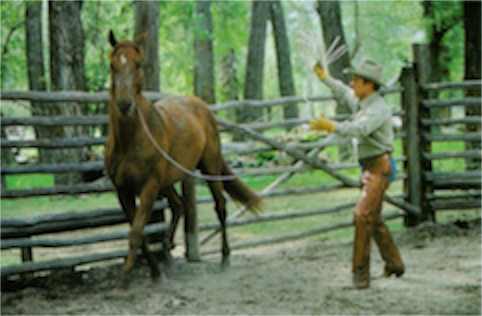
Our friend fit right into the dude ranching operation. He stripped to the waist wearing a pair of homemade buckskin pants, added home made “war paint,” and rode through columns of tourists to provide a bit of a scare and a story for them to tell when they got home. He spent his summers sleeping in tents and homemade shelters and living off of the land, eating fish mostly, but also trapping small animals and learning all of the best berry patches in the mountains. In the fall he was the first to fill out his deer and elk tags. He was one of the youngest persons we knew who had shot a bear, though he had a decade on the legend of Davy Crockett.
When people talked about him there was a bit of admiration in their stories. “Wouldn’t it be neat to be able to live independently – to have the skills to just live off of the land with no rules, no schedule, no being dependent on someone else?” But there was also a bit of sadness to their tales. We knew that the way of life represented by the mountain man belonged to the past. The economy didn’t really have room for someone who didn’t pay taxes, who didn’t play by the rules and whose way of life depended on living off of land that belonged to someone else. The sheepherders were already looking for alternatives to grazing their animals in the high country. The days of inexpensive leases on National Forest land were past. If you had the right set of skills, you could go back into the mountains, but if you built a cabin, the authorities would come and tear it down. Hunting and fishing required licenses. Cutting trees required permits. The economy operated on cash and Pacific Hide and Fur didn’t pay enough for deerskin with a few otter and beaver pelts thrown in for a guy to afford a bottle of whiskey from time to time.
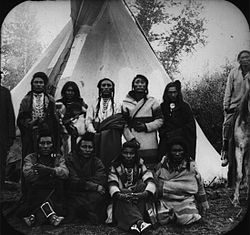
Seth Kanter grew up in what was called “The Last Frontier” a decade or so after I grew up in Montana. He struggled with how to make a life in a place where his parents were first generation settlers. He grew up in the midst of a “back to the land” movement while the natives were rushing to move into towns, obtain technologies such as refrigerators and snowmobiles and indoor plumbing. He described himself and his native friends as “the children of changing times on a frontier falling apart.” He put words to thoughts that might have been shared with others who grew up in an empty land that now has become crowded. “Living off the land, how did it drip away? How could the cash and computers, the canned food and machines, have taken so much, left so little . . . The old life has vanished.”

Times have changed. Blue jeans and even cowboy boots are imported from China. You pick up the phone and you might end up talking to someone in India or Brazil who is trying to sell you something. Life doesn’t stand still. The old ways are passing. We have trouble imagining the future that is emerging.
Who knows, maybe we all were born a century too late. Maybe the pace of change is so rapid these days that none of us are able to keep up. For now, I’m glad that the weather is warming up and spring is coming. Sometimes I need to just go work in my garden or sit on my porch and let the rest of the world go by. I have no intention of keeping up, but I know that the first taste of a garden tomato is a timeless pleasure and the world won’t stop if I light a charcoal fire and cook my supper in the back yard while I wait for the garden to grow.
Copyright © 2013 by Ted Huffman. I wrote this. If you want to copy it, please ask for permission. There is a contact me button at the bottom of this page. If you want to share my blog a friend, please direct your friend to my web site.
The gift of music
29/04/13 05:28
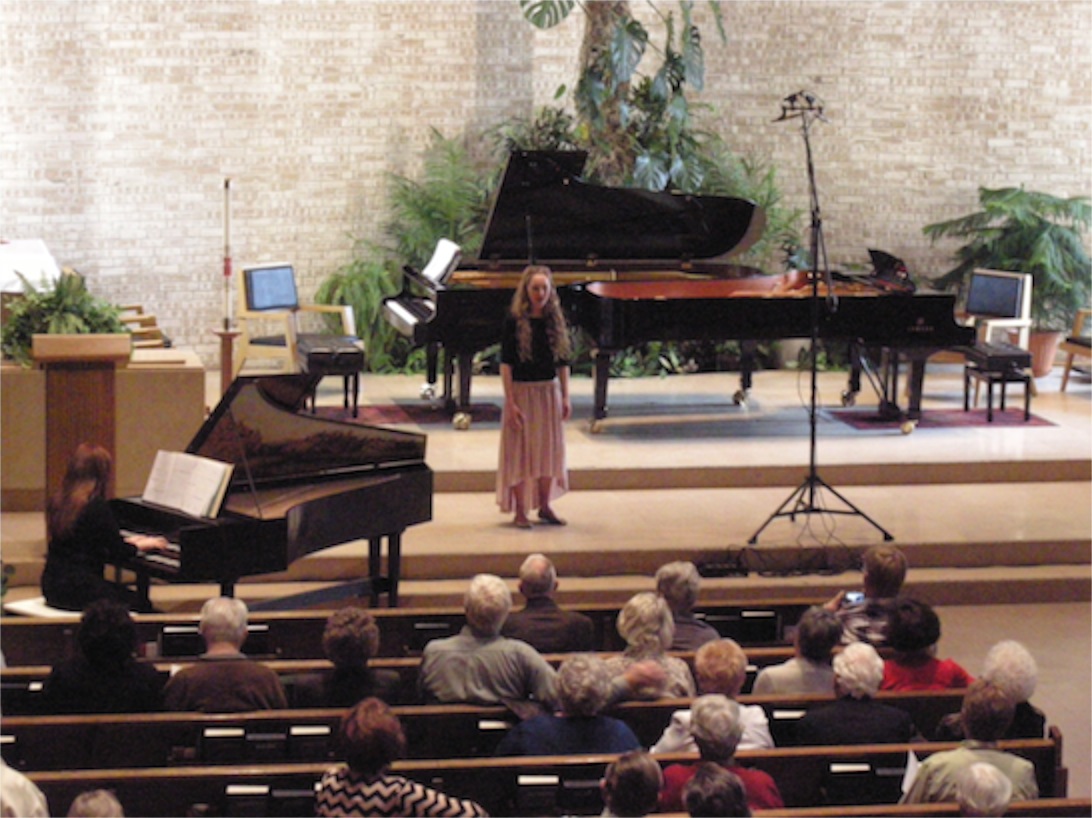
There are a couple of times in the Gospels when Jesus’ attitude towards money surprises us. The underlying theme is that Jesus isn’t very concerned with money. He demonstrates no desire to accumulate wealth of any kind. He seems to be unaffected by wealth or poverty in choosing the people that he serves. He is constantly reminding his disciples through his parables that money doesn’t buy happiness. We hear the parable of the rich fool (Luke 12:13-21) and know that storing up financial assets is of no spiritual value. We learn the lesson of the widow’s mite (Mark 12:41-44; Luke 21:1-4) and realize that the value of a gift does not lie in its purchasing power.
Some of the most successful projects in the church are the ones that don’t revolve around money. I’ve often written of the Woodchuck Society at our church. Its financial principles are simple: no budget, no fund-raising events, no meetings. What the group has is donated by generous individuals. What they don’t have are things they can get along without. The group has been the recipient of amazing generosity, but has never asked beyond letting people know when work days occur and occasionally letting the congregation know of a specific need such ask asking to borrow a trailer. And the ministry works amazingly well. Over 50 cords of firewood delivered each year. Thousands of volunteer hours coordinated without a fuss. It is the kind of ministry that inspires me each time that I think of it.
Our operating budget at the church, however, while based in similar principles, requires a bit more focus. Our founding idea is the same. We believe that we are able to run our church with the free will donations of our members. What they give we will invest in ministry. What they do not give we will do without. For the most part this works. We don’t borrow money to operate our church. We do our business with balanced budgets. But managing an annual budget of a little over $309,000 requires some thought and planning. Some reserves need to be kept for unforeseen occurrences. We are never sure what is a reasonable level of cash to hold back in anticipation. There are different opinions on where and how the money should be spent.
For the most part, we agree that we exist to serve others and that we need to always have mission as a high priority. People don’t give to a church to have their money sit in the bank. And most people give to the church in order to do some good and serve other people. We tolerate necessary expenses such as utilities, building maintenance and salaries because they support our outreach ministries.
One of the areas of our life together where we proceed with some caution and uncertainty is the area of art. Churches have long been patrons of the arts and have been repositories of artwork that is very valuable. In many cases, churches are the place for art that is beyond the means of an individual collector. The Sistine Chapel ceiling, the Salt Lake Tabernacle, and the Cathédrale Notre Dame de Paris are examples of art and architecture that are literally priceless not because they do not require money, but because their value exceeds the ability to estimate how much money it would take to replace them.
There have been corners of the church where all art is seen as an extravagance and a certain austerity is seen as a mark of faith. Some congregations have gone so far as to adopt rigid dress codes and others have banned music entirely. Our family of faith doesn’t fall into either category. We have a relatively clean space with a minimum of ornamentation, but we do like music. And we do support visual artists.
Yesterday I sat in the balcony of our sanctuary and listened as sisters Michelle and Kimberly Cann performed on two 9’ concert grand pianos. The concert was riveting. The music was stirring. It pointed our attention to things well beyond the present. The experience is difficult to describe with mere words. As I listened, I was aware, however, of what a luxury we have in that space. The room features an acoustical space and instruments that are not common in churches.
I remember working and planning and saving in order to purchase a new piano for the sanctuary of the church we served in Hettinger, North Dakota. I think that the piano cost about $3,000. My memory is foggy and the price may not be exact. We were so excited when it was delivered and tuned. It added a new dimension to our worship and provided an instrument to accompany not only congregational singing but also vocal solos. That piano still serves the community even though the church is no longer functioning as an active congregation. It frequently accompanies soloists at funerals and occasionally at weddings.
But yesterday I sat with my back to the 35 ranks of pipes in our beautiful organ that inspires us weekly. I was sitting next to our 1904 Baldwin grand piano that accompanies our choir. The instrument went through an extensive rebuild in 1998 and is a very sweet piano. From the balcony I could see two 9’ concert grand pianos. One belongs to our community. The Black Hills Touring Concert Piano was made possible by the generosity of a benefactor. It can be used for concerts for a moving fee. This is the second time that piano has been in our sanctuary. It was nestled with our own Blüthner 9’2” concert grand. Nearby sat the two manual harpsichord that is shared by the Black Hills Chamber Music Society and our church. That is three pianos, a harpsichord and an organ in the same room. And only one of those instruments finds its regular home in another place. The room justifies the instruments. The music filled the room and the audience was truly inspired.
But I am well aware that they are an extravagance. One of those concert grand pianos could be sold and the funds used to build a Habitat for Humanity home. The organ has little cash value if sold, but its replacement cost rivals the cost of the rest of the building.
There are extravagances in the Gospels. Jesus’ anointing at Bethany was criticized: “This perfume could have been sold at a high price and the money given to the poor.” (Matthew 26:9). The story is repeated in John 12. There are times when faith is more important than money.
I don’t know whether or not we have achieved the right balance. It is worth careful thought. But as I listened yesterday, I allowed my mind to forget money and cost. I reveled in the power of the music and delighted in the joy of the audience. There is no way to put a monetary value on that experience.
Because we have been blessed with the gifts that made these instruments possible, it becomes our responsibility to offer gifts of music to our community. Such music is simply too good to keep to yourself. It too is an avenue of service.
Copyright © 2013 by Ted Huffman. I wrote this. If you want to copy it, please ask for permission. There is a contact me button at the bottom of this page. If you want to share my blog a friend, please direct your friend to my web site.
They will keep running
28/04/13 05:26
We were with friends last evening remembering the life of a wonderful woman who lived to the age of 93, had a marvelous attitude, an accurate memory, a zest for life, a love for others, and an ability to let go of the past and get on with the present. More than a few of us expressed our admiration for her and a desire to be like her as we moved into our aging years. In the midst of the storytelling, there was a bit of catching up on other family members and friends of friends who were not able to attend the gathering. I heard the story of granddaughter of the woman we were remembering, daughter of friends of ours whom we haven’t seen in many years. She was just a child when we last saw her. Now she is a mother with young boys and a busy life. She is also a runner and she finished the Boston Marathon, with her husband and sons waiting at the finish line just a few minutes before the bombs exploded – early enough that they had walked away from the blast site before the bombs went off.
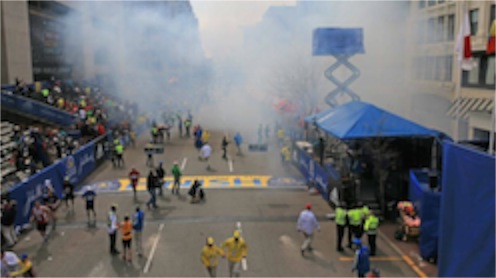 There was a twinge in my stomach as I heard the story. Boston seems a long way away and the marathon bombs seemed to be about something that happened to someone else. Then, all of a sudden, here was someone I knew who had been there, whose children could easily have been the victims had the timing been a bit different. I had a name and a connection to the events.
There was a twinge in my stomach as I heard the story. Boston seems a long way away and the marathon bombs seemed to be about something that happened to someone else. Then, all of a sudden, here was someone I knew who had been there, whose children could easily have been the victims had the timing been a bit different. I had a name and a connection to the events.
Even though the child was not the child of my friends, even though I did not know any of the relatives, the reality is that the eight-year-old child, killed in a peaceful gathering of civilians did die. He was the child of those who loved him. He was the child of parents who had friends. There were those who thought they were removed from the events of the day who woke up the next day to find themselves intimately connected.
It is only one reason why the act of placing a bomb in such a place is such an inexcusable act. The victims bear no relation to the “causes.” They have no power to effect political changes. The act of placing the bomb does not accomplish anything. It only kills, maims, and leaves innocents with broken bodies and broken hearts.
It is not the act of a rational mind.
I suppose that it is possible that we will never have a full understanding of the dynamics that led to that day. It appears that the mastermind of the attacks is now dead. His brother may have information that will help investigators understand the crime better. There may be things we can learn that will help prevent similar attacks in the future. The careful crime work by the Boston Police, the FBI, the ATF and others is important and must be pursued. But in the end, and unthinkable act leaves us without the capacity to understand.
There are far too many examples of where senseless violence has given rise to more senseless violence. In grief and anger people strike out in irrational ways and the violence escalates as the number of innocent victims rises. In Northern Ireland, in central Africa, in the Middle East, in place after place around our globe the bombers practice their imprecise craft not because it makes sense or because it will accomplish definable goals, but simply as an expression of hatred and anger.
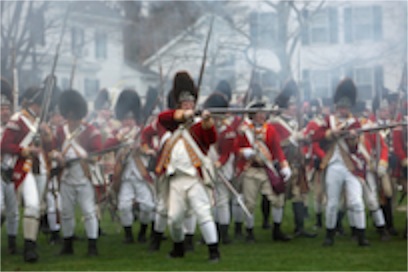 The Boston Marathon is run on Patriots’ Day. The day is not a national holiday, but is observed in Massachusetts, Maine and Wisconsin as a civic holiday commemorating the anniversary of the Battles of Lexington and Concord on April 19, 1775. These were the first battles of the American Revolutionary War. The day is now observed on the Third Monday of April. Observances include re-enactments of the battles. What is more difficult to imagine, in our contemporary setting, are the dynamics that led to the battles. The rebel leaders were less organized than we like to remember and many of them were motivated by visions of personal gain. There were those who were simply opposed to everything British and who were as slow to offer fair solutions as they were quick to point out the problems of British ideas to balance the budget.
The Boston Marathon is run on Patriots’ Day. The day is not a national holiday, but is observed in Massachusetts, Maine and Wisconsin as a civic holiday commemorating the anniversary of the Battles of Lexington and Concord on April 19, 1775. These were the first battles of the American Revolutionary War. The day is now observed on the Third Monday of April. Observances include re-enactments of the battles. What is more difficult to imagine, in our contemporary setting, are the dynamics that led to the battles. The rebel leaders were less organized than we like to remember and many of them were motivated by visions of personal gain. There were those who were simply opposed to everything British and who were as slow to offer fair solutions as they were quick to point out the problems of British ideas to balance the budget.
The first battles of the revolution were probably started prematurely – at least from the perspective of those who took a more measured and careful approach to the process of political change. The impromptu militia that was organized in Boston that night – the one that confronted the British force heading toward Lexington and Concord – was probably more fueled by alcohol than by a disciplined approach to political change.
They say that history is written by the victors. The stories we know of the American Revolution would be different had the military battles had different outcomes. It seems quite possible that there were some good leaders among the British. Nathaniel Philbrick in his book “Bunker Hill” is sympathetic to British commander Thomas Gage: “While Gage had honored the civil liberties of the patriots, the patriots had refused to respect the rights of those with whom they did not agree.” But this perspective is not the one that we have been taught. We have forgotten the business gains and amassed wealth of those who reused to pay taxes. We have forgotten that those who suffered and died were not the politicians who seemed to develop an art of staying in locations that were distant from risk.
In our day, those who plant bombs and terror are relegating their ideas to the refuse heap of history. They will not succeed and by their choice of cowardly weapons they are assuring that they will not be heard. History will likely not remember them at all and if it does, the memory will not be kind.
Next year, on Patriots’ Day, the Boston Marathon will be run. The runners will be everyday people – the people that you and I know. The crowd will be larger and the gathering will be peaceful. The memory of the terror will become more distant with each running of the race. And the story we will tell in years to come is of how people with bombs failed to stop the running.

Even though the child was not the child of my friends, even though I did not know any of the relatives, the reality is that the eight-year-old child, killed in a peaceful gathering of civilians did die. He was the child of those who loved him. He was the child of parents who had friends. There were those who thought they were removed from the events of the day who woke up the next day to find themselves intimately connected.
It is only one reason why the act of placing a bomb in such a place is such an inexcusable act. The victims bear no relation to the “causes.” They have no power to effect political changes. The act of placing the bomb does not accomplish anything. It only kills, maims, and leaves innocents with broken bodies and broken hearts.
It is not the act of a rational mind.
I suppose that it is possible that we will never have a full understanding of the dynamics that led to that day. It appears that the mastermind of the attacks is now dead. His brother may have information that will help investigators understand the crime better. There may be things we can learn that will help prevent similar attacks in the future. The careful crime work by the Boston Police, the FBI, the ATF and others is important and must be pursued. But in the end, and unthinkable act leaves us without the capacity to understand.
There are far too many examples of where senseless violence has given rise to more senseless violence. In grief and anger people strike out in irrational ways and the violence escalates as the number of innocent victims rises. In Northern Ireland, in central Africa, in the Middle East, in place after place around our globe the bombers practice their imprecise craft not because it makes sense or because it will accomplish definable goals, but simply as an expression of hatred and anger.

The first battles of the revolution were probably started prematurely – at least from the perspective of those who took a more measured and careful approach to the process of political change. The impromptu militia that was organized in Boston that night – the one that confronted the British force heading toward Lexington and Concord – was probably more fueled by alcohol than by a disciplined approach to political change.
They say that history is written by the victors. The stories we know of the American Revolution would be different had the military battles had different outcomes. It seems quite possible that there were some good leaders among the British. Nathaniel Philbrick in his book “Bunker Hill” is sympathetic to British commander Thomas Gage: “While Gage had honored the civil liberties of the patriots, the patriots had refused to respect the rights of those with whom they did not agree.” But this perspective is not the one that we have been taught. We have forgotten the business gains and amassed wealth of those who reused to pay taxes. We have forgotten that those who suffered and died were not the politicians who seemed to develop an art of staying in locations that were distant from risk.
In our day, those who plant bombs and terror are relegating their ideas to the refuse heap of history. They will not succeed and by their choice of cowardly weapons they are assuring that they will not be heard. History will likely not remember them at all and if it does, the memory will not be kind.
Next year, on Patriots’ Day, the Boston Marathon will be run. The runners will be everyday people – the people that you and I know. The crowd will be larger and the gathering will be peaceful. The memory of the terror will become more distant with each running of the race. And the story we will tell in years to come is of how people with bombs failed to stop the running.
Copyright © 2013 by Ted Huffman. I wrote this. If you want to copy it, please ask for permission. There is a contact me button at the bottom of this page. If you want to share my blog a friend, please direct your friend to my web site.
A room full of stories
27/04/13 04:33
There have been several different models for young adult ministries over the years. Before we were married, the church camp where we went experimented with a young adults camp. The camp was designed as a light work camp for the participants to contribute to the operation of the organization combined with some programming. We registered and attended, but the attendance was light. Young adults had busy schedules even back then and taking time off of work was a challenge. The post-high school camp was dropped because it never reached a large enough registration to justify the expenses of planning and staffing the camp. The churches we have served after graduation from seminary all have had stories of times when they had active young adults groups and other times when the groups didn’t meet at all. Of course we ourselves were young adults in the first church that we served and so it was natural for us to gather with other young adults in the community. We formed some significant friendships. We are all older these days and no one is tempted to call us young adults any more.
 The last couple of years have seen a rise in the activities of a group of young adults in our congregation. They usually meet for a meal, though their meetings are not regular. Sometimes they meet on Sundays after church. Other times they meet mid week. Still other times they meet on a Friday or Saturday evening. Often they allow us to tag along even though in most cases we are older than their parents. Last night the group met for supper at a local restaurant and then headed to a CD release party. It turns out that a couple of our young adults are very talented and capable musicians and two young women of the group have released new CDs this year. Both are exceptionally talented and I suspect that music performance will play a big part in their career paths. We might even end up knowing someone famous one day.
The last couple of years have seen a rise in the activities of a group of young adults in our congregation. They usually meet for a meal, though their meetings are not regular. Sometimes they meet on Sundays after church. Other times they meet mid week. Still other times they meet on a Friday or Saturday evening. Often they allow us to tag along even though in most cases we are older than their parents. Last night the group met for supper at a local restaurant and then headed to a CD release party. It turns out that a couple of our young adults are very talented and capable musicians and two young women of the group have released new CDs this year. Both are exceptionally talented and I suspect that music performance will play a big part in their career paths. We might even end up knowing someone famous one day.
 The cultural café at our local art center was full. In fact some of the people who came were turned away when the room reached the capacity allowed by the fire inspectors. The music was delightful and the evening was a real joy. The opening act for the evening was John Craigie. John is a solo traveling folk singer who writes a lot of his own songs. With his brightly painted guitar and harmonicas he presents a fun visual show as well as music that is easy to get into. What makes his act so much fun is that he is a superb storyteller. He entertains with the banter between the songs as much as he does with the songs themselves.
The cultural café at our local art center was full. In fact some of the people who came were turned away when the room reached the capacity allowed by the fire inspectors. The music was delightful and the evening was a real joy. The opening act for the evening was John Craigie. John is a solo traveling folk singer who writes a lot of his own songs. With his brightly painted guitar and harmonicas he presents a fun visual show as well as music that is easy to get into. What makes his act so much fun is that he is a superb storyteller. He entertains with the banter between the songs as much as he does with the songs themselves.
The fun dinner with the young adults, the full house and the great opening act had me in a great mood as Jamie and Dylan set up for their songs. I looked around the room and visited with people I know during the break. I realized that John wasn’t the only story in the room. I found that I know a lot of stories in that room.
Although there were a lot of young people present, across the room from us sat a couple that is about our age that we have known for several years. Our daughters were middle school friends. This couple beat us to retirement. Their daughter has moved overseas and they are forging a lifestyle that supports visiting their daughter and grandchildren as often as possible. Recently they were both actively engaged in demanding professions and, like us, found it difficult to find time to go out for an evening’s entertainment. There were always more demands at the office and busy schedules demanded a fair amount of coordination just to end up at the same place at the same time. We recognize that kind of couple because they are like us. They often arrive in separate vehicles because they are either coming from or going to different places. But last night they were together. Retirement seems to suit them very well. More relaxed, more able to just enjoy the evening, the venue and the entertainment were just right for them to feel young even though, like us, they are grandparents. Theirs is a story worth telling.
I gazed at one of our young adults who will receive her master’s degree in a week. She has discovered what it means to be personally and academically successful. She herself is an accomplished musician with a beautiful singing voice. These days are momentous for her. As she faces the transition from academia to the world of career, there are a lot of different directions in which she could go. She is trying to keep her options open, but she also knows that some of the decisions she will make in the next few months will shape her life and lead her in directions she had not before imagined. She has a story worth telling.
In the room was a man who was in our first youth group when we moved to this town. He has traveled a lot of roads since those days. A stint in the Navy, a frightening battle with cancer, and a couple of false starts in his journey toward adulthood have shaped him into a man with more wisdom than some of his peers. He knows that it takes more than potential to succeed. He knows that life has the grace to allow one to go on after making mistakes. He is aware that there are still some big decisions ahead and that there is more he wants to do. He has a story worth sharing.
And then there is a friend that we met in church camp, even before that young adults camp. After our church camp days, our lives took us in separate directions for more than two decades and then one day we discovered that we lived in the same town. It is so easy to remember our high school camp days that we scarcely recognize ourselves as the gray haired people we now are. Sometimes when we are together it is just like we were back in high school, gathered with friends and guitars and folksongs. But there are gaps in our knowledge of each others’ stories and sometimes we wonder about the things we do not know. There is a story worth telling there as well.
 The room was full. We didn’t know everyone there, though there were certainly a lot of friends in the house. But it was a room of stories. Not all of the stories were told – not all of the stories could be told.
The room was full. We didn’t know everyone there, though there were certainly a lot of friends in the house. But it was a room of stories. Not all of the stories were told – not all of the stories could be told.
Somehow our stories came together in the songs that we shared.


The fun dinner with the young adults, the full house and the great opening act had me in a great mood as Jamie and Dylan set up for their songs. I looked around the room and visited with people I know during the break. I realized that John wasn’t the only story in the room. I found that I know a lot of stories in that room.
Although there were a lot of young people present, across the room from us sat a couple that is about our age that we have known for several years. Our daughters were middle school friends. This couple beat us to retirement. Their daughter has moved overseas and they are forging a lifestyle that supports visiting their daughter and grandchildren as often as possible. Recently they were both actively engaged in demanding professions and, like us, found it difficult to find time to go out for an evening’s entertainment. There were always more demands at the office and busy schedules demanded a fair amount of coordination just to end up at the same place at the same time. We recognize that kind of couple because they are like us. They often arrive in separate vehicles because they are either coming from or going to different places. But last night they were together. Retirement seems to suit them very well. More relaxed, more able to just enjoy the evening, the venue and the entertainment were just right for them to feel young even though, like us, they are grandparents. Theirs is a story worth telling.
I gazed at one of our young adults who will receive her master’s degree in a week. She has discovered what it means to be personally and academically successful. She herself is an accomplished musician with a beautiful singing voice. These days are momentous for her. As she faces the transition from academia to the world of career, there are a lot of different directions in which she could go. She is trying to keep her options open, but she also knows that some of the decisions she will make in the next few months will shape her life and lead her in directions she had not before imagined. She has a story worth telling.
In the room was a man who was in our first youth group when we moved to this town. He has traveled a lot of roads since those days. A stint in the Navy, a frightening battle with cancer, and a couple of false starts in his journey toward adulthood have shaped him into a man with more wisdom than some of his peers. He knows that it takes more than potential to succeed. He knows that life has the grace to allow one to go on after making mistakes. He is aware that there are still some big decisions ahead and that there is more he wants to do. He has a story worth sharing.
And then there is a friend that we met in church camp, even before that young adults camp. After our church camp days, our lives took us in separate directions for more than two decades and then one day we discovered that we lived in the same town. It is so easy to remember our high school camp days that we scarcely recognize ourselves as the gray haired people we now are. Sometimes when we are together it is just like we were back in high school, gathered with friends and guitars and folksongs. But there are gaps in our knowledge of each others’ stories and sometimes we wonder about the things we do not know. There is a story worth telling there as well.

Somehow our stories came together in the songs that we shared.
Copyright © 2013 by Ted Huffman. I wrote this. If you want to copy it, please ask for permission. There is a contact me button at the bottom of this page. If you want to share my blog a friend, please direct your friend to my web site.
Steps to healthy living
26/04/13 03:41
Regional Health in Rapid City is our community hospital, but it is much more than just a hospital. It is a family of clinics, hospitals, nursing homes, hospice house and other facilities that serves a radius of over 250 miles. At the heart of this is Rapid City Regional Hospital – the largest medical center in the region serving roughly 360,000 people from its 10 story state-of the art hospital. The hospital is basically a tower with the top six floors comprising patient care rooms with roughly the same floor plan on each floor. The building is built on a hillside, so the north side entrance is on the first floor and the south entrance is on the second floor. The first floor houses administrative offices, the pharmacy, cafeteria, gift shop, admissions area, training classrooms and more. The second floor is home to the emergency department, surgery suites, surgical intensive care unit and additional services. There is a three story extension to the west with pediatrics, obstetrics and the neonatal unit. To the southwest is a three story rehabilitation hospital set on stilts. The main tower has a central core with four passenger elevators and four service elevators. There are two stair towers on the building. The south tower goes from the second floor all the way to the top of the building. The north tower goes from the first floor to the top.

The north stair tower is called stair tower #1. It contains 204 steps. I know. I’ve counted them several times.
One of the services offered at the hospital is a fitness center and a cardiac health exercise unit. I haven’t ever used the services of those areas. For the past several weeks, I have been getting part of my exercise on the 204 steps up to the 10th floor and 204 steps back down to the Fairmont Street entrance 3 or 4 times per week. It is a pretty good workout.
I suppose that it has been true of every generation of humans, but our generation struggles to achieve balance. Compared to our ancestors, we don’t have to work very hard to obtain our food. We are not asked to risk life and limb in order to obtain the basics of nutrition. In hunter-gatherer societies, physical fitness was required to sustain bodies. If you couldn’t run, you didn’t get to eat. These days, we earn our food by sitting in front of digital displays and reading text off of screens. The problem is that healthy minds and healthy bodies go together. Our sedentary, overweight ways don’t lead to being our best. We need physical activity to make the best of our potential.
We know this. If you just look around our small city, you can see a proliferation of athletic clubs, gyms, and fitness centers. Our computers light up with popup ads for diet plans and exercise programs: “Shocking Shortcut to Abs.” “30 Days to Six-Pack Abs.” “34 Pounds in 8 Weeks.” “Eat your way towards six pack abs with these delicious weight loss meals from the Abs Diet experts at Men’s Health.” According to data by Marketdata Enterprises, Americans spend more than $60 billion annually to try to lose pounds, on everything from paying for gym memberships and joining weight-loss programs to drinking diet soda. Imagine how far that $60 billion would go if it were directed to ending hunger. The demand on our nation’s food banks has gone up nearly 30% this year while giving is down. Nearly 50 million Americans, including 17 million children are at risk of going hungry.
The formula has shifted, but there is still a life and death relationship between exercise and hunger.
So I am glad to announce that our hospital offers a free physical fitness program: 204 steps to a healthier lifestyle. No membership fees. No equipment to purchase. No dress code. So far it hasn’t caught on. This week I haven’t met another person in the hospital stairwells. I have never had the experience of there being more than two other persons in that ten-story stairwell at the same time as I’m climbing or descending. I have a colleague who has visited patients in the hospital for more than ten years and who didn’t know where the stairway was located until I showed him. If stairs aren’t your thing, consider that there are approximately 350 miles of sidewalks in our town. You could walk a different section each day without getting bored with the scenery. And if walking doesn’t provide you enough exercise, there are approximately 350 miles of sidewalk that need to be shoveled every time it snows.
Throughout our city there are parking lots with empty spaces in the location that is the farthest from the front door. Parking in the remote slots comes with the free benefit of a nice healthy walk added into your day. It also gives you less opportunity to witness the worst of human behavior. The people who fight for the places next to the front door of the grocery store don’t always display the best side of humanity.
For me, 204 steps give me time to clear my head and re-think my priorities. My job demands a significant amount of creative thinking. I don’t always come up with the best sermon ideas sitting at my desk looking at books and reading tips from the Internet. Not all parts of my job afford moments of quiet contemplation. I have found that I look forward to that moment when I enter the hospital in a flow of people heading toward the elevators and then take a simple right turn, and open a door into an area of the hospital where I am alone. Just me and 204 steps. After going up, I have to take several deep breaths to slow my breath rate before stepping into the room of a patient. I am ready to listen and care. And the steps down are a breeze compared to the climbing. My mind wanders as I descend. Sometimes I count the number of steps. I wonder if the hospital’s CEO knows how many steps are in the building.

The north stair tower is called stair tower #1. It contains 204 steps. I know. I’ve counted them several times.
One of the services offered at the hospital is a fitness center and a cardiac health exercise unit. I haven’t ever used the services of those areas. For the past several weeks, I have been getting part of my exercise on the 204 steps up to the 10th floor and 204 steps back down to the Fairmont Street entrance 3 or 4 times per week. It is a pretty good workout.
I suppose that it has been true of every generation of humans, but our generation struggles to achieve balance. Compared to our ancestors, we don’t have to work very hard to obtain our food. We are not asked to risk life and limb in order to obtain the basics of nutrition. In hunter-gatherer societies, physical fitness was required to sustain bodies. If you couldn’t run, you didn’t get to eat. These days, we earn our food by sitting in front of digital displays and reading text off of screens. The problem is that healthy minds and healthy bodies go together. Our sedentary, overweight ways don’t lead to being our best. We need physical activity to make the best of our potential.
We know this. If you just look around our small city, you can see a proliferation of athletic clubs, gyms, and fitness centers. Our computers light up with popup ads for diet plans and exercise programs: “Shocking Shortcut to Abs.” “30 Days to Six-Pack Abs.” “34 Pounds in 8 Weeks.” “Eat your way towards six pack abs with these delicious weight loss meals from the Abs Diet experts at Men’s Health.” According to data by Marketdata Enterprises, Americans spend more than $60 billion annually to try to lose pounds, on everything from paying for gym memberships and joining weight-loss programs to drinking diet soda. Imagine how far that $60 billion would go if it were directed to ending hunger. The demand on our nation’s food banks has gone up nearly 30% this year while giving is down. Nearly 50 million Americans, including 17 million children are at risk of going hungry.
The formula has shifted, but there is still a life and death relationship between exercise and hunger.
So I am glad to announce that our hospital offers a free physical fitness program: 204 steps to a healthier lifestyle. No membership fees. No equipment to purchase. No dress code. So far it hasn’t caught on. This week I haven’t met another person in the hospital stairwells. I have never had the experience of there being more than two other persons in that ten-story stairwell at the same time as I’m climbing or descending. I have a colleague who has visited patients in the hospital for more than ten years and who didn’t know where the stairway was located until I showed him. If stairs aren’t your thing, consider that there are approximately 350 miles of sidewalks in our town. You could walk a different section each day without getting bored with the scenery. And if walking doesn’t provide you enough exercise, there are approximately 350 miles of sidewalk that need to be shoveled every time it snows.
Throughout our city there are parking lots with empty spaces in the location that is the farthest from the front door. Parking in the remote slots comes with the free benefit of a nice healthy walk added into your day. It also gives you less opportunity to witness the worst of human behavior. The people who fight for the places next to the front door of the grocery store don’t always display the best side of humanity.
For me, 204 steps give me time to clear my head and re-think my priorities. My job demands a significant amount of creative thinking. I don’t always come up with the best sermon ideas sitting at my desk looking at books and reading tips from the Internet. Not all parts of my job afford moments of quiet contemplation. I have found that I look forward to that moment when I enter the hospital in a flow of people heading toward the elevators and then take a simple right turn, and open a door into an area of the hospital where I am alone. Just me and 204 steps. After going up, I have to take several deep breaths to slow my breath rate before stepping into the room of a patient. I am ready to listen and care. And the steps down are a breeze compared to the climbing. My mind wanders as I descend. Sometimes I count the number of steps. I wonder if the hospital’s CEO knows how many steps are in the building.
Copyright © 2013 by Ted Huffman. I wrote this. If you want to copy it, please ask for permission. There is a contact me button at the bottom of this page. If you want to share my blog a friend, please direct your friend to my web site.
Rich and poor
25/04/13 04:43
For centuries, priests have taken a vow of poverty. Essentially, the idea is that the pursuit of worldly wealth stands in conflict with service to God’s intentions for people. Trust in God grows, in part, out of the realization that we are dependent upon God. If all of creation comes from God, it logically follows that it all belongs to God. Claiming a portion of the world’s bounty for one’s self is at best a temporary illusion. As has been said over and over again, “you can’t take it with you.”
The Christian Church was begun in the midst of a culture with radically uneven distribution of wealth. The Roman Empire existed to preserve and expand capital. The wealth produced by outlying lands was brought into Rome in a spectacular display. Our people knew about this practice precisely because we had a season of our common life when consolidating wealth was the focus of our attention. Under the reign of King Solomon, Israel saw a great consolidation of wealth in Jerusalem. Read the stories of the construction of the 1st temple contained in Kings and Chronicles. There are lists of dimensions, building materials, and reference after reference to the gold that was used in the construction. There are stories about arms trading, speculation in expensive horses and other business dealings that were undertaken by the monarchy. By the time of Jesus’ birth, however, Jerusalem and all of Israel and Judea had fallen on much harder times. The people knew the taste of military defeat, understood the legacy of exile, and were bracing for a violent blow from Rome that occurred in the first century after the death and resurrection of Christ.
In recent years, however, we have used our contemplation of wealth and poverty mostly in regards to the persons who are engaged in Christian ministry. Salaries and pay packages for ministers and priests can be topics of hot discussion. They vary widely depending on denomination and the characteristics of individual congregations. There is some speculation among church leaders that sounds a bit like merit pay (the best ministers earn the highest compensation) but most serious church members understand that such is rarely the case. The largest indicator of minister salary is the size of the congregation (bigger church = bigger pay; smaller church = smaller pay). Even that formula isn’t an exact pattern, however. Some small congregations have wealth that has been saved from previous generations. Some large congregations have taken on very high operating expenses through elaborate buildings and other high-maintenance items. Some congregations give large portions of their annual operating budgets in mission work and gifts to other institutions. Other congregations retain nearly all of their income for their own projects. There is no hard and fast rule. There is a wide variation in clergy salaries. A pastor serving one of the congregations of the Dakota Association receives a little over $14,000 per year in salary and housing. The base salary for the rector at Trinity Episcopal Church in New York City is $475,000. The total compensation package with pension, health care and the cost of living rent-free in a $5.5 million SoHo town house are added, is estimated at about $1.3 million per year. There are some who argue that that particular ministerial position stands outside of a pledge of poverty. There are probably a few members of that congregation who question the pay package. Sadly there are more people who talk about the pay of the rector of Trinity Church than who focus their attention on the pay of reservation pastors. If we paid more attention, we would be looking harder for solutions to pay packages that force clergy to supplement their income from other sources.
 But the wealth or poverty of pastors is only part of the story. There is also a huge variation in the wealth and poverty of congregations. Not wanting to pick on Trinity, but knowing that it is among the wealthiest congregations in the nation, it can be used as an example of a wealthy religious institution. The parish holds 14 acres in downtown Manhattan, including 5.5 million square feet of commercial real estate. The parish earned $158 million in real estate revenue in 2011, and reported an annual operating budget for the parish of $38 million. The budget for the church’s music program in 2011 was $2.5 million. The historic church building takes about $6 million a year in maintenance expenses. Those are big numbers.
But the wealth or poverty of pastors is only part of the story. There is also a huge variation in the wealth and poverty of congregations. Not wanting to pick on Trinity, but knowing that it is among the wealthiest congregations in the nation, it can be used as an example of a wealthy religious institution. The parish holds 14 acres in downtown Manhattan, including 5.5 million square feet of commercial real estate. The parish earned $158 million in real estate revenue in 2011, and reported an annual operating budget for the parish of $38 million. The budget for the church’s music program in 2011 was $2.5 million. The historic church building takes about $6 million a year in maintenance expenses. Those are big numbers.
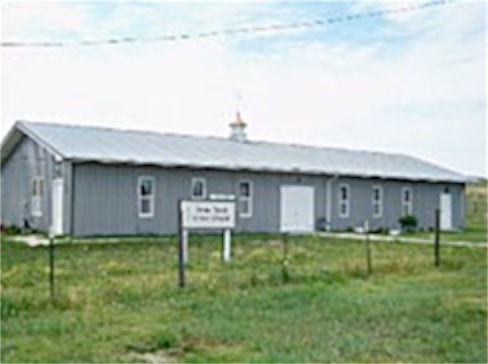 They are also completely irrelevant numbers to a congregation like Cherry Creek on the Cheyenne Reservation. The church has title to some reservation property and it is hard to put a value on the land because there is some question as to whether or not it could be sold. Part of the holdings might revert to the tribe if the land was no longer used for a church. The church building is a doublewide trailer that is worth considerably less than $100,000. No one would label the congregation as wealthy.
They are also completely irrelevant numbers to a congregation like Cherry Creek on the Cheyenne Reservation. The church has title to some reservation property and it is hard to put a value on the land because there is some question as to whether or not it could be sold. Part of the holdings might revert to the tribe if the land was no longer used for a church. The church building is a doublewide trailer that is worth considerably less than $100,000. No one would label the congregation as wealthy.
Somewhere in between those two extremes lies the congregation I serve, with a balance sheet showing just over a million dollars in assets, an annual operating budget of $309,000 per year and a separate trust that manages less than a half million dollars in assets. And yet within our congregation, there are many different perspectives on wealth and poverty. There are good and faithful members who believe that the church has too many assets and that we are capable of expanding mission and outreach. They feel that managing investments is not the proper work of the church and that we should not be in the business of preserving capital. There are other members, also good and faithful, who believe that our reserves are too small relative to our operations and that we not only need to preserve capital, but grow it so that we will have larger assets and holdings in the future. These tensions are not expressed in anger or conflict within the church, but they are nonetheless real. I know enough about the discussions to know that I have no envy for the wealth of a church like Trinity in New York City. They must spend huge amounts of time talking about money and much less time talking about ministry.
I think I prefer my churches, and the pastors, on the less wealthy side of the coin. Wealth can be a significant problem. It tempts us to think that we “earned” it or that it somehow belongs to us. Nothing could be farther from the truth.
As the song says, “We give thee but thine own, whate’r the gift may be. All that we have is thine alone: a trust, O God, from thee.”
The Christian Church was begun in the midst of a culture with radically uneven distribution of wealth. The Roman Empire existed to preserve and expand capital. The wealth produced by outlying lands was brought into Rome in a spectacular display. Our people knew about this practice precisely because we had a season of our common life when consolidating wealth was the focus of our attention. Under the reign of King Solomon, Israel saw a great consolidation of wealth in Jerusalem. Read the stories of the construction of the 1st temple contained in Kings and Chronicles. There are lists of dimensions, building materials, and reference after reference to the gold that was used in the construction. There are stories about arms trading, speculation in expensive horses and other business dealings that were undertaken by the monarchy. By the time of Jesus’ birth, however, Jerusalem and all of Israel and Judea had fallen on much harder times. The people knew the taste of military defeat, understood the legacy of exile, and were bracing for a violent blow from Rome that occurred in the first century after the death and resurrection of Christ.
In recent years, however, we have used our contemplation of wealth and poverty mostly in regards to the persons who are engaged in Christian ministry. Salaries and pay packages for ministers and priests can be topics of hot discussion. They vary widely depending on denomination and the characteristics of individual congregations. There is some speculation among church leaders that sounds a bit like merit pay (the best ministers earn the highest compensation) but most serious church members understand that such is rarely the case. The largest indicator of minister salary is the size of the congregation (bigger church = bigger pay; smaller church = smaller pay). Even that formula isn’t an exact pattern, however. Some small congregations have wealth that has been saved from previous generations. Some large congregations have taken on very high operating expenses through elaborate buildings and other high-maintenance items. Some congregations give large portions of their annual operating budgets in mission work and gifts to other institutions. Other congregations retain nearly all of their income for their own projects. There is no hard and fast rule. There is a wide variation in clergy salaries. A pastor serving one of the congregations of the Dakota Association receives a little over $14,000 per year in salary and housing. The base salary for the rector at Trinity Episcopal Church in New York City is $475,000. The total compensation package with pension, health care and the cost of living rent-free in a $5.5 million SoHo town house are added, is estimated at about $1.3 million per year. There are some who argue that that particular ministerial position stands outside of a pledge of poverty. There are probably a few members of that congregation who question the pay package. Sadly there are more people who talk about the pay of the rector of Trinity Church than who focus their attention on the pay of reservation pastors. If we paid more attention, we would be looking harder for solutions to pay packages that force clergy to supplement their income from other sources.


Somewhere in between those two extremes lies the congregation I serve, with a balance sheet showing just over a million dollars in assets, an annual operating budget of $309,000 per year and a separate trust that manages less than a half million dollars in assets. And yet within our congregation, there are many different perspectives on wealth and poverty. There are good and faithful members who believe that the church has too many assets and that we are capable of expanding mission and outreach. They feel that managing investments is not the proper work of the church and that we should not be in the business of preserving capital. There are other members, also good and faithful, who believe that our reserves are too small relative to our operations and that we not only need to preserve capital, but grow it so that we will have larger assets and holdings in the future. These tensions are not expressed in anger or conflict within the church, but they are nonetheless real. I know enough about the discussions to know that I have no envy for the wealth of a church like Trinity in New York City. They must spend huge amounts of time talking about money and much less time talking about ministry.
I think I prefer my churches, and the pastors, on the less wealthy side of the coin. Wealth can be a significant problem. It tempts us to think that we “earned” it or that it somehow belongs to us. Nothing could be farther from the truth.
As the song says, “We give thee but thine own, whate’r the gift may be. All that we have is thine alone: a trust, O God, from thee.”
Copyright © 2013 by Ted Huffman. I wrote this. If you want to copy it, please ask for permission. There is a contact me button at the bottom of this page. If you want to share my blog a friend, please direct your friend to my web site.
Seeking serenity
24/04/13 04:03
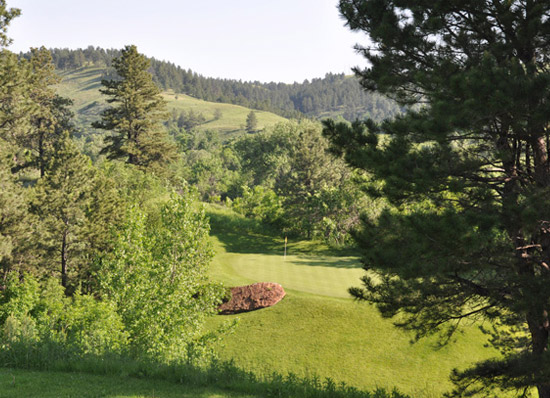
PLEASE NOTE: I try hard not to tell stories about people who might be identified by readers of my blog. These stories are, after all, the stories of others and they are not my stories to tell. But, from time to time, my experiences involve other people and when I tell my story, it contains a bit of the story of another. I caution those who know me well and know the people that I serve from trying to identify the people in my blog. Even if you know the person about whom I am writing, you can only know part of the story. My blog does not give a complete picture of another and there is always more to the story.
I invested much of yesterday afternoon visiting a man who has experienced significant memory loss. I don’t know the official diagnosis of his condition, but several have used Alzheimer’s disease when speaking of him and his condition. He lives quite a ways out of town on a small acreage with a beautiful view and you can see immediately what attracted him to build his home in such a beautiful location. But these days he cannot drive and so his home has become something quite opposite than the symbol of freedom that he once enjoyed. He has live-in caregivers who are kind and attentive to his needs and I believe has the financial means to continue this arrangement for as long as it takes. He leaves his home only to go to medical appointments these days. The regular excursions to meet with friends, attend church, go out to dinner, shop and travel that once were a part of his life are now gone. I suspect that it takes considerable effort to get him ready to leave the home, that there are all sorts of possible unforeseen problems when going into town with one who has significant physical abilities, but diminished cognitive capability. Whatever the reasons, he is now cut off from others in his own beautiful home. I have witnessed the tragedy of diseases that rob people of their memories enough to know that these are devastating diseases.
He is aware than his brain is not functioning properly. He spoke of it several times in the course of the visit saying, “My brain no longer works,” “I’m on the downhill slide,” “I can’t find the word,” and other similar phrases. Occasionally he would start to tell me something, be unable to find the words to express his idea and give up in frustration.
Like many similar visits with others, we went through the same story repeatedly in the course of an hour’s visit. Sadly, the story that was repeated over and over was one about which he has significant regret and feels a bit of remorse. He told me, at one point, that he was dreading my visit because he would have to explain this event. There is no logical reason why our conversation would have needed to broach the topic except that he seemed to need to tell me about the situation and how he felt – perhaps how he still feels, since the scenario keeps replaying in his mind over and over. I guess that when the brain is trying to process meaning in the presence of lost memory, it gets “hung up” on certain stories and those stories come to the surface again and again.
The sad thing is that the memory that keeps being repeated is one of regret. This man once had a world of pleasant memories. He served in a mobile medical unit in Korea during the Korean War and used to be able to tell stories about how he liked the challenge of that work and felt that his life had been a bit like the television series M*A*S*H. He was a pilot and at one time had a host of stories about flying light airplanes around the country and the joy of seeing the world from the air. He sang in church choirs all of his life and loved to sing. He was present when Fred Waring and the Pennsylvanians sang an inaugural concert at Constitution Hall when Eisenhower was president. He used to love to tell the story of how moved he was by that concert. He was a collector of vintage and antique vehicles and used to love driving to church in a beautifully restored 1951 Henry J. He took great delight in the fact that not many people remember Kaiser’s effort to enter the low price market by building a small car and couldn’t identify what kind of car he was driving. He had a successful business career and at one time could tell you about the things he had accomplished. He was somewhat less successful in marriage, but the third match was a good one and he took great delight in telling stories about his wife and the travels they took and the tragedy of her premature death from cancer.
But yesterday, it seemed as if all of the pleasant and productive memories were somehow lost and the only story he could tell was one of regret. How I wished he could replace that particular memory with a more pleasant one! I kept trying to gently guide the conversation to a more pleasant memory and told him bits of stories that he had previously told me. But the topic quickly returned to the story that was being told over and over again. I tried to say that I understand and that forgiveness is a gift of God. I prayed a prayer of absolution, trying to free him from the “stuck” memory. But he was still telling me the story as I rose to leave, pressured by the deadline of an upcoming meeting.
As I took my parting, I closed our time with the opening lines of the famous prayer by Reinhold Niebuhr: “God, give me grace to accept with serenity the things that cannot be changed, courage to change the things which should be changed, and the wisdom to distinguish the one from the other.”
The prayer was for him, but it was also for me. If I should one day be trapped by the ravages of Alzheimer’s disease or some other form of dementia, I genuinely hope that the memories in which I become stuck are pleasant and beautiful, for my life has been far more joy than regret. This, however, is not something I can control. May I find grace to accept with serenity those things that I cannot change.
Copyright © 2013 by Ted Huffman. I wrote this. If you want to copy it, please ask for permission. There is a contact me button at the bottom of this page. If you want to share my blog a friend, please direct your friend to my web site.
There's Trouble in Them Thar Hills!
23/04/13 05:59
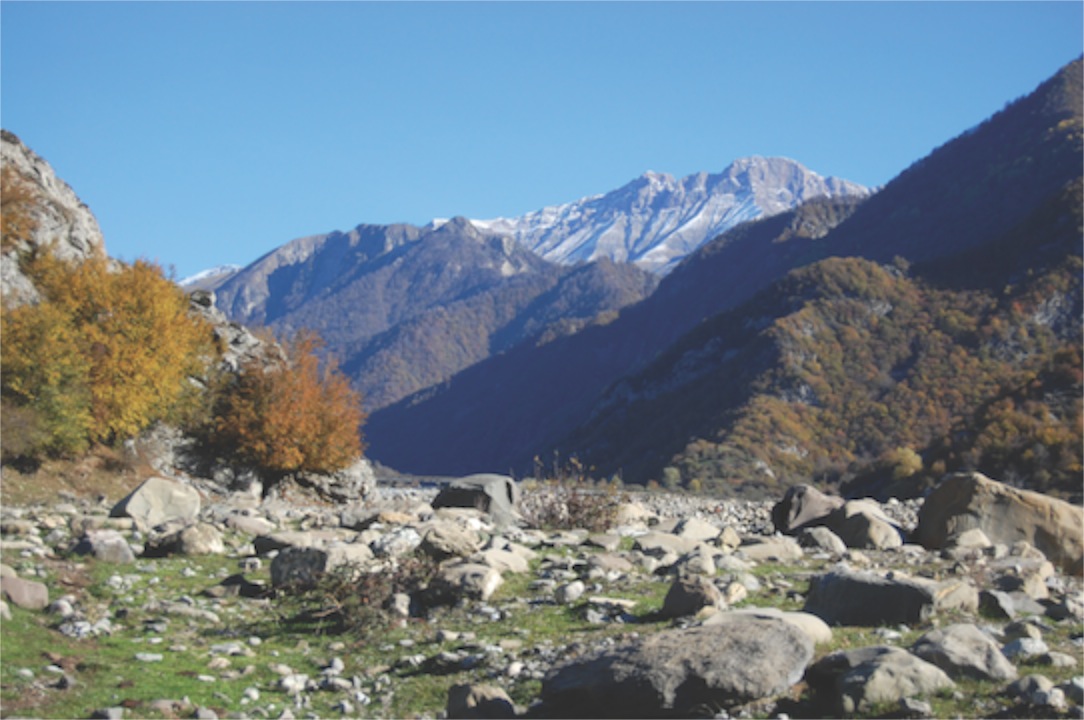
I doubt that there is any real connection between high mountains and radical politics. But as one who grew up in Montana and lived for another decade of my life in Idaho, I am aware that there are some people with passionate political beliefs who live in some very beautiful and remote mountain places. In the United States, the mountains attract people who want to live independently, some of whom are suspicious of any kind of outsider, including the government. I suspect that the number of libertarians as a percentage of the population is higher in remote mountain locations than in cities. Some of those mountain dwellers do like their guns and I suppose they pose some kind of a remote danger, but it is rare that they are a threat to others. There have been some isolated cases of militia members getting out of hand and it is widely known that the unibomber wrote his manifesto and mailed his bombs while living remotely and teaching himself survival skills in the Montana backcountry.
Most of those folks, however, are good people who mean no harm to others.
Still, there have been a lot of bloody battles fought in and around the mountainous regions of the world. The fact that the two brothers who perpetrated the Boston Marathon bombings and the subsequent deaths of two police officers came to the United States from Chechnya got me to thinking about the connections between mountains and violence. It is pure speculation and I’m not sure that there is any connection between mountains and violence, but there certainly is a long history of violence associated with the Caucasus region.
The neck of land between the Black Sea and the Caspian Sea, north of Turkey and Iran, is home to some of the highest mountains in Europe. Mt. Elbrus at 18,510 feet is the highest. The Caucasus Mountains will play host to the 2014 Winter Olympics. Nestled in the middle of the region with Dagestan to the east and Ingushetia to the west is Chechnya. It is a long way from Boston. And it is a stretch to imagine that Islamic militancy, born in the Caucasus could really provide an explanation of the motive for the Marathon bombings.
Chechnya is rich in oil, but it is mainly known in the west for its brutal wars. In the 1990’s separatists battled for independence from Russian and they were answered with brutal force from the Russian government. The capital, Grozny reduced to rubble. It has been reported that more than 100,000 people died in that conflict. One report claims that one fifth of the total population of Chechnya has died in conflict since 1994. That left behind an overwhelming load of grief and grief can turn to anger in the pressure cooker of world politics. A more radical form of Islam began to spread throughout the region and in the late 1990’s Chechen fighters joined Afghan fighters in the war against Russia. A second Chechen uprising in 1999 was brutally crushed by Russian troops. The government of Chechnya is pro-Moscow these days, but there is plenty of anti-Russian sentiment in those mountains and Chechens have been blamed for several different acts of terrorism in Russia. In 2002, a theater was seized with bloody results. In 2010, the Moscow metro bombs were blamed on Chechen rebels.
All of that violence produced refugees. Our country, as has been the place in other world conflicts, provided a haven for a few of the refugees. Among those was the family of the Boston bombers. The younger brother seemed to be adjusting well to life in his new country, but the older brother struggled to find where he fit in. Last year, he spent 6 months in Dagestan.
It is unlikely that we will ever fully know the reasons for the seemingly senseless violence that erupted at the finish line of the Boston Marathon. The older brother, who seemed to be the ringleader, is dead. The younger brother will be interrogated, but the answers are elusive. About all one can say is that the violence has a connection, however slim, to a very bloody backstory. The Caucasus Mountains are seeped in the blood of generations of fighters and more than a few innocent victims.
It is a logical stretch and inaccurate to make a connection between violence and high altitudes. Mountains may have provided safe haven for rebels and fighters in the past, but the violence that has been perpetrated in mountainous regions is hardly the product of the geography itself. As has been proven time and time again, we humans are capable of great cruelty and dramatic violence against one another independent of the terrain in which we find ourselves.
There will be plenty of speculation and no small amount of serious attempt to understand the dynamics of violence. There are a few Russian commentators that would like to convince Americans that all Chechens are evil and that the US should back Russian actions of strict domination of the region. More likely, we will have to live with a degree of uncertainty. The actions of the Tsarnaev brothers defy logic. Like other crimes perpetrated against innocent victims, solving the puzzle of who did it doesn’t give a full explanation of the motive.
It will be interesting to see if the events have any impact on the strained relationships between the United States and Russia. Russian authorities have, for decades, blamed the United States for sympathy, if not outright involvement, in the attempts of Chechen rebels at independence. There are voices in Russia that are saying that now the US can at least see the terrorism that comes from the region. I doubt if the dynamics are that simple. The issues are complex and there is much that we do not understand.
For now we grieve with the families of the victims and we rest a bit more calmly knowing that our law enforcement officials were so quick to solve the crime and make sure that the criminals could not perpetrate further violence.
Copyright © 2013 by Ted Huffman. I wrote this. If you want to copy it, please ask for permission. There is a contact me button at the bottom of this page. If you want to share my blog a friend, please direct your friend to my web site.
Spring snow
22/04/13 05:26
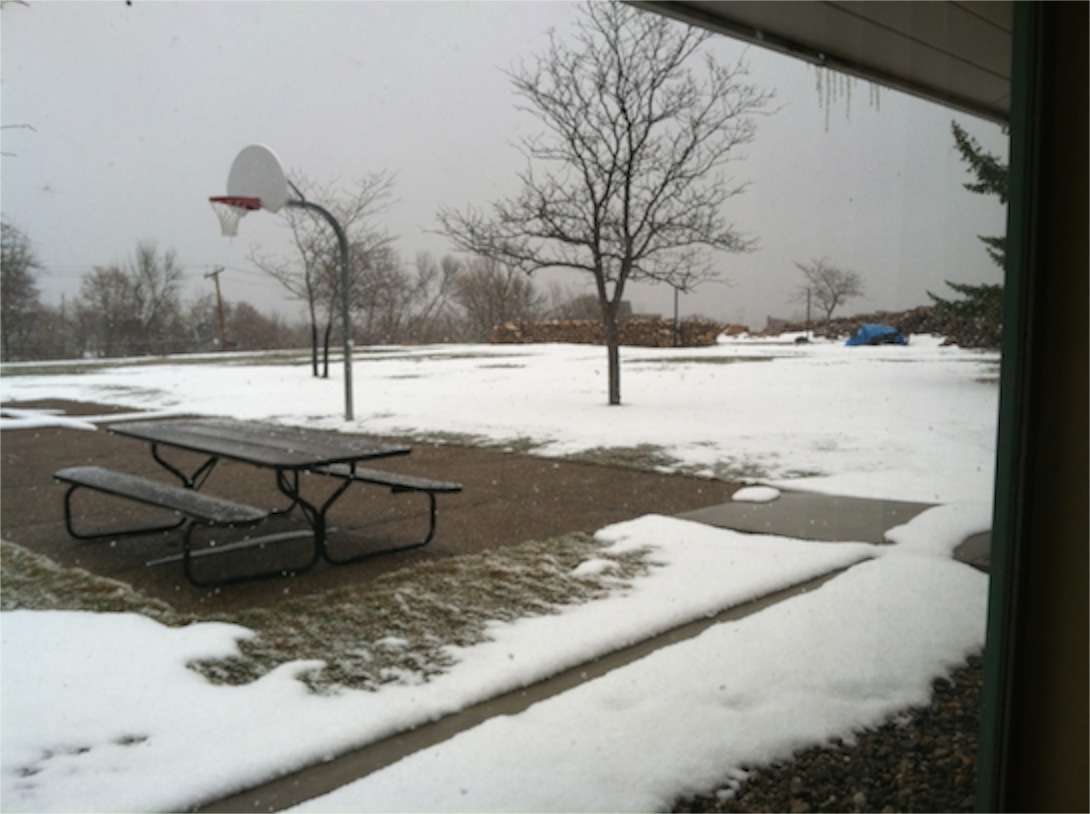
We do live in an interesting place. It is a bit hard to tell, but there are at least four inches of new snow on the ground and the snow is still coming down. The radar indicates that we should expect light to moderate snowfall for a few more hours at least. The yard was almost bare yesterday and the good news is that the grass was green. After months of brown, it is really nice to have the green showing up and to anticipate spring growth.
A few spring snow showers don’t break the drought cycle and it is way too early to make predictions about the year’s precipitation totals, but it is nice to have the moisture. There is even a bit of mud in places.
All of this recent moisture is combining to get the forecasters concerned about possible flooding. We don’t have anything to worry about here, but downstream may be a different situation. In the prairies east of the hills, the water is starting to flow by at a quick pace. Turtle Creek is at full flood stage and east river the James and Elm rivers are reporting flooding as well.
According to Accuweather, people in the upper Midwest should be bracing for record flooding. Near St. Paul, the Mississippi river is expected to crest in about a week at least 13 feet higher than it is today. There are already some roads blocked by floods in Minnesota and a backhoe operator was killed while trying to clear debris from a culvert in that state.
But floods are difficult to predict. Our forecast here calls for temperatures 20 to 30 degrees below average for the whole week. Cooler temperatures mean slower melting. Slower melting means more water sinks into the ground to refresh the underground aquifer and less runs off to cause flooding down stream. A month a go, it seemed like the ground was so dry that it could absorb all the snowmelt we could produce.
And it gives us something to talk about. We often joke that we only lived in North Dakota for seven years and in that time they never had a typical year. Each year, whether it was cold or warm, snowy or dry the local people would steadfastly declare to us: “It isn’t usually like this around here.” We never found out what “usual” was like. The truth, however, is that I like to be surprised by the weather. The spring blizzards of the past few weeks have been beautiful. We get those large, lovely snowflakes and the white snow contrasts with the sunny skies. The storms come and go leaving the skies clear and beautiful. The snow melts and settles almost as fast as it falls, so it really doesn’t cause much disruption. We may take a day to dig out, but soon we’re back to business as usual. And it was so good for our spirits to see the green grass after a dry winter.
Weather forecasts are more accurate these days than they were years ago. The development of a network of accurate weather radar stations has made a big difference in our ability to see what is going on with the storm systems. Anyone with a computer and access to the Internet can now access full color radar at the click of a mouse. When I compare what I can get from the comfort of my home with what used to be available at a flight service station, I can see how far we have come. The blizzards don’t really catch us by surprise like they used to. Forecasters still struggle with the exact timing of storms. Sometimes they move slower than predicted, but for the most part they are pretty accurate in predicting storm tracks and where the weather will go.
So if the forecasters are accurate this week, we could see a little more snow today and a little rain in the early part of the week, with rising temperatures throughout the week. By the end of the week, we could see temperatures as high as 70 degrees. Next weekend should be beautiful. Who knows, we may even be mowing the lawn or putting in part of the garden in a week or so.
We are concerned for those who live down stream. Flooding is never a welcome companion. And we saw dramatic effects of down stream flooding a few years ago when relatively high snow falls here combined with record snow pack in the Rockies that melted very quickly with warm temperatures. The flooding overwhelmed the Missouri River reservoir system and forced releases that caused a lot of flooding along the entire basin. It seems unlikely that such a scenario will be repeated this year. The reservoirs are not yet full and there is a lot of water storage capacity in the system.
We live lives that are more detached from the weather than was the case of previous generations. For the most part we go on with our lives regardless of the weather. Even severe drought doesn’t mean famine for us. The grocery stores remain well stocked and our incomes, though not totally separated from the agricultural economy, are far enough removed that the paychecks keep coming in. The weather can affect attendance at church and I come from a long enough line of folks who farmed and ranched that checking out the weather is a deeply ingrained part of my daily routine. The bottom line, however, is that life goes on whether it snows or rains or fails to give us any precipitation. We’re more removed from the cycles of weather and nature than was the case for any previous generation of folk in this part of the world.
So it is good to be surprised by the weather. I enjoy it. I don’t want every detail to be completely predictable. If you are going to live in a very interesting place, you might as well stay interested in what is going on.
Keep looking up!
Copyright © 2013 by Ted Huffman. I wrote this. If you want to copy it, please ask for permission. There is a contact me button at the bottom of this page. If you want to share my blog a friend, please direct your friend to my web site.
Tattoo
21/04/13 05:31
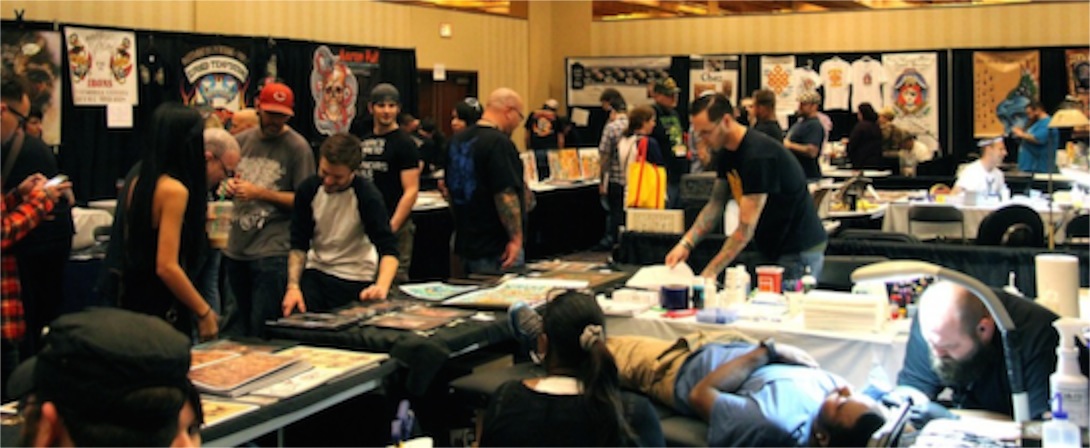
The National Tattoo Association is wrapping up their 34th annual convention in Rapid City today. I didn’t register for any of the events and I haven’t made a trip down to the Ramkota to take in the sights. Rapid City hosts a lot of conventions and gatherings and the Ramkota is a large convention center and hotel with plenty of meeting rooms and banquet halls to handle the convention. I’m sure that there are other unique conventions, but I confess that I haven’t given much thought to what a professional association of tattoo artists might be like. Scanning the convention agenda, it looks a lot like other conventions. There is a bus tour to Mt. Rushmore and Crazy Horse mountain carvings. There is a charity golf tournament. There are banquets and classes for professional development and discussions of business management practices. There is a silent auction and a raffle. There are lectures and seminars and an awards banquet.
A unique feature of the event, however, is that the convention features scores of tattoo booths set up in the convention center. If a person wanted to have a tattoo applied, this is the place. There are daily contests judging the best tattoo of the day and the artist bring out all of their best efforts in order to produce a winning tattoo. Judging from the pictures in the paper, it appears that a number of the new tattoos applied during the convention are applied to other tattoo artists, though I think that members of the general public are welcome to have some ink applied to their skin as well.
I don’t have any tattoos. I never felt a need to get one. I have good friends and relatives with tattoos and other than some discomfort during the process of having them applied, none of them seem to have had any ill effects from having a permanent decoration applied to their skin.
I have not, however, spent much time thinking about the business of running a tattoo . . . hmm . . . what do you call an establishment that applies tattoos? . . . parlor, studio, shop . . .? I don’t know what I thought. I suppose that I assumed that like many other art forms, it is hard to make a full-time living in the business of applying tattoos. Many artists have to have some other way of providing income to survive as they pursue their art. I assume that tattoo artists take a lot of photographs of their work so that they can build a portfolio to show potential customers.
There are probably tricks of the trade about how to market tattoos, where to get the best prices on supplies, how to keep people calm while the work is being done, and other aspects of the business.
Apparently there are enough topics for a five-day convention.
It does leave me with some unanswered questions: Does an insurance salesman at a tattoo convention have to have visible tattoos in order to be trusted? I’m pretty sure that you couldn’t get by with those cheap removable tattoos in this crowd. Are there special techniques for dealing with people who change their mind about having a tattoo applied just as the needle meets the skin for the first time? Are there professional tricks to getting people to have a tattoo applied? Does it pay to have discount coupons? Do tattoo parlors advertise by having their business name printed on pens?
OK, I’ve wasted enough words with idle speculation.
Rapid City seems like a natural place to host the National Tattoo Association. We are used to having lots of conventions. We are pretty good at extending hospitality to visitors. We have lots of nearby attractions for visitors to see and plenty of things to do for family members of convention goers. And we are right next door to Sturgis, home of the largest motorcycle convention each year. There is a long-standing connection between tattoos and motorcycles. In fact, it is possible that there are more tattoos in town during the motorcycle convention than during the tattoo convention. And there are certainly more people running around with sleeveless shirts and exposed skin during August than has been the case during our rather snowy April this year.
I’m sure that some of the participants in the Tattoo Association convention took some time to scout out their booth sites for this summer’s motorcycle rally. I’m thinking that part of the reason Rapid City was chosen for the convention is that there were already quite a few tattoo artists who are familiar with the area.
This Thursday I have an appointment to donate platelets. Each time I am screened before donating at the blood bank, they ask whether or not I have had a tattoo applied since my last donation. Each time the answer is “no.” Apparently there is an increased risk of getting a blood-borne disease such as hepatitis from having a tattoo applied by someone who is careless with the safety procedures and sterilization of equipment. On the other hand, I’m pretty sure that a reputation for safety and cleanliness is pretty much essential in order to succeed in the tattoo business. With the possible exception of a few drunken sailors in port (and perhaps a few drunken motorcycle rally participants), there aren’t many people asking “Bubba” to tattoo “Mom” on the bicep out back in the garage. And it isn’t likely that Bubba showed up for the convention and paid the fees to play in the golf tournament with the other tattoo artists. Still, it is reassuring to know that the people at the blood bank are being conservative and careful when screening potential donors. Each of us is just one accident away from needing a donation of blood.
So my answer to the question will be the same as it has been each time I’ve donated platelets or blood. “No,” I haven’t got any new tattoos. I don’t have any old tattoos, either. They never have caught on as a big fashion statement for those in my profession.
If I ever find myself selling insurance to tattoo parlors it might be a different story.
Copyright © 2013 by Ted Huffman. I wrote this. If you want to copy it, please ask for permission. There is a contact me button at the bottom of this page. If you want to share my blog a friend, please direct your friend to my web site.
We do not give in to terror
20/04/13 05:36
I used to blog about events that made headlines in the news. It is my custom to begin my day by scanning news headlines from around the world on my computer. I check out the BBC, an Australian Web Site, A.M. Costa Rica, the Washington Post, the New York Times and our local Rapid City Journal. Often I would react to some piece of breaking news. Over the years, however, I discover that I am less inclined to do so. My perspective on news stories isn’t always helpful. There are plenty of news sources and the information isn’t always consistent. There are times when my initial reactions don’t’ add insight or fresh perspective.
So I have tried to be measured in my response to the bombings that killed three and injured over a hundred near the finish line of the Boston Marathon on Monday. I didn’t want to jump to conclusions. I watched the events unfold along with the rest of the world.
 Terror takes a strange path through a community and through our nation. When dramatic events occur, we are quick to look for places to attach blame. We want to identify a clear enemy. When the Alfred P. Murrah Federal Building in Oklahoma City was bombed in April of 1995, speculation quickly flew to blame foreign terrorists. When we learned that the bombers were Americans with radical beliefs, our image of what a terrorist was shifted. 168 people lost their lives in that bombing including 19 preschool children. An additional 680 were injured. Until the September 11, 2001 attacks, it was the most destructive act of terrorism on American soil. The official investigation reported that Timothy McVeigh had detonated the bomb and was assisted in the making of the bomb by Terry Nichols. Michael and Lori Fortier were later identified as accomplices. McVeigh was executed by lethal injection. Nichols received a sentence of life in prison. Michael Fortier was sentenced to 12 years and Lori Fortier received immunity in exchange for her testimony.
Terror takes a strange path through a community and through our nation. When dramatic events occur, we are quick to look for places to attach blame. We want to identify a clear enemy. When the Alfred P. Murrah Federal Building in Oklahoma City was bombed in April of 1995, speculation quickly flew to blame foreign terrorists. When we learned that the bombers were Americans with radical beliefs, our image of what a terrorist was shifted. 168 people lost their lives in that bombing including 19 preschool children. An additional 680 were injured. Until the September 11, 2001 attacks, it was the most destructive act of terrorism on American soil. The official investigation reported that Timothy McVeigh had detonated the bomb and was assisted in the making of the bomb by Terry Nichols. Michael and Lori Fortier were later identified as accomplices. McVeigh was executed by lethal injection. Nichols received a sentence of life in prison. Michael Fortier was sentenced to 12 years and Lori Fortier received immunity in exchange for her testimony.
Even though the arrests were quick and the prosecution of those involved successful, speculation about what happened abounds. There are still plenty of conspiracy theories circulating through the nation. There are plenty of people who are unconvinced by the official reports.
The attacks of September 11, 2001 were entirely different. They were planned far in advance, carefully coordinated and carried out with the intention of having the maximum impact. Once again we witnessed acts that showed no regard for innocent victims, but this time there was a distinctive outside influence. The term “War on Terror” became common in news reports and on the lips of Americans. Osama bin Laden was identified as the leader of the terrorists and as founder of the organization that claimed responsibility for the attacks became a target of and world-wide manhunt until was killed in March of 2013. The War on Terror has become a unique chapter in American History. Previous wars were engaged against specific countries in response to their actions. Terrorism, however, is not a nation. It is a tactic. And as we already had witnessed, it could be carried out by those within our nation as well as foreign enemies.
The problem with terrorism is that it creates fear. And people who are overcome by fear do irrational things. In our response to terrorism, we are tempted to engage in actions that do not make us more secure. Sometimes our responses have directly the opposite effect than what was intended.
 I worry that the simple fact that the brothers who seem to be the perpetrators of the bombings and killings in Boston are refugees. It would be a tragedy for us to become afraid of all refugees because of the actions of two. Whenever we place people in categories, we make mistakes. The two men were from Chechnya, but not all Chechens would engage in such activities. They were both Muslims and the older brother had recently become involved with more fundamentalist and radical Muslim groups, but blaming all Muslims for the actions of the two would cause more than a small amount of misplaced fear. The older brother, who was killed, was a boxer. It doesn’t make sense to blame all boxers because of his actions.
I worry that the simple fact that the brothers who seem to be the perpetrators of the bombings and killings in Boston are refugees. It would be a tragedy for us to become afraid of all refugees because of the actions of two. Whenever we place people in categories, we make mistakes. The two men were from Chechnya, but not all Chechens would engage in such activities. They were both Muslims and the older brother had recently become involved with more fundamentalist and radical Muslim groups, but blaming all Muslims for the actions of the two would cause more than a small amount of misplaced fear. The older brother, who was killed, was a boxer. It doesn’t make sense to blame all boxers because of his actions.
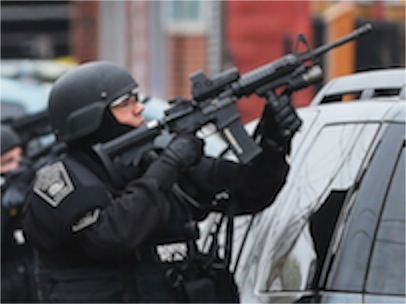 Fear, however, is not rational. Yesterday, while the city of Boston was virtually shut down and the search for the younger brother was being carried out, the Senate Judiciary Committee began hearings on immigration reform. Senator Chuck Grassley of Iowa spoke of “weaknesses in our system” and “how we can beef up security checks” and insure that “those who would do us harm do not receive benefits under the immigration laws.” On the surface his comments make some sense. Everyone wants to do what we can to keep people safe. But the truth is that we are a nation of immigrants. With the exception of a few Native Americans, the rest of us trace our ancestry to people who came to this country from the outside. To place all immigrants in the same category or to develop an irrational fear of refugees is to deny the benefits we have received to other deserving individuals.
Fear, however, is not rational. Yesterday, while the city of Boston was virtually shut down and the search for the younger brother was being carried out, the Senate Judiciary Committee began hearings on immigration reform. Senator Chuck Grassley of Iowa spoke of “weaknesses in our system” and “how we can beef up security checks” and insure that “those who would do us harm do not receive benefits under the immigration laws.” On the surface his comments make some sense. Everyone wants to do what we can to keep people safe. But the truth is that we are a nation of immigrants. With the exception of a few Native Americans, the rest of us trace our ancestry to people who came to this country from the outside. To place all immigrants in the same category or to develop an irrational fear of refugees is to deny the benefits we have received to other deserving individuals.
Tragedy unfolded in Boston this week. In addition to the victims of the bombings, one police officer was killed and another wounded. For whatever reasons two men gained the capability of causing a lot of harm to innocent victims and they used that power to unleash terror. But it is also true that investigators were remarkably effective. They quickly found and followed leads and they have a high degree of confidence that the perpetrators of the crime are no longer on the loose. Capturing one of the brothers alive allows for further investigation to continue. Perhaps the investigators will gain some insight into the reasons behind the bombing and ways that future events might be prevented.
In the meantime, I refuse to give in to fear. I will continue to live my life, to welcome strangers, to work with the people who come my way. Despite these acts, we live in a place of safety compared to many parts of the world. Terror wins when we live our lives in fear. But we have also seen great examples of courage in these days. May we be guided by the courage that we have witnessed.
So I have tried to be measured in my response to the bombings that killed three and injured over a hundred near the finish line of the Boston Marathon on Monday. I didn’t want to jump to conclusions. I watched the events unfold along with the rest of the world.

Even though the arrests were quick and the prosecution of those involved successful, speculation about what happened abounds. There are still plenty of conspiracy theories circulating through the nation. There are plenty of people who are unconvinced by the official reports.
The attacks of September 11, 2001 were entirely different. They were planned far in advance, carefully coordinated and carried out with the intention of having the maximum impact. Once again we witnessed acts that showed no regard for innocent victims, but this time there was a distinctive outside influence. The term “War on Terror” became common in news reports and on the lips of Americans. Osama bin Laden was identified as the leader of the terrorists and as founder of the organization that claimed responsibility for the attacks became a target of and world-wide manhunt until was killed in March of 2013. The War on Terror has become a unique chapter in American History. Previous wars were engaged against specific countries in response to their actions. Terrorism, however, is not a nation. It is a tactic. And as we already had witnessed, it could be carried out by those within our nation as well as foreign enemies.
The problem with terrorism is that it creates fear. And people who are overcome by fear do irrational things. In our response to terrorism, we are tempted to engage in actions that do not make us more secure. Sometimes our responses have directly the opposite effect than what was intended.


Tragedy unfolded in Boston this week. In addition to the victims of the bombings, one police officer was killed and another wounded. For whatever reasons two men gained the capability of causing a lot of harm to innocent victims and they used that power to unleash terror. But it is also true that investigators were remarkably effective. They quickly found and followed leads and they have a high degree of confidence that the perpetrators of the crime are no longer on the loose. Capturing one of the brothers alive allows for further investigation to continue. Perhaps the investigators will gain some insight into the reasons behind the bombing and ways that future events might be prevented.
In the meantime, I refuse to give in to fear. I will continue to live my life, to welcome strangers, to work with the people who come my way. Despite these acts, we live in a place of safety compared to many parts of the world. Terror wins when we live our lives in fear. But we have also seen great examples of courage in these days. May we be guided by the courage that we have witnessed.
Copyright © 2013 by Ted Huffman. I wrote this. If you want to copy it, please ask for permission. There is a contact me button at the bottom of this page. If you want to share my blog a friend, please direct your friend to my web site.
Memory
19/04/13 05:25
I recently had a dream in which I was unable to remember my grandson’s name. I woke before the dream had developed much, but there was a distinct discomfort associated with the dream. I think of myself as living without much fear, but I guess that somewhere inside of me there is a fear of losing my memory.
The fear may come from experiences that I have working with people. I visit a man several times each week who is in the hospital and who is frequently confused. His confusion may have its roots in a fall that he took. It was the initial cause of his admission to the hospital. It may also be aggravated by the simple fact that he has been in the hospital for a long time. Days and nights tend to blur in the busyness of the institution that is continually in motion. When one lives with the routine of the hospital for a long time, sleeping at different times of the day and the night, spending more time than usual in bed and seeing the same scene outside of your room day after day, it is hard to keep track of the days. In a way it doesn’t surprise me that he recently answered, “March,” when asked what month it is. Even though it now is April, it was March when he was admitted to the hospital. The fact that he got the year wrong by more than ten years, however, was enough to worry me. He did answer correctly when asked who the President of the United States is. Television has been in his room enough that he has some sense of connection with events and activities in other parts of the world. Since current news is frequently distressing to me, I wonder how much of what he sees on the television is unpleasant for him.
It is just one story. We have plenty of opportunities to witness persons whose memories do not serve as faithfully as once was the case. There are many different names for different kinds of dementia and many different causes for these disorders. Alzheimer’s Disease has gotten a lot of attention in the media in recent years, but it is just one disease that has, among other effects, a heartbreaking loss of memory. We used to simply use the term “senility” for any signs of confusion exhibited by our elders and accepted it as a natural part of the aging process. But we know that some of these tragic diseases are not natural.
Elie Wiesel explores the tragic aspects of memory loss in a powerful novel, “The Forgotten.” One of the central characters of the book is a distinguished psychotherapist and holocaust survivor. He is losing his memory because of an incurable disease. He resolves to tell his son about his past and his son undertakes a journey to the Romanian village where his father used to live. The story of a gravedigger, the discovery of the grave of his grandfather, and other events help to bind the generations even though some of the memories appear to be forever lost.
I could recount story after story about the loss of memory and readers of this blog have their own experiences with those who have experienced loss of memory due to disease and other causes. It can be a deep tragedy.
We are afraid of losing our memories.
The capacity to remember and to share those memories with others is one thing that distinguishes humans from other creatures. While it is true that other creatures carry shared memories in their genetics, humans appear to be unique in our ability to carry consciousness of stories from one generation to another. The stories of our people have their origins thousands of years in the past. We share psalms and scriptures that our people have been telling one another for generation after generation. Our common memory is far more vast than the memories of any individual.
This is not only true of Biblical stories. The fairy tales that we tell have their origins in antiquity as well. There are many stories that have been told over and over for so long that we don’t know their origins. We humans have the ability to pass on stories from one generation to another.
I suppose that should be a bit reassuring for me. Even if I lose my memory, there is a collective memory that is deeper and stronger than any individual. The truths that I have encountered are not mine alone, but rather belong to many generations of our people.
One of the joys of aging is the simple fact that there are a lot of memories. Our minds sift and sort the memories and, for the most part, pleasant memories come to the top. When I think back, I realize that I have been witness to incredible beauty, great courage, deep love, powerful faith, and undying hope. I have memories of some of the best of humanity. Were I to suffer a disability that left me unable to get around or incapable of seeing or hearing, I would still have my memories. And my memory contains not just my own experiences, but the stories of others as well.
But were I to lose my memory, there would be deep grief. My memories are my friends. I dwell with them in joy and I recall them with great pleasure.
I have not lived my life in fear and I have no intention of doing so now. I am content to allow my future to unfold in ways that will surprise me. I have no need to know what lies ahead. And I am sure that God will grant me some degree of grace in facing whatever comes. Since, however, I do not want to lose my memory, I try to exercise it regularly. I read the articles about what we can do to prevent memory loss. I am aware of the role of remaining physically active in preserving memory. I try to be careful with what I eat. I work puzzles and exercise my memory regularly.
And, I suppose, if all else fails, I do have a huge collection of blog posts that I can read. One advantage of not being able to remember would be the ability to read the same thing over and over again without getting bored.
The fear may come from experiences that I have working with people. I visit a man several times each week who is in the hospital and who is frequently confused. His confusion may have its roots in a fall that he took. It was the initial cause of his admission to the hospital. It may also be aggravated by the simple fact that he has been in the hospital for a long time. Days and nights tend to blur in the busyness of the institution that is continually in motion. When one lives with the routine of the hospital for a long time, sleeping at different times of the day and the night, spending more time than usual in bed and seeing the same scene outside of your room day after day, it is hard to keep track of the days. In a way it doesn’t surprise me that he recently answered, “March,” when asked what month it is. Even though it now is April, it was March when he was admitted to the hospital. The fact that he got the year wrong by more than ten years, however, was enough to worry me. He did answer correctly when asked who the President of the United States is. Television has been in his room enough that he has some sense of connection with events and activities in other parts of the world. Since current news is frequently distressing to me, I wonder how much of what he sees on the television is unpleasant for him.
It is just one story. We have plenty of opportunities to witness persons whose memories do not serve as faithfully as once was the case. There are many different names for different kinds of dementia and many different causes for these disorders. Alzheimer’s Disease has gotten a lot of attention in the media in recent years, but it is just one disease that has, among other effects, a heartbreaking loss of memory. We used to simply use the term “senility” for any signs of confusion exhibited by our elders and accepted it as a natural part of the aging process. But we know that some of these tragic diseases are not natural.
Elie Wiesel explores the tragic aspects of memory loss in a powerful novel, “The Forgotten.” One of the central characters of the book is a distinguished psychotherapist and holocaust survivor. He is losing his memory because of an incurable disease. He resolves to tell his son about his past and his son undertakes a journey to the Romanian village where his father used to live. The story of a gravedigger, the discovery of the grave of his grandfather, and other events help to bind the generations even though some of the memories appear to be forever lost.
I could recount story after story about the loss of memory and readers of this blog have their own experiences with those who have experienced loss of memory due to disease and other causes. It can be a deep tragedy.
We are afraid of losing our memories.
The capacity to remember and to share those memories with others is one thing that distinguishes humans from other creatures. While it is true that other creatures carry shared memories in their genetics, humans appear to be unique in our ability to carry consciousness of stories from one generation to another. The stories of our people have their origins thousands of years in the past. We share psalms and scriptures that our people have been telling one another for generation after generation. Our common memory is far more vast than the memories of any individual.
This is not only true of Biblical stories. The fairy tales that we tell have their origins in antiquity as well. There are many stories that have been told over and over for so long that we don’t know their origins. We humans have the ability to pass on stories from one generation to another.
I suppose that should be a bit reassuring for me. Even if I lose my memory, there is a collective memory that is deeper and stronger than any individual. The truths that I have encountered are not mine alone, but rather belong to many generations of our people.
One of the joys of aging is the simple fact that there are a lot of memories. Our minds sift and sort the memories and, for the most part, pleasant memories come to the top. When I think back, I realize that I have been witness to incredible beauty, great courage, deep love, powerful faith, and undying hope. I have memories of some of the best of humanity. Were I to suffer a disability that left me unable to get around or incapable of seeing or hearing, I would still have my memories. And my memory contains not just my own experiences, but the stories of others as well.
But were I to lose my memory, there would be deep grief. My memories are my friends. I dwell with them in joy and I recall them with great pleasure.
I have not lived my life in fear and I have no intention of doing so now. I am content to allow my future to unfold in ways that will surprise me. I have no need to know what lies ahead. And I am sure that God will grant me some degree of grace in facing whatever comes. Since, however, I do not want to lose my memory, I try to exercise it regularly. I read the articles about what we can do to prevent memory loss. I am aware of the role of remaining physically active in preserving memory. I try to be careful with what I eat. I work puzzles and exercise my memory regularly.
And, I suppose, if all else fails, I do have a huge collection of blog posts that I can read. One advantage of not being able to remember would be the ability to read the same thing over and over again without getting bored.
Copyright © 2013 by Ted Huffman. I wrote this. If you want to copy it, please ask for permission. There is a contact me button at the bottom of this page. If you want to share my blog a friend, please direct your friend to my web site.
Courage
18/04/13 05:20
The history of our nation has given us some moments of extraordinary courage. We have been witnesses to people who put the good of the people ahead of their own personal interests. We have seen self-sacrifice of the highest order. And not all of those moments of great courage are buried in the depths of history. I grew up knowing the stories of the sacrifices of the Second World War because it was one of the major life-forming events of the lives of our parents. We knew that in their lives it was recent and very powerful. But those stories belonged to a different generation. I knew also of the great sacrifices of the Civil War and the struggle to end slavery in America. I read of the sacrifices of the American Revolution and the remarkable confluence of intellectual genius and personal courage that forged the founding of this nation. But I also have been eyewitness or nearly so to other acts of courage.
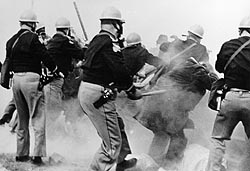 It has been 48 years since March 7, 1965, when 600 marchers, protesting the death of Jimmie Lee Jackson and ongoing exclusion from the electoral process were attacked by state and local police with billy clubs and tear gas as they walked across the Edmond Pettis Bridge going from Selma to Montgomery, Alabama. The first person to be beaten, who received a concussion and who was left unconscious by a blow from a police officer was John Lewis, later to become a U S Congressman. In those days he was a young adult who had been schooled in the methods of nonviolence, trained in the lessons of Ghandi, and inspired by the likes of Martin Luther King, Jr. Recalling those events nearly a half century later, Representative Lewis said, “I was prepared to accept the violence, the beating. I thought we were going to be arrested and simply taken to jail. I didn’t have any idea that we would be beaten . . . I thought I was going to die. I thought I saw death.”
It has been 48 years since March 7, 1965, when 600 marchers, protesting the death of Jimmie Lee Jackson and ongoing exclusion from the electoral process were attacked by state and local police with billy clubs and tear gas as they walked across the Edmond Pettis Bridge going from Selma to Montgomery, Alabama. The first person to be beaten, who received a concussion and who was left unconscious by a blow from a police officer was John Lewis, later to become a U S Congressman. In those days he was a young adult who had been schooled in the methods of nonviolence, trained in the lessons of Ghandi, and inspired by the likes of Martin Luther King, Jr. Recalling those events nearly a half century later, Representative Lewis said, “I was prepared to accept the violence, the beating. I thought we were going to be arrested and simply taken to jail. I didn’t have any idea that we would be beaten . . . I thought I was going to die. I thought I saw death.”
It was a moment of extraordinary courage. Representative Lewis’ book, “Across That Bridge: Life Lessons and a Vision for Change” tells the story from the perspective of time. It also reminds us that one of the elements of courage is the ability to put the needs of others ahead of one’s own personal safety: “But before, I guess, I lost consciousness, I became deeply concerned about the other people on the march. But in all of the years since, I’ve not had any sense of bitterness or ill feeling toward any of the people. I just don’t have it.”
It took the extraordinary courage of not just John Lewis but hundreds – even thousands of people who were willing to sacrifice their own comfort and safety in order to bring change to a nation whose leaders couldn’t yet deliver basic civil rights to all of the people. Despite more than 40 arrests, physical attacks, and serious injuries, John Lewis remained a devoted advocate of the philosophy of nonviolence. And he was accompanied on his walk by other persons of courage. The second Selma-to Montgomery march, just two days after John Lewis was beaten, brought out 2,500 people who turned around after crossing the Edmund Pettus Bridge. The third march began on March 16, and marchers reached Montgomery on March 24 and the Alabama State Capitol on March 25. The courage of the marchers was stronger than the weaponry of the authorities. The power of nonviolence was stronger than the blows of the billy clubs.
And there have been many more demonstrations of courage in my lifetime. Wars in Vietnam, the Persian Gulf, Iraq and Afghanistan, have yielded stories of great personal sacrifice and courage in the face of overwhelming violence.
We know that humans are capable of great courage. It is this knowledge, perhaps, that makes us so disappointed when we see dramatic failures of courage. Elected officials – good people who received the support of the majority of their fellow citizens – head off to Washington DC where they are somehow transformed into people who can see only their own self-interests. They cast votes influenced by the power of those who invest money in lobbying. They place their own re-elections and their aspirations for higher office above the good of the people they were elected to serve. They hear a simple threat that some donor might withdraw funding and they lose their spine and fail to do what is right. We have seen it over and over again. These failures of courage do not belong to a singular political party. They are not confined to a particular political viewpoint.
We don’t need our Senators to face physical violence, but once, just once, it would be so meaningful if one of them would have the courage to stand up to a lobbyist. Once, just once, it would be so powerful if one of them would put the interests of her or his constituency above the desires of the lobbyists. Once, just once, it would give others such inspiration if one Senator would do the right thing instead of the popular thing.
As dramatic as are the demonstrations of courage that we have witnessed, the failures of courage have also been dramatic. We have been witness to too many politicians whose aspirations for a political future always take precedence over doing the right thing in the present.
The current congress has been given the opportunity to make history by forging legislative compromises in at least three areas. The vast majority of Americans are in favor of meaningful legislation to decrease gun violence. They are not asking for an abrogation of Second Amendment rights, but rather for laws that address significant issues such as criminal background checks for gun ownership that are at least as stringent as those required for jobs.
This Congress has the opportunity to forge significant compromise on Immigration reform. The time is right and both the economy and the unnecessary suffering of innocents demand changes in existing law.
This Congress has the opportunity to reach compromise on the budget. The President has signaled willingness for meaningful cuts in expenditures and the reform of entitlements. An overwhelming majority of Americans, including the majority of those who would be affected by such a change, are in favor of the richest Americans paying the same tax rates as the middle class.
The timing is right for significant action. It would only take an ounce of courage and a pound of common sense. I’m willing to be hopeful. But meaningful change will require courage. And that is a commodity that is in very short supply in Washington D.C. these days.
 It has been 48 years since March 7, 1965, when 600 marchers, protesting the death of Jimmie Lee Jackson and ongoing exclusion from the electoral process were attacked by state and local police with billy clubs and tear gas as they walked across the Edmond Pettis Bridge going from Selma to Montgomery, Alabama. The first person to be beaten, who received a concussion and who was left unconscious by a blow from a police officer was John Lewis, later to become a U S Congressman. In those days he was a young adult who had been schooled in the methods of nonviolence, trained in the lessons of Ghandi, and inspired by the likes of Martin Luther King, Jr. Recalling those events nearly a half century later, Representative Lewis said, “I was prepared to accept the violence, the beating. I thought we were going to be arrested and simply taken to jail. I didn’t have any idea that we would be beaten . . . I thought I was going to die. I thought I saw death.”
It has been 48 years since March 7, 1965, when 600 marchers, protesting the death of Jimmie Lee Jackson and ongoing exclusion from the electoral process were attacked by state and local police with billy clubs and tear gas as they walked across the Edmond Pettis Bridge going from Selma to Montgomery, Alabama. The first person to be beaten, who received a concussion and who was left unconscious by a blow from a police officer was John Lewis, later to become a U S Congressman. In those days he was a young adult who had been schooled in the methods of nonviolence, trained in the lessons of Ghandi, and inspired by the likes of Martin Luther King, Jr. Recalling those events nearly a half century later, Representative Lewis said, “I was prepared to accept the violence, the beating. I thought we were going to be arrested and simply taken to jail. I didn’t have any idea that we would be beaten . . . I thought I was going to die. I thought I saw death.”It was a moment of extraordinary courage. Representative Lewis’ book, “Across That Bridge: Life Lessons and a Vision for Change” tells the story from the perspective of time. It also reminds us that one of the elements of courage is the ability to put the needs of others ahead of one’s own personal safety: “But before, I guess, I lost consciousness, I became deeply concerned about the other people on the march. But in all of the years since, I’ve not had any sense of bitterness or ill feeling toward any of the people. I just don’t have it.”
It took the extraordinary courage of not just John Lewis but hundreds – even thousands of people who were willing to sacrifice their own comfort and safety in order to bring change to a nation whose leaders couldn’t yet deliver basic civil rights to all of the people. Despite more than 40 arrests, physical attacks, and serious injuries, John Lewis remained a devoted advocate of the philosophy of nonviolence. And he was accompanied on his walk by other persons of courage. The second Selma-to Montgomery march, just two days after John Lewis was beaten, brought out 2,500 people who turned around after crossing the Edmund Pettus Bridge. The third march began on March 16, and marchers reached Montgomery on March 24 and the Alabama State Capitol on March 25. The courage of the marchers was stronger than the weaponry of the authorities. The power of nonviolence was stronger than the blows of the billy clubs.
And there have been many more demonstrations of courage in my lifetime. Wars in Vietnam, the Persian Gulf, Iraq and Afghanistan, have yielded stories of great personal sacrifice and courage in the face of overwhelming violence.
We know that humans are capable of great courage. It is this knowledge, perhaps, that makes us so disappointed when we see dramatic failures of courage. Elected officials – good people who received the support of the majority of their fellow citizens – head off to Washington DC where they are somehow transformed into people who can see only their own self-interests. They cast votes influenced by the power of those who invest money in lobbying. They place their own re-elections and their aspirations for higher office above the good of the people they were elected to serve. They hear a simple threat that some donor might withdraw funding and they lose their spine and fail to do what is right. We have seen it over and over again. These failures of courage do not belong to a singular political party. They are not confined to a particular political viewpoint.
We don’t need our Senators to face physical violence, but once, just once, it would be so meaningful if one of them would have the courage to stand up to a lobbyist. Once, just once, it would be so powerful if one of them would put the interests of her or his constituency above the desires of the lobbyists. Once, just once, it would give others such inspiration if one Senator would do the right thing instead of the popular thing.
As dramatic as are the demonstrations of courage that we have witnessed, the failures of courage have also been dramatic. We have been witness to too many politicians whose aspirations for a political future always take precedence over doing the right thing in the present.
The current congress has been given the opportunity to make history by forging legislative compromises in at least three areas. The vast majority of Americans are in favor of meaningful legislation to decrease gun violence. They are not asking for an abrogation of Second Amendment rights, but rather for laws that address significant issues such as criminal background checks for gun ownership that are at least as stringent as those required for jobs.
This Congress has the opportunity to forge significant compromise on Immigration reform. The time is right and both the economy and the unnecessary suffering of innocents demand changes in existing law.
This Congress has the opportunity to reach compromise on the budget. The President has signaled willingness for meaningful cuts in expenditures and the reform of entitlements. An overwhelming majority of Americans, including the majority of those who would be affected by such a change, are in favor of the richest Americans paying the same tax rates as the middle class.
The timing is right for significant action. It would only take an ounce of courage and a pound of common sense. I’m willing to be hopeful. But meaningful change will require courage. And that is a commodity that is in very short supply in Washington D.C. these days.
Copyright © 2013 by Ted Huffman. I wrote this. If you want to copy it, please ask for permission. There is a contact me button at the bottom of this page. If you want to share my blog a friend, please direct your friend to my web site.
Praying
17/04/13 05:27
A faithful church member recently told me that perhaps the congregation needed instruction on how to pray. The member suggested that perhaps a sermon series could provide information on prayer techniques, give sample prayers and teach people what to say or think when praying. Initially, I thought that the suggestion was a good idea, but then I began to think about how it might be implemented. What would I say? What instructions could be given? Where is the curriculum for such lessons?
I don’t think that there is any magic formula for prayer. Jesus, when asked, gave some commentary about not being too public with prayer. And he offered the words of The Lord’s Prayer for his followers to use. The Psalms are filled with examples of prayer and there are other stories of prayers throughout the Bible. But the simple truth is that prayer takes a lot of practice. It doesn’t always work. I follow regular disciplines of prayer and I find that sometimes my mind wanders. Sometimes I am less than focused on what God has to teach me. Often I don’t have words for my prayers.
The Rosary is a discipline for praying that is designed to assist faithful people in memorizing and retaining in memory certain principal events in the story of our people and to give thanks and praise to God. When praying the Rosary, the faithful make the sign of the cross, say the Apostles’ Creed, repeat the Lord’s Prayer, the Gloria, a Brief prayer called “Hail Mary,” and contemplate twenty events, one for each bead of the rosary. The events are grouped into four sets of five events to make memorization easier. The twenty events are:
The Annunciation
The Visit of Mary to Elizabeth
The Nativity
The Presentation of Jesus
Finding the Boy Jesus in the Temple
The Baptism of Jesus
The Wedding at Cana
Proclamations about the Kingdom of God
The Transfiguration
The Institution of the Eucharist or Holy Communion
Jesus’ Agony in the Garden
The Scourging of Jesus
The Crown of Thorns
Jesus Carrying the Cross
The Crucifixion
The Resurrection
The Ascension
The Gift of the Holy Spirit
The Assumption of Mary
The Reign of Christ
As prayer disciplines go, it isn’t a bad one. It does encourage the one praying to think beyond him or her self. However, like any discipline, it can be abused. Repetition sometimes causes diminished focus. Instead of the intended plan of thinking about the events in Jesus’ life and the story of our faith, ritual repetition can lead to repeating the words in one’s mind without paying attention to their meaning.
I find it valuable to mix up my prayer disciplines from time to time. But I was raised as a Protestant and did not grow up with Catholic traditions of prayer. It might be entirely different to those who grew up in the Catholic church or who have converted to that faith.
But I would like to encourage people to push deeper and to think about prayer in an entirely different manner. Before talking about that, however, I need to make an observation. People pray naturally. As they go through their lives. There are three major types of prayer that come to people even when they have had no religious training. I think of these three types of prayer as developmental. One comes more naturally to children, another to teens and young adults and the third to those who have some age and experience. Sometimes I think of them as three seasons of prayer:
The first season is supplication. We ask for things that we want. A child will think to her or himself, “Please, please, please, I want (desired item) for Christmas or for a Birthday.” This kind of praying often has some kind of magical element. The child thinks that if they wish hard enough or pray often enough their wish will somehow magically be granted. It is not uncommon for prayers like this to be impossible requests. People sometimes think they are praying for miracles when the request is really for a suspension of the laws of physics or the granting of a life without suffering or the escape from grief. Sometimes these prayers can seem very serious to the one praying and a bit silly from an outside perspective.
The second season of prayer is prayer for salvation. At its core, a prayer for salvation is something that every teenager thinks quite naturally, “Get me out of here!” It is a request to escape from one’s immediate circumstances. These prayers can be very serious in the case of those who are suffering persecution or oppression or injustice. It is a request for outside intervention to change the circumstances of this life. Often such prayers begin with a focus on problems or difficulties and continue to an imagined better set of circumstances. Such a prayer can have a sort of “make my wishes come true” quality.
The third season of prayer is simply and expression of gratitude. There are moments when one is overcome with thanksgiving. Life can be very good. People can be very loving. Families and communities can be richly supportive. There is much in this life that is filled with joy. I find that as I age, this prayer comes to me more frequently and more naturally than was the case when I was younger. I don’t know if that experience is unique to me, but I don’t think so.
Having introduced those three seasons of prayer, I want to state simply that prayer is different from our perspective than it is from God’s point of view. We think that there are times when we are praying and others when we are not. We set aside time for prayers and follow schedules, routines and disciplines. So it seems to us that we “pause” for prayer or take time for prayer or go to prayers. But God is always listening, always interested. From God’s perspective there is no time when we are not praying. I think it was Henri Nouwen who said, “All real living is praying.”
The deepest and most sincere prayer we can offer is not in the words we say, but in the life we live.
I don’t think that there is any magic formula for prayer. Jesus, when asked, gave some commentary about not being too public with prayer. And he offered the words of The Lord’s Prayer for his followers to use. The Psalms are filled with examples of prayer and there are other stories of prayers throughout the Bible. But the simple truth is that prayer takes a lot of practice. It doesn’t always work. I follow regular disciplines of prayer and I find that sometimes my mind wanders. Sometimes I am less than focused on what God has to teach me. Often I don’t have words for my prayers.
The Rosary is a discipline for praying that is designed to assist faithful people in memorizing and retaining in memory certain principal events in the story of our people and to give thanks and praise to God. When praying the Rosary, the faithful make the sign of the cross, say the Apostles’ Creed, repeat the Lord’s Prayer, the Gloria, a Brief prayer called “Hail Mary,” and contemplate twenty events, one for each bead of the rosary. The events are grouped into four sets of five events to make memorization easier. The twenty events are:
The Annunciation
The Visit of Mary to Elizabeth
The Nativity
The Presentation of Jesus
Finding the Boy Jesus in the Temple
The Baptism of Jesus
The Wedding at Cana
Proclamations about the Kingdom of God
The Transfiguration
The Institution of the Eucharist or Holy Communion
Jesus’ Agony in the Garden
The Scourging of Jesus
The Crown of Thorns
Jesus Carrying the Cross
The Crucifixion
The Resurrection
The Ascension
The Gift of the Holy Spirit
The Assumption of Mary
The Reign of Christ
As prayer disciplines go, it isn’t a bad one. It does encourage the one praying to think beyond him or her self. However, like any discipline, it can be abused. Repetition sometimes causes diminished focus. Instead of the intended plan of thinking about the events in Jesus’ life and the story of our faith, ritual repetition can lead to repeating the words in one’s mind without paying attention to their meaning.
I find it valuable to mix up my prayer disciplines from time to time. But I was raised as a Protestant and did not grow up with Catholic traditions of prayer. It might be entirely different to those who grew up in the Catholic church or who have converted to that faith.
But I would like to encourage people to push deeper and to think about prayer in an entirely different manner. Before talking about that, however, I need to make an observation. People pray naturally. As they go through their lives. There are three major types of prayer that come to people even when they have had no religious training. I think of these three types of prayer as developmental. One comes more naturally to children, another to teens and young adults and the third to those who have some age and experience. Sometimes I think of them as three seasons of prayer:
The first season is supplication. We ask for things that we want. A child will think to her or himself, “Please, please, please, I want (desired item) for Christmas or for a Birthday.” This kind of praying often has some kind of magical element. The child thinks that if they wish hard enough or pray often enough their wish will somehow magically be granted. It is not uncommon for prayers like this to be impossible requests. People sometimes think they are praying for miracles when the request is really for a suspension of the laws of physics or the granting of a life without suffering or the escape from grief. Sometimes these prayers can seem very serious to the one praying and a bit silly from an outside perspective.
The second season of prayer is prayer for salvation. At its core, a prayer for salvation is something that every teenager thinks quite naturally, “Get me out of here!” It is a request to escape from one’s immediate circumstances. These prayers can be very serious in the case of those who are suffering persecution or oppression or injustice. It is a request for outside intervention to change the circumstances of this life. Often such prayers begin with a focus on problems or difficulties and continue to an imagined better set of circumstances. Such a prayer can have a sort of “make my wishes come true” quality.
The third season of prayer is simply and expression of gratitude. There are moments when one is overcome with thanksgiving. Life can be very good. People can be very loving. Families and communities can be richly supportive. There is much in this life that is filled with joy. I find that as I age, this prayer comes to me more frequently and more naturally than was the case when I was younger. I don’t know if that experience is unique to me, but I don’t think so.
Having introduced those three seasons of prayer, I want to state simply that prayer is different from our perspective than it is from God’s point of view. We think that there are times when we are praying and others when we are not. We set aside time for prayers and follow schedules, routines and disciplines. So it seems to us that we “pause” for prayer or take time for prayer or go to prayers. But God is always listening, always interested. From God’s perspective there is no time when we are not praying. I think it was Henri Nouwen who said, “All real living is praying.”
The deepest and most sincere prayer we can offer is not in the words we say, but in the life we live.
Copyright © 2013 by Ted Huffman. I wrote this. If you want to copy it, please ask for permission. There is a contact me button at the bottom of this page. If you want to share my blog a friend, please direct your friend to my web site.
Food From Around the World
16/04/13 05:28
We live in a world culture. Even in relatively remote Rapid City we see increasing influences from other places on the way we conduct our lives. There was a time when eating out in Rapid City was a choice between a good steak house and an excellent home cooked meal. These days there are a lot more options. Seafood, Italian, Chinese, Vietnamese, Thai, Indian, Japanese, including Sushi, Korean, Nepalese, Mexican, specialty sandwich shops, micro-brewed beer, coffee shops galore, a couple of Buffalo wings restaurants, bagels, specialty bakeries, health food, vegetarian, buffets, Irish, different varieties of ice cream and frozen yogurt, smoothies, pizzas in lots of different styles including “Colorado Style Pizza” whatever that is, sports bars, donut shops, fast food restaurants of every stripe, and a lot more. One Internet directory lists 220 restaurants in Rapid City – about the same number as the count of churches. You can still find a good steak house and a nearly home cooked meal. Times are changing. There are more choices and more influence from outside of our area when it comes to eating.
There are a few foods that are still difficult to find in our town. It’s a bit of a challenge to find Vegemite, for example. We first heard of Vegemite when we became close to a family from Australia during our seminary days. After a few months in the United States, they began to miss the dark brown food paste. After more than a year, they would occasionally wax poetically about how good Vegemite tastes spread on toast. From their descriptions, I imagined something like peanut butter, a food that was in nearly constant supply around our house. Now, having visited Australia, I can say that Vegemite is definitely an acquired taste. It is made from used brewer’s yeast. It is very salty. Perhaps its flavor is enhanced by drinking more beer, or by growing up singing the song:
 We’re happy little Vegemites, as bright as bright can be,
We’re happy little Vegemites, as bright as bright can be,
We all enjoy our Vegemite for breakfast, lunch and tea,
Our mummies say we’re growing stronger every single week,
Because we love our Vegemite,
We all adore our Vegemite,
It puts a rose in every cheek.
Of course these days, our friends would not have to miss their Vegemite. It is only a click and a $10 charge to your credit card away on the Internet. I can have it delivered to your house before 10 tomorrow morning.
But I don’t think you can find it on the shelves in Safeway or Family Thrift or Wal-Mart in Rapid City.
I don’t think you’ll find goose grease in jars on the shelves of the stores in our town, either. We don’t eat all that many geese, come to think of it. We sing, “Christmas is coming, the goose is getting fat,” and then sit down to turkey for Christmas Dinner. Goose grease, however, isn’t really needed for cooking a goose. The goose provides enough fat on its own. I suppose it could be used for basting the bird. There are some purists who use goose grease for basting chickens and swear that it adds to the flavor, buy it is a taste distinction that I’m not sure I would catch. If you come from some parts of the British Isles, however, you need goose grease to make a proper Yorkshire pudding. I have heard of those who use duck fat in their Yorkshire puddings, but for those who take their British cooking seriously, there is no substitute for goose grease. In hard times and periods of national disaster, some Britains have eaten Yorkshire Puddings flavored with beef drippings or even lard. Only goose grease, however, provides the proper crisp outside, soft inside and distinct flavor variation for serving with roast beef.
 You can buy a jar of goose grease off of the Internet for less than $10.
You can buy a jar of goose grease off of the Internet for less than $10.
I actually don’t know the first thing about British cooking and the proper use of goose grease. I thought that it is just a good thing to know just in case I one day develop an insatiable craving for steak and kidney pie. Really, I just like the sound of “goose grease” and find it fun to right and say the words over and over. Proper cooks probably call it goose fat.
Here in Rapid City, you’ll do a bit better shopping for ingredients to make foods that originate closer to home. Most of our stores have an aisle of Mexican and pseudo-Mexican food ingredients. You can purchase dried corn husks to make tamales and all of the proper spices, chilies and other ingredients.
Canadian cuisine is a bit harder to put your finger on, but there are ingredients for a lot of different French foods in most of our supermarkets. Add in some basic British foods even without goose grease and add a dollop of Maple Syrup and you could probably pass off your cooking as at least having been influenced by our north of the border neighbors. Grab some basic beef gravy and a few cheese curds and mix them in with some French fries and you can call it Poutine and they’ll think you were born there. OK, maybe I’m simplifying things a bit.
Our grocery stores do have most of the ingredients, spices and herbs for Italian cooking and you can find the foods to follow the basic recipes in a Greek cookbook. There is also an Oriental market and Curry Masala restaurant has a shelf of spices and other ingredients to make curries and other Indian foods.
Modern advances in travel and shipping have made the world seem a bit smaller and distant neighbors a bit closer than was the case a few decades ago. It makes sense that our options for eating have changed with the times. I suspect, however, that it may take a while longer for our palates to become discriminating enough to catch all of the differences between say Nepalese and Indian cooking.
 All of which reminds me that I’m responsible for the snack at our Tuesday book club meeting this morning. Hmm . . . Jerry’s Donuts always hits the spot.
All of which reminds me that I’m responsible for the snack at our Tuesday book club meeting this morning. Hmm . . . Jerry’s Donuts always hits the spot.
There are a few foods that are still difficult to find in our town. It’s a bit of a challenge to find Vegemite, for example. We first heard of Vegemite when we became close to a family from Australia during our seminary days. After a few months in the United States, they began to miss the dark brown food paste. After more than a year, they would occasionally wax poetically about how good Vegemite tastes spread on toast. From their descriptions, I imagined something like peanut butter, a food that was in nearly constant supply around our house. Now, having visited Australia, I can say that Vegemite is definitely an acquired taste. It is made from used brewer’s yeast. It is very salty. Perhaps its flavor is enhanced by drinking more beer, or by growing up singing the song:

We all enjoy our Vegemite for breakfast, lunch and tea,
Our mummies say we’re growing stronger every single week,
Because we love our Vegemite,
We all adore our Vegemite,
It puts a rose in every cheek.
Of course these days, our friends would not have to miss their Vegemite. It is only a click and a $10 charge to your credit card away on the Internet. I can have it delivered to your house before 10 tomorrow morning.
But I don’t think you can find it on the shelves in Safeway or Family Thrift or Wal-Mart in Rapid City.
I don’t think you’ll find goose grease in jars on the shelves of the stores in our town, either. We don’t eat all that many geese, come to think of it. We sing, “Christmas is coming, the goose is getting fat,” and then sit down to turkey for Christmas Dinner. Goose grease, however, isn’t really needed for cooking a goose. The goose provides enough fat on its own. I suppose it could be used for basting the bird. There are some purists who use goose grease for basting chickens and swear that it adds to the flavor, buy it is a taste distinction that I’m not sure I would catch. If you come from some parts of the British Isles, however, you need goose grease to make a proper Yorkshire pudding. I have heard of those who use duck fat in their Yorkshire puddings, but for those who take their British cooking seriously, there is no substitute for goose grease. In hard times and periods of national disaster, some Britains have eaten Yorkshire Puddings flavored with beef drippings or even lard. Only goose grease, however, provides the proper crisp outside, soft inside and distinct flavor variation for serving with roast beef.

I actually don’t know the first thing about British cooking and the proper use of goose grease. I thought that it is just a good thing to know just in case I one day develop an insatiable craving for steak and kidney pie. Really, I just like the sound of “goose grease” and find it fun to right and say the words over and over. Proper cooks probably call it goose fat.
Here in Rapid City, you’ll do a bit better shopping for ingredients to make foods that originate closer to home. Most of our stores have an aisle of Mexican and pseudo-Mexican food ingredients. You can purchase dried corn husks to make tamales and all of the proper spices, chilies and other ingredients.
Canadian cuisine is a bit harder to put your finger on, but there are ingredients for a lot of different French foods in most of our supermarkets. Add in some basic British foods even without goose grease and add a dollop of Maple Syrup and you could probably pass off your cooking as at least having been influenced by our north of the border neighbors. Grab some basic beef gravy and a few cheese curds and mix them in with some French fries and you can call it Poutine and they’ll think you were born there. OK, maybe I’m simplifying things a bit.
Our grocery stores do have most of the ingredients, spices and herbs for Italian cooking and you can find the foods to follow the basic recipes in a Greek cookbook. There is also an Oriental market and Curry Masala restaurant has a shelf of spices and other ingredients to make curries and other Indian foods.
Modern advances in travel and shipping have made the world seem a bit smaller and distant neighbors a bit closer than was the case a few decades ago. It makes sense that our options for eating have changed with the times. I suspect, however, that it may take a while longer for our palates to become discriminating enough to catch all of the differences between say Nepalese and Indian cooking.

Copyright © 2013 by Ted Huffman. I wrote this. If you want to copy it, please ask for permission. There is a contact me button at the bottom of this page. If you want to share my blog a friend, please direct your friend to my web site.
Moving Pianos
15/04/13 02:29
We moved a grand piano yesterday. It seems like I am often involved in moving pianos. I am not a professional piano mover, but I’ve been involved in the process enough times to understand it. A grand piano is moved by being gently tipped onto one side and strapped to a moving board that is attached to dollies. The legs and lyre are removed. Everything is carefully covered with furniture pads and the piano is rolled. A 9’ concert grand piano weighs 1,000 to 1,200 pounds. That means that you don’t really lift it very often. When you do need to lift it, it takes 10 to 12 people to do so. Using levers and dollies, a crew of four to six persons can move a concert grand safely unless it has to go up or down stairs that cannot be bridged with a ramp.
There are three concert grand pianos in our town. One spends its life at the Civic Center and belongs to the Rapid City Concert Association. Another lives at and belongs to our church. A third has been provided for our community by a generous donor and travels from venue to venue as needed. That’s the piano we moved yesterday. There is a fourth concert grand that is in private ownership in a nearby community.
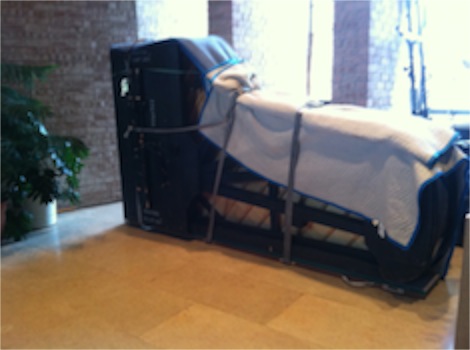 Piano movers usually talk about Liberace’s piano. He played on a custom-made piano that had to be moved for each of his performances. It was 12 feet long and weighted 1500 pounds. It was three feet longer than a standard concert grand piano because he wanted the longer bass strings that would provide louder and more resonate bass pitches. The longer the length, the better a wound string resonates. Most of the weight of a piano comes from the cast iron harp that holds the strings. The wood furniture that surrounds the harp is usually finished with a shiny lacquer and can easily be scratched or damaged if the move is not done properly. Pianos can be permanently damaged by being twisted or suffering falls, though despite all of the sit-com storylines, pianos are rarely dropped. A good piano mover knows how to move the instrument safely.
Piano movers usually talk about Liberace’s piano. He played on a custom-made piano that had to be moved for each of his performances. It was 12 feet long and weighted 1500 pounds. It was three feet longer than a standard concert grand piano because he wanted the longer bass strings that would provide louder and more resonate bass pitches. The longer the length, the better a wound string resonates. Most of the weight of a piano comes from the cast iron harp that holds the strings. The wood furniture that surrounds the harp is usually finished with a shiny lacquer and can easily be scratched or damaged if the move is not done properly. Pianos can be permanently damaged by being twisted or suffering falls, though despite all of the sit-com storylines, pianos are rarely dropped. A good piano mover knows how to move the instrument safely.
I love piano music. And lovers of the music sometimes need to work for the joy of sound. On Saturday evening Dakota Pianist Eugene Gienger played the Brahms 2nd Piano Concerto with the Black Hills Symphony Orchestra at the Civic Center. The community’s moving piano was moved to the Civic Center and used for the concert. A gifted pianist needs just the right instrument and Mr. Gienger has provided the inspiration that brought the 9’ Yamaha piano to our community, so it was appropriate for him to play that particular piano. With the concert over, the piano needed to be moved from the Civic Center.
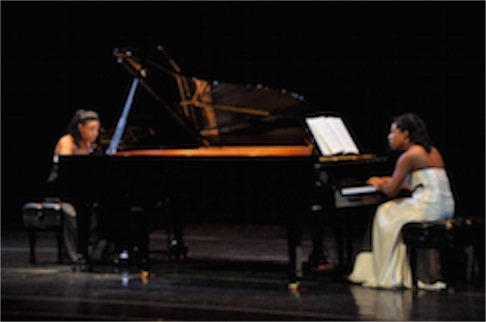 The next scheduled use of the piano is an exciting concert at our church in two weeks, on April 28, when Caribbean-American pianists Michelle and Kimberly Cann will play on two 9’ grand concert pianos. So into our sanctuary the piano came. It will be with us for two weeks before moving on to its next venue after the duo piano performance.
The next scheduled use of the piano is an exciting concert at our church in two weeks, on April 28, when Caribbean-American pianists Michelle and Kimberly Cann will play on two 9’ grand concert pianos. So into our sanctuary the piano came. It will be with us for two weeks before moving on to its next venue after the duo piano performance.
I am sure that concert goers will be thrilled as the exciting duo performs works by Lutoslawski, Ravel, Delores White and Rachmaninoff.
But moving the piano yesterday was far from the most important encounter with an instrument of the day for me. As much as we enjoy concerts and brilliant artists, the instruments in our sanctuary, including our concert piano are called to a higher purpose. We have worked hard to have instruments in our sanctuary that are matched to the size and acoustical properties of the room. We are deeply committed to music as an expression of worship. Like other elements of worship, we belive in bringing the best that we have to offer before God.
Yesterday we teamed up with our own church member and pianist Justin Speck, Brother Emil from the Taizé monastery in France, Rev. Steve Miller from Vermillion, and a young man from Deadwood currently studying at USD in Vermillion to offer prayers in the midst of our congregation. The prayers were offered in congregational song, in words, in silence and in jazz piano improvisation. As is true with much worship in our sanctuary, the process involves the collaboration of many different worship leaders and no small amount of inspiration from the Holy Spirit.
I am deeply grateful for the opportunity to share worship leadership with so many talented persons. Each week, I work with a gifted organist, an imaginative and experienced choir director, a talented bell choir director, other pastors, a dedicated administrative colleague and dedicated lay leaders to produce worship. There is a lot of behind the scenes work that is required for an hour of worship. But worship cannot be forced. It must be allowed to flow. People need to trust one another and listen carefully to each other and to the congregation in order for worship that is meaningful to emerge.
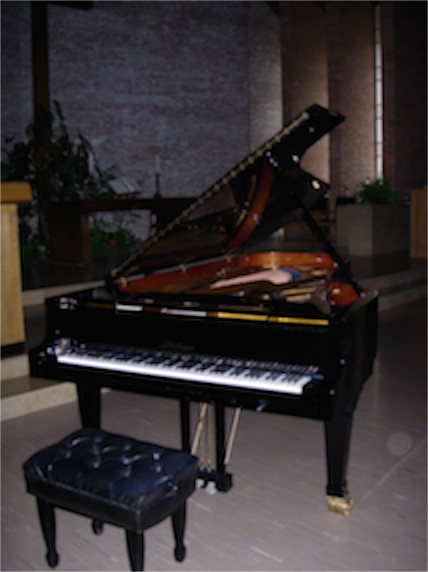 Yesterday was a day when all of that hard work faded into the background. The muscle power of moving pianos was forgotten. The hours of practice were behind. The planning and collaboration were completed. We took a deep breath, said our prayers and began our worship service. As is our custom we were led into the sanctuary by our children. The candles were lit, the congregation sang and we listened together to the scriptures. Our lay liturgist was well prepared and read beautifully. The time came to began our jazz of piano and spoken word. The Holy entered our lives and the timing worked perfectly. We didn’t have to look at or signal one another. It was as if we were speaking with one voice. The congregation didn’t need to be told when to sing, they sensed it from the flow of music and word. I’m just glad I was there to experience it all.
Yesterday was a day when all of that hard work faded into the background. The muscle power of moving pianos was forgotten. The hours of practice were behind. The planning and collaboration were completed. We took a deep breath, said our prayers and began our worship service. As is our custom we were led into the sanctuary by our children. The candles were lit, the congregation sang and we listened together to the scriptures. Our lay liturgist was well prepared and read beautifully. The time came to began our jazz of piano and spoken word. The Holy entered our lives and the timing worked perfectly. We didn’t have to look at or signal one another. It was as if we were speaking with one voice. The congregation didn’t need to be told when to sing, they sensed it from the flow of music and word. I’m just glad I was there to experience it all.
I took years of piano lessons, but have never mastered the instrument. There are some who have learned to play the piano and that is a gift and a pleasure. There are a few who have mastered technique and artistry sufficiently to become concert performers. Their gifts of music enrich us all. And there are a few more, a small group of artists, who go beyond playing the instrument. Yesterday we were in the presence of one who prayed the piano.
If I have to help move a hundred more pianos in the time that is given me, the work will be nothing in comparison to that moment of prayer we shared yesterday. Some things in life are simply worth all of the work.
There are three concert grand pianos in our town. One spends its life at the Civic Center and belongs to the Rapid City Concert Association. Another lives at and belongs to our church. A third has been provided for our community by a generous donor and travels from venue to venue as needed. That’s the piano we moved yesterday. There is a fourth concert grand that is in private ownership in a nearby community.

I love piano music. And lovers of the music sometimes need to work for the joy of sound. On Saturday evening Dakota Pianist Eugene Gienger played the Brahms 2nd Piano Concerto with the Black Hills Symphony Orchestra at the Civic Center. The community’s moving piano was moved to the Civic Center and used for the concert. A gifted pianist needs just the right instrument and Mr. Gienger has provided the inspiration that brought the 9’ Yamaha piano to our community, so it was appropriate for him to play that particular piano. With the concert over, the piano needed to be moved from the Civic Center.

I am sure that concert goers will be thrilled as the exciting duo performs works by Lutoslawski, Ravel, Delores White and Rachmaninoff.
But moving the piano yesterday was far from the most important encounter with an instrument of the day for me. As much as we enjoy concerts and brilliant artists, the instruments in our sanctuary, including our concert piano are called to a higher purpose. We have worked hard to have instruments in our sanctuary that are matched to the size and acoustical properties of the room. We are deeply committed to music as an expression of worship. Like other elements of worship, we belive in bringing the best that we have to offer before God.
Yesterday we teamed up with our own church member and pianist Justin Speck, Brother Emil from the Taizé monastery in France, Rev. Steve Miller from Vermillion, and a young man from Deadwood currently studying at USD in Vermillion to offer prayers in the midst of our congregation. The prayers were offered in congregational song, in words, in silence and in jazz piano improvisation. As is true with much worship in our sanctuary, the process involves the collaboration of many different worship leaders and no small amount of inspiration from the Holy Spirit.
I am deeply grateful for the opportunity to share worship leadership with so many talented persons. Each week, I work with a gifted organist, an imaginative and experienced choir director, a talented bell choir director, other pastors, a dedicated administrative colleague and dedicated lay leaders to produce worship. There is a lot of behind the scenes work that is required for an hour of worship. But worship cannot be forced. It must be allowed to flow. People need to trust one another and listen carefully to each other and to the congregation in order for worship that is meaningful to emerge.

I took years of piano lessons, but have never mastered the instrument. There are some who have learned to play the piano and that is a gift and a pleasure. There are a few who have mastered technique and artistry sufficiently to become concert performers. Their gifts of music enrich us all. And there are a few more, a small group of artists, who go beyond playing the instrument. Yesterday we were in the presence of one who prayed the piano.
If I have to help move a hundred more pianos in the time that is given me, the work will be nothing in comparison to that moment of prayer we shared yesterday. Some things in life are simply worth all of the work.
Copyright © 2013 by Ted Huffman. I wrote this. If you want to copy it, please ask for permission. There is a contact me button at the bottom of this page. If you want to share my blog a friend, please direct your friend to my web site.
TED talks and Ted's talks
14/04/13 05:15

From time to time I watch a few TED Talks. Technology, Entertainment and Design (TED) is a global set of conferences owned by the private non-profit Sapling Foundation. The foundation is dedicated to “ideas worth spreading.” The first conference, held in 1984, was intended to be a one-time event. It featured demonstrations of the Sony compact disc and the Apple Macintosh computer. The event was such a success that other similar events were organized and by 1990, there were some dedicated TEDers (or is that TEDists? Or TEDsters?). Most of us didn’t hear much about the conferences until they started making the videos of the presentations free to the public in 2006. There are now annual prizes, TED conferences held around the world and even a spin off called TEDx, which is a license granted to a third party to organize independent TED-like events.
The TED web site adds 5 or so new videos each week of mostly dynamic speakers, usually with a few video and audio tricks. The basic format is a speaker standing in front of a projection screen speaking without visible notes. Of course there are monitors, and other ways for speakers to see notes. The presentations are, for the most part, highly rehearsed. The basic format is an 18-minute talk. The web site TED.com/talks has hundreds of talks and features the lists of favorite talks of famous people.
As I preacher, I am a bit fascinated by the phenomena. It is so close to a traditional sermon that I’ve sometimes called TED talks “sermons for people who don’t go to church.” They are often expressions of passions and beliefs. They are occasionally tirades against religion by people who don’t know what religion is. I often find people who aren’t involved in churches to have a lot of inaccurate ideas about what we do and what we believe. TED talks are strong on charts and grafts and references to scientific research. Articles published in scientific journals are used much as scripture is used in a traditional sermon.
If you’ve never been to the web site, I think you will find it interesting. It is likely that you will find several talks that are not only well delivered, but also inspirational. They say that there have been over a billion views of TED talks worldwide.
Watching a lot of TED talks, however, reveals that there is a formula to the talks. After a while they get to be a bit boring and you find your mind wandering – not unlike the practice of attending the same church and listening to the same preacher week after week. You begin to anticipate what is going to be said. You detect themes that are repeated. You find occasional surprises, but not every talk is as impressive or as stellar as the first one you watched. And, occasionally, you find an idea with which you disagree, a mistake or a misspoken illustration, and occasionally an idea that isn’t quite worthy of such a big audience.
What is interesting to me is how often the speakers think that they are doing something really innovative and new and how often it seems to me that they are espousing ideas that have direct links to the ideas of others. Being an amateur philosopher, I’ve read enough of the history of philosophy to have a sense that ideas tend to fall into groups and categories and that we rarely think thoughts that haven’t previously occurred to someone else. From that perspective, I prefer to be a preacher to being a TED presenter. I get a chance to get up in front of the congregation week after week. I am able to wrestle with ideas that are too big for a single session. I am able to revisit themes and develop them in new directions. I can even admit mistakes and try out different perspectives.
Back in the 1830’s Ralph Waldo Emerson drifted away from the church and began delivering public lectures aimed at a wider audience. He achieved a great deal of fame and by the 1850’s he was giving as many as 80 lectures a year. Soon there were lecture circuits springing up all over the country. The Chautauqua Institute was founded and then imitated across the country as a kind of model of public education. TED talks are not a new phenomena, but rather a new step in a long tradition of persuading people by talking.
I’m not sure how I feel about a corporation, albeit a non-profit corporation with many donors and lofty ideals, having copyrighted my name. It has been a good name for me and for many members of previous generations of my family. I suspect that they don’t mind my continuing to use it and I have no inclination to start calling my sermons “TED talks.”
But I am interested in the popularity of the talks. I kind of appreciate it when friends and colleagues send me links or recommend I listen to particular talks. I learn a lot about the craft of preaching by listening and watching other speakers. And I gain ideas through many different media, but listening to speakers is one of the ways that I enjoy learning. And there are many ideas in TED talks that are worth sharing, just like the web site proclaims. Furthermore, I think that there are a few too many people in our country who rarely listen to speakers who have ideas that are new to them or different than ones they have already heard. We in this country especially, are a bit too likely to listen to and read only ideas with which we agree. Disagreement can be a good teacher. And knowing what others are thinking can be a good way to overcome barriers and bridge differences.
Despite the decline in membership of mainline denominations, preaching is not a dead art. It is being practiced both within and outside of the church. I am not personally drawn to the public lecture circuit. I am grateful for my role within the institutional church.
And, unlike TED presenters, I am not a slave to the 18-minute format. Most weeks I preach a sermon that is considerably shorter. Some weeks I go over that limit.
You’ll have to come to church to find out what I will say today. The sermon won’t be available on YouTube.
Copyright © 2013 by Ted Huffman. I wrote this. If you want to copy it, please ask for permission. There is a contact me button at the bottom of this page. If you want to share my blog a friend, please direct your friend to my web site.
Pilgrimage of Trust
13/04/13 05:25
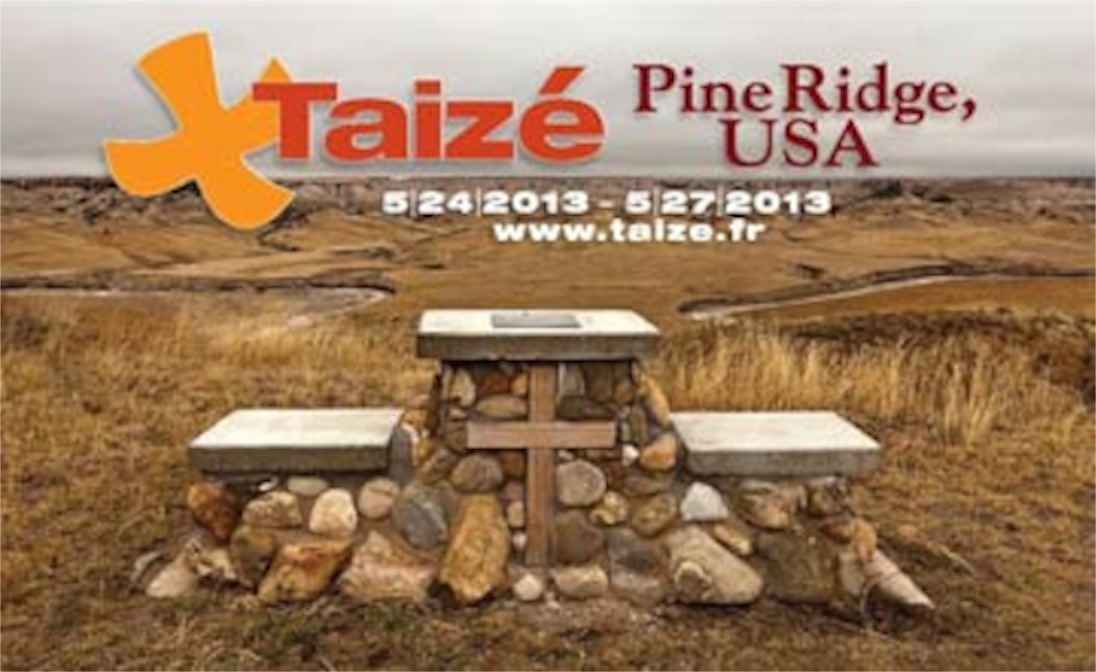
The brothers of the Taizé Community in France have begun to anticipate an important anniversary for their community. In 2015, the community will celebrate its 75th anniversary. The year is also the 100the anniversary of the Brother Roger’s birth. For some communities, it would be an opportunity for a grand celebration of the history and roots of the movement. The centennial of the birth of a founder combined with a diamond jubilee would provide an opportunity to look back. But it is not so with Taizé. One of the differences can be found in the numeric of the year 2015: Brother Roger was only 25 years old when Taizé was founded. The movement has been, from its beginning, a movement of young adults.
It is often true in the story of Christianity that elders are led by those who are younger. From our very roots, Jesus taught us to value children and youth and to understand that they have qualities and values that are essential to a mature faith. Jesus said: “Truly I tell you, unless you change and become like little children, you will never enter the kingdom of heaven.” It has always been true that a life of faith values and listens to those who are younger.
So, in anticipation of 2015, Brother Alois, leader of the Taizé Community, wrote a letter inviting Christians of all denominations and affiliations to join together to embody a new solidarity as we move together. He began his letter with these words:
“For a new solidarity among human beings to spring up at all levels – in families, communities, towns and villages, between countries and continents – courageous decisions are needed. Aware of the perils and the suffering that weigh upon humanity and the planet, we do not want to give in to fear and resignation. And yet a fine human hope is constantly threatened by disenchantment. Economic difficulties which are increasingly burdensome, the sometimes overwhelming complexity of societies, and helplessness in the face of natural disasters all tend to stifle the fresh shoots of hope. To create new forms of solidarity, could the time have come to make a greater effort to uncover the wellsprings of trust?
“No human being, no society can live without trust. When trust has been betrayed, the wounds leave marks that go deep. Trust is not blind gullibility; it is not a facile word. It is the result of a choice, the fruit of an inner struggle. Each day we are called to set out once more from worry towards trusting.”
The letter goes on to outline a vision of a “pilgrimage of trust on earth” searching for ways to put into practice the quest for solidarity and trust. That pilgrimage has led some of the brothers of the Taizé to our community. Brother Emil will be joining our congregation in worship on Sunday.
It is hard to say where this particular journey began. Maybe it began 15 years ago when a small group of people gathered for worship in the style of Taizé at the 1st Congregational Church in Vermillion. The gathering welcomed students from the University of South Dakota. A small group of youth and adults from our congregation were able to join in that worship once in the summer of 1998. From that simple practice of worship, in 2009, a group of University Students, including two Lakota men, made a pilgrimage to Taizé in France. The Taizé movement was strong and well established, and had welcomed young adults from around the world, but had not yet built significant relationships with Native Americans.
That visit led to a return visit from a brother of the Taizé community to Pine Ridge in the summer of 2010 and again in 2011. Last summer the visit lasted a week with the brother staying with the Two Bulls family on Red Shirt Table. A vision of the extension of the pilgrimage of trust began to form in the minds of the brothers of Taizé and the Lakota leaders. This year, on May 24 through 27, the brothers of the Taizé will make a pilgrimage to Red Shirt Table. They have invited young people aged 18 – 35 to join them for Bible study, workshops, small groups sharing, meals together and worship outdoors on Red Shirt Table. People from around the world will be coming. Hundreds of participants will reach beyond the boundaries of language and culture to pray, study and live in community.
Last night was another step on the journey. Two of the brothers of the Taizé arrived in Rapid City yesterday and a small community of people from across our state gathered for a simple meal, conversation and worship. As we sat in the worship space of The Well, Susan and I remembered our experience of worship in the style of Taizé back in the summer of 1998. The 15 to 18 year-olds who were with us on that particular trip are now 30 to 40 year olds. Time passes. We all grow older.
Now is a good time to cross the boundaries that separate us. Neither the romantic image of Native American people drawn in novels and movies, nor the stories of unremitting poverty, violence and despair paint an accurate picture of our neighbors. Warm hospitality, loving individuals, quiet faithfulness and deep spirituality are parts of the Lakota story that we hear only when we take time to listen carefully and deeply. As Brother Alois said, “Only be coming together beyond our differences in a climate of prayer and sharing can we find new ways forward.”
I am now too old to register for the young adults’ event. But I am not too old to serve the community, to help with logistics and details, and most importantly to join in the prayers. One of the advantages of my age is that I can remember other significant moments of prayer and see the connections between the prayers of 15 years ago and those we share today.
Something very important and very exciting is happening right in our own backyard. Surely God is doing a new thing and we have been invited to witness God at work. It all began in prayer. It continues in prayer.
Copyright © 2013 by Ted Huffman. I wrote this. If you want to copy it, please ask for permission. There is a contact me button at the bottom of this page. If you want to share my blog a friend, please direct your friend to my web site.
When technology doesn't advance
12/04/13 04:41
Over the years I have been quick to judge the medical profession. Out of control rises in health care costs are strangling our economy, precipitating a national budget crisis and there is virtually no evidence that all of the money invested in health care has much of a payoff. While nearly 80% of all health care dollars are spend in the last year of life, hospital mortality rates have remained unchanged for 30 years. While there have been some dramatic breakthroughs in care of specific illnesses and there is anecdotal evidence of dramatic treatments for heart disease and cancer the medical profession continues to steadily march toward increased specialization and less bedside manner. It is so difficult to find general practitioners, now called family practice specialists, that the majority of Americans now cannot identify their primary care provider, but instead either leave that question blank or put the name of a group practice when asked.
The joke that is told – at least I hope it is a joke – that a man is admitted to the emergency room of a level 1 trauma center. It takes a CT scan, a consulting radiologist and an orthopedic consultation to determine that he has only one leg and was wearing a prosthetic leg when admitted. What makes the joke work is our fear that the specialists in an emergency room would fail to recognize the obvious.
The new “paperless” medical records mean that our physicians now spend their time looking at a computer screen when they are in the examining room and rarely make eye contact with us. One study indicated that the average length of time before a physician interrupts a patient’s conversation in an examining room is 18 seconds. Medical histories used to be conveyed by storytelling. Now they are contained on forms and in computers. A patient admitted to a hospital will spend more time reporting their date of birth repeatedly than they will have actual contact with a physician. The doctors spend the bulk of their time with the computers.
 What we have gotten for all of the investment in contemporary medicine is more technology.
What we have gotten for all of the investment in contemporary medicine is more technology.
Now I am no Luddite. I face my computer screen every day. When my computer develops a problem it is repaired or replace the same day that it fails. I use a smartphone and I manage the church’s computer network and web site. I have my own personal web site and do much of my research for sermons online. My home as well as my office is equipped with high speed Internet with wireless routers.
But I am alarmed that in my visits to the hospital I see more and more machines and less and less actual personal contact. I was in the room visiting a patient yesterday when the doctor came in making rounds. He asked questions, without listening to the answers, did a cursory examination with his stethoscope and was out of the room less than 5 minutes after he entered. He never shook the hand of the patient. He did not ask about pain levels. He did not ask if the patient had any questions. I am not a doctor, but the patient received more touch from me than from the doctor. And unlike the doctor, I went away from the room with information about his support system including a sister who lives in Texas and a daughter who is currently traveling.
 I am alarmed at the stories I hear of a person making multiple visits to multiple physicians over a period of years without receiving a diagnosis of an obvious illness. I am alarmed when a member of my congregation goes out of town for the most advanced cancer care available and comes back to report that he was unable to receive treatment for a skin rash, probably a side effect of a cancer medication, in the specialty hospital.
I am alarmed at the stories I hear of a person making multiple visits to multiple physicians over a period of years without receiving a diagnosis of an obvious illness. I am alarmed when a member of my congregation goes out of town for the most advanced cancer care available and comes back to report that he was unable to receive treatment for a skin rash, probably a side effect of a cancer medication, in the specialty hospital.
I realize that the proverb in Luke is out of place quoted in this context, but it rings in my ears: “Physician, heal yourself.” (Luke 4:23) I am aware that the things I am criticizing about modern medicine are charges that could easily be leveled at me. My profession has become enamored with technology.
 I think it was probably Steve Jobs, at an Apple Developer’s Conference decades ago, who popularized the presentation delivered without notes, standing in front of a large projection screen holding a remote control device in his hand to advance the images on the screen. That is now the standard presentation mode all around the country from corporate annual meetings to TED talks. Increasingly we see it as the standard for churches. I have a colleague who serves a mainline congregation in our city that is on its 5th sanctuary image projection system in the last 15 years. Imagine if we asked to replace an organ or a piano every 3 years! There are congregations in our community with up to 5 screens in the worship space. Churches, like hospitals are spending significant portions of their budgets on technology.
I think it was probably Steve Jobs, at an Apple Developer’s Conference decades ago, who popularized the presentation delivered without notes, standing in front of a large projection screen holding a remote control device in his hand to advance the images on the screen. That is now the standard presentation mode all around the country from corporate annual meetings to TED talks. Increasingly we see it as the standard for churches. I have a colleague who serves a mainline congregation in our city that is on its 5th sanctuary image projection system in the last 15 years. Imagine if we asked to replace an organ or a piano every 3 years! There are congregations in our community with up to 5 screens in the worship space. Churches, like hospitals are spending significant portions of their budgets on technology.
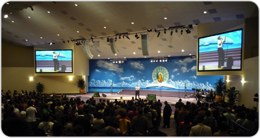 I am quick to go for a technological solution to many problems that arise. I have been tempted to purchase a tablet computer to organize my notes, track my pastoral calls, and do other tasks.
I am quick to go for a technological solution to many problems that arise. I have been tempted to purchase a tablet computer to organize my notes, track my pastoral calls, and do other tasks.
But the truth is that every hour I spend updating the church web site, every hour I spend debugging network problems, and every dollar I spend on technology takes me away from my true calling, which is to serve the people of God. I spend less time in the homes of congregational members than I did a decade ago. And I serve a bigger congregation. Part of the change is that I spend more time responding to crises and more time visiting shut-ins, but the bottom line is that I don’t invest enough time just being with the people I serve. I am too eager to get back to the office and back in front of the computer to make up the slides for the display screens in the entryway and fellowship hall, to prepare presentations for board and committee meetings, or to check out the latest continuing education podcast.
Here is a note to myself: The next time I find myself thinking that technology is the solution to whatever challenge I am facing, I need to make 3 or 4 pastoral calls before placing an order for a new gadget.
The joke that is told – at least I hope it is a joke – that a man is admitted to the emergency room of a level 1 trauma center. It takes a CT scan, a consulting radiologist and an orthopedic consultation to determine that he has only one leg and was wearing a prosthetic leg when admitted. What makes the joke work is our fear that the specialists in an emergency room would fail to recognize the obvious.
The new “paperless” medical records mean that our physicians now spend their time looking at a computer screen when they are in the examining room and rarely make eye contact with us. One study indicated that the average length of time before a physician interrupts a patient’s conversation in an examining room is 18 seconds. Medical histories used to be conveyed by storytelling. Now they are contained on forms and in computers. A patient admitted to a hospital will spend more time reporting their date of birth repeatedly than they will have actual contact with a physician. The doctors spend the bulk of their time with the computers.

Now I am no Luddite. I face my computer screen every day. When my computer develops a problem it is repaired or replace the same day that it fails. I use a smartphone and I manage the church’s computer network and web site. I have my own personal web site and do much of my research for sermons online. My home as well as my office is equipped with high speed Internet with wireless routers.
But I am alarmed that in my visits to the hospital I see more and more machines and less and less actual personal contact. I was in the room visiting a patient yesterday when the doctor came in making rounds. He asked questions, without listening to the answers, did a cursory examination with his stethoscope and was out of the room less than 5 minutes after he entered. He never shook the hand of the patient. He did not ask about pain levels. He did not ask if the patient had any questions. I am not a doctor, but the patient received more touch from me than from the doctor. And unlike the doctor, I went away from the room with information about his support system including a sister who lives in Texas and a daughter who is currently traveling.

I realize that the proverb in Luke is out of place quoted in this context, but it rings in my ears: “Physician, heal yourself.” (Luke 4:23) I am aware that the things I am criticizing about modern medicine are charges that could easily be leveled at me. My profession has become enamored with technology.


But the truth is that every hour I spend updating the church web site, every hour I spend debugging network problems, and every dollar I spend on technology takes me away from my true calling, which is to serve the people of God. I spend less time in the homes of congregational members than I did a decade ago. And I serve a bigger congregation. Part of the change is that I spend more time responding to crises and more time visiting shut-ins, but the bottom line is that I don’t invest enough time just being with the people I serve. I am too eager to get back to the office and back in front of the computer to make up the slides for the display screens in the entryway and fellowship hall, to prepare presentations for board and committee meetings, or to check out the latest continuing education podcast.
Here is a note to myself: The next time I find myself thinking that technology is the solution to whatever challenge I am facing, I need to make 3 or 4 pastoral calls before placing an order for a new gadget.
Copyright © 2013 by Ted Huffman. I wrote this. If you want to copy it, please ask for permission. There is a contact me button at the bottom of this page. If you want to share my blog a friend, please direct your friend to my web site.
Back to normal
11/04/13 02:47
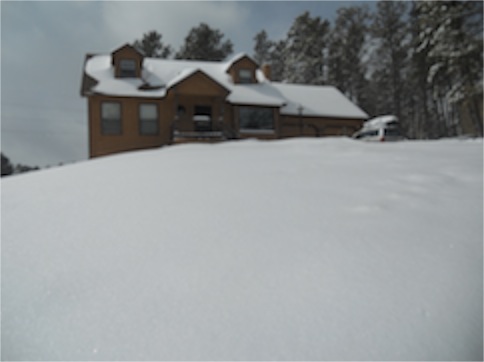
It is good for us to have our routines disrupted. We get stuck in a rut, doing the same things every day, forgetting what is most important and becoming distracted by all sorts of tasks that don’t align with our real priorities. Most of the Black Hills was shut down for a couple of days. People stayed home. The snowplows were operating only on the most critical routes. Businesses and schools closed. Much remains unchanged. We still have bills to pay. The church will have worship as usual on Sunday despite having cancelled rehearsals. We still have to get a bulletin out today. We still have plenty of work to do. We’ll be playing a bit of “catch-up.” But we also have had the time to get a bit of rest, read a bit more than our usual routine, reflect on the absolute beauty of God’s creation, and connect with our families.
The snow not only closed the schools and businesses, it set records for the amount of snow for the particular days of the storm. We’ve lived here for nearly 18 years and we don’t remember ever seeing the snow quite as deep, even in other spring blizzards. The snow came gently, without the winds that cause so much damage. There was a little wind and a little drifting, but not much else happened in terms of damage.
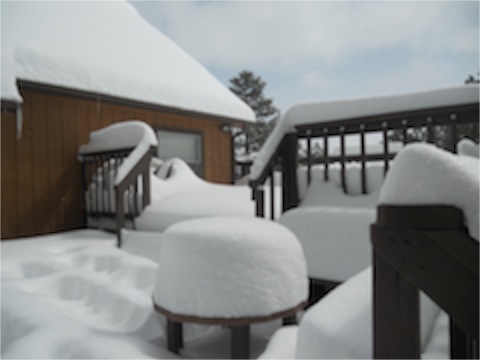
The prevalence of all wheel drive vehicles has resulted in a lot of people who don’t have tire chains and don’t know how to use them. More than a few people don’t seem to know what to do when they get stuck and simply wait for someone else to help them. I didn’t see any cars that could not have been easily moved with a little shoveling and a pair of chains.
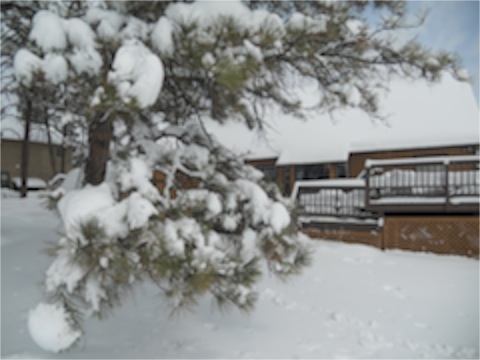
We had fun watching the deer making their way through snow what was up to their bellies. The grasses that they like best were, for the most part covered up, so they probably are on skimpy rations for a few days, but as the snow melts, the grass underneath will be green and fresh and tasty for them. We just haven’t seen the turkeys since the heavy snowfall began, but they’ll be back as the snow melts.
For the most part, our world will be back to normal today. We can get around town in our cars. Businesses are back open. Schools are in session. The church office will operate normal hours. The lot wasn’t plowed when we were at the church yesterday, but it will be plowed before we arrive this morning. There’ll be a substantial bill for moving all that heavy snow, but we haven’t had to spend too much on plowing this winter and the big piles of snow will provide an additional place for neighbor kids to play for a few days until they melt.
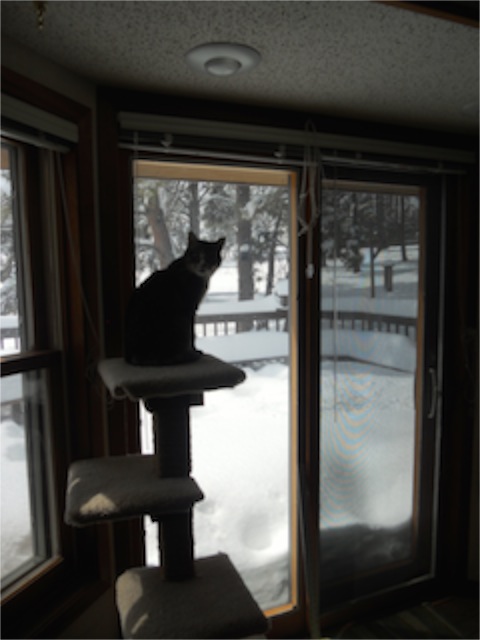
Life is good.
Copyright © 2013 by Ted Huffman. I wrote this. If you want to copy it, please ask for permission. There is a contact me button at the bottom of this page. If you want to share my blog a friend, please direct your friend to my web site.
Dreaming of Cherry Blossoms
10/04/13 04:52
The snow is letting up, but we have a lot of it on the ground. I blew snow twice yesterday and will be at it again before too long. There are a few places around our house where the drifts are 3 or more feet deep. It is impressive and beautiful. There will probably be a few more snow flakes as the storm moves off to the east and then things will start to warm up. It is forecast to stay below freezing today, with temperatures rising tomorrow and highs in the 50’s by the end of the week. The snow will melt, hopefully slowly enough to soak into the ground, which is dry. We had fun yesterday using Skype and FaceTime to show the snow to our family members who are in different places.
Our son and his family live in Olympia, Washington, where the highs have been in the 50’s. Yesterday was a beautiful day for outdoor activities and taking walks along the Chehalis trail. Today they’ve got rain in their forecast, which is typical for this time of the year.
 Our daughter and her husband are visiting his parents in the Washington, D.C. area, where the weather has been beautiful. It is a perfect time to get out and enjoy the beauty of the famous cherry trees around the tidal basin. The cherry blossoms last for only a couple of weeks and it is reported that there are more than a million visitors in the city to take part in the annual cherry blossom festival. You can rent paddleboats to view the trees and their reflections from the tidal basin, or take a stroll along the area and enjoy the fragrance and beauty of the pink and white blossoms. It is a truly lovely time of the year there. In the past couple of years, we have experienced comparatively mild weather as the D.C. area suffered blizzards and major storms, so while we are enjoying our blizzard and snow days, the folks in D.C. deserve their mild weather.
Our daughter and her husband are visiting his parents in the Washington, D.C. area, where the weather has been beautiful. It is a perfect time to get out and enjoy the beauty of the famous cherry trees around the tidal basin. The cherry blossoms last for only a couple of weeks and it is reported that there are more than a million visitors in the city to take part in the annual cherry blossom festival. You can rent paddleboats to view the trees and their reflections from the tidal basin, or take a stroll along the area and enjoy the fragrance and beauty of the pink and white blossoms. It is a truly lovely time of the year there. In the past couple of years, we have experienced comparatively mild weather as the D.C. area suffered blizzards and major storms, so while we are enjoying our blizzard and snow days, the folks in D.C. deserve their mild weather.
Getting the cherry trees for Washington D.C. was a challenging adventure from the perspectives of horticulture and diplomacy. The story of the trees, which were a gift of friendship to the People of the United States from the People of Japan, is usually said to date back to 1912 when 3,020 trees arrived in Washington D.C. The idea of planting trees dates back quite a bit earlier.
Mrs. Eliza Ruhamah Scidmore proposed planting cherry trees back in 1885 after a visit to Japan. The Potomac waterfront had recently been reclaimed and she approached the Superintendent of Public Buildings and Grounds. There was no response to her request but she continued for nearly a quarter of a century to lobby for the trees. In 1906, Dr. David Fairchild imported 75 cherry trees from the Yokohama Nursery in Japan. Those trees were planted on his property in Chevy Chase, Maryland where he assessed their hardiness and adaptability to the climate of the D.C. area. The experiment was a success and the Fairchilds joined others in advocating cherry trees for Washington D.C. and the surrounding area. Private land owners imported another 300 trees and in 1908 the Fairchilds gave one cherry tree to each school district in the District of Columbia for their Arbor Day celebrations.
Mrs. Scidmore began to raise private funds for cherry trees for Washington D.C. and in 1909 first lady Helen Taft made an official request for cherry trees from the government of Japan. Diplomatic talks followed and the City of Tokyo donated two thousand cherry trees which were shipped by boat to Seattle and overland by train to Washington DC, arriving early in 1910. The Department of Agriculture inspected the trees and found them to be infested with insects and nematodes and were deemed to be a threat to American growers. President Taft granted his consent to burn the trees and they were destroyed.
 Two years later, in March of 1912, the 3,020 cherry trees of the second shipment arrived in Washington D.C. These trees consisted of a dozen varieties. On March 27, 1912, the First Lady and the Ambassador from Japan shared in a tree planting ceremony on the north bank of the Tidal Basin and the famous Washington D.C. cherry tree festival was born. Each year since that time people have come to the city to view the trees. Over the years additional items have been placed in and around Washington D.C. to symbolize the friendship between the People of Japan and the People of the United States. A 300-year-old stone Japanese lantern was presented by the Ambassador of Japan in 1954 to commemorate the 100th anniversary of the first Treaty of Peace between the United States and Japan. The crown that is worn by the cherry blossom queen was a gift of Mikimoto Pearls, Inc. It is decorated with more than 1,500 pearls and contains more than two pounds of gold. There is a stone pagoda that was presented to the Mayor of Washington D.C. by the Mayor of the city of Yokohama in Japan.
Two years later, in March of 1912, the 3,020 cherry trees of the second shipment arrived in Washington D.C. These trees consisted of a dozen varieties. On March 27, 1912, the First Lady and the Ambassador from Japan shared in a tree planting ceremony on the north bank of the Tidal Basin and the famous Washington D.C. cherry tree festival was born. Each year since that time people have come to the city to view the trees. Over the years additional items have been placed in and around Washington D.C. to symbolize the friendship between the People of Japan and the People of the United States. A 300-year-old stone Japanese lantern was presented by the Ambassador of Japan in 1954 to commemorate the 100th anniversary of the first Treaty of Peace between the United States and Japan. The crown that is worn by the cherry blossom queen was a gift of Mikimoto Pearls, Inc. It is decorated with more than 1,500 pearls and contains more than two pounds of gold. There is a stone pagoda that was presented to the Mayor of Washington D.C. by the Mayor of the city of Yokohama in Japan.
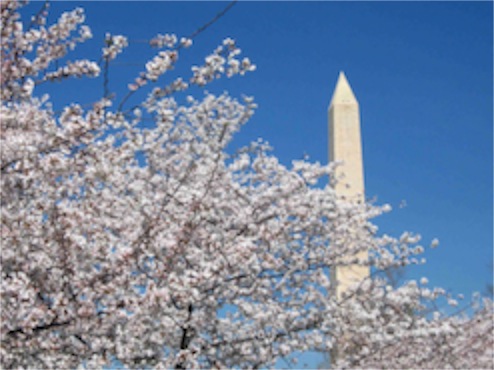 In the mid 1960’s First Lady, Lady Bird Johnson, accepted another gift of 3,000 cherry trees from the Japanese Government. Many of these newer trees were planted around the Washington Monument, extending the area where cherry trees can be viewed.
In the mid 1960’s First Lady, Lady Bird Johnson, accepted another gift of 3,000 cherry trees from the Japanese Government. Many of these newer trees were planted around the Washington Monument, extending the area where cherry trees can be viewed.
Over the years, cuttings from the trees have been sent back to Japan to preserve the trees’ genetic lineage. Several trees have been propagated from the 1,400+ year-old “Usuzumi” cherry tree in the Gifu Prefecture of Japan are growing in the Washington D.C. area. Approximately 100 new trees are planted in the area each year to insure the health of the trees and provide diversity of age.
But there are no cherry trees blooming in our yard. It is a good thing, too. This blizzard would have taken all of the blossoms off of the trees. It probably would have broken branches and caused a lot more damage as well. I doubt that we have much damage; just a lot of snow that we’ll clear and watch melt over the next week.
While the folks enjoy the cherry trees in D.C., folks in S.D. will be digging out.
Our son and his family live in Olympia, Washington, where the highs have been in the 50’s. Yesterday was a beautiful day for outdoor activities and taking walks along the Chehalis trail. Today they’ve got rain in their forecast, which is typical for this time of the year.

Getting the cherry trees for Washington D.C. was a challenging adventure from the perspectives of horticulture and diplomacy. The story of the trees, which were a gift of friendship to the People of the United States from the People of Japan, is usually said to date back to 1912 when 3,020 trees arrived in Washington D.C. The idea of planting trees dates back quite a bit earlier.
Mrs. Eliza Ruhamah Scidmore proposed planting cherry trees back in 1885 after a visit to Japan. The Potomac waterfront had recently been reclaimed and she approached the Superintendent of Public Buildings and Grounds. There was no response to her request but she continued for nearly a quarter of a century to lobby for the trees. In 1906, Dr. David Fairchild imported 75 cherry trees from the Yokohama Nursery in Japan. Those trees were planted on his property in Chevy Chase, Maryland where he assessed their hardiness and adaptability to the climate of the D.C. area. The experiment was a success and the Fairchilds joined others in advocating cherry trees for Washington D.C. and the surrounding area. Private land owners imported another 300 trees and in 1908 the Fairchilds gave one cherry tree to each school district in the District of Columbia for their Arbor Day celebrations.
Mrs. Scidmore began to raise private funds for cherry trees for Washington D.C. and in 1909 first lady Helen Taft made an official request for cherry trees from the government of Japan. Diplomatic talks followed and the City of Tokyo donated two thousand cherry trees which were shipped by boat to Seattle and overland by train to Washington DC, arriving early in 1910. The Department of Agriculture inspected the trees and found them to be infested with insects and nematodes and were deemed to be a threat to American growers. President Taft granted his consent to burn the trees and they were destroyed.


Over the years, cuttings from the trees have been sent back to Japan to preserve the trees’ genetic lineage. Several trees have been propagated from the 1,400+ year-old “Usuzumi” cherry tree in the Gifu Prefecture of Japan are growing in the Washington D.C. area. Approximately 100 new trees are planted in the area each year to insure the health of the trees and provide diversity of age.
But there are no cherry trees blooming in our yard. It is a good thing, too. This blizzard would have taken all of the blossoms off of the trees. It probably would have broken branches and caused a lot more damage as well. I doubt that we have much damage; just a lot of snow that we’ll clear and watch melt over the next week.
While the folks enjoy the cherry trees in D.C., folks in S.D. will be digging out.
Copyright © 2013 by Ted Huffman. I wrote this. If you want to copy it, please ask for permission. There is a contact me button at the bottom of this page. If you want to share my blog a friend, please direct your friend to my web site.
Snow day
09/04/13 04:31

It looks like we’re going to get a snow day today. All Rapid City Area Schools are closed today and all after-school programs are cancelled. Western Dakota Technical Institute has cancelled all classes, including evening classes. I’m pretty sure that my 8:30 a.m. book study group won’t be meeting. It was my time to bring refreshments, so I’ll get to do that next week, which is no problem. We don’t have too many meetings scheduled for the church, but we’ll probably cancel our staff meeting scheduled for this morning. According to the National Weather Service, the snow could continue through the night tonight with a total accumulation of 6 to 15 inchers. Six inches of snow doesn’t really shut things down, but the wind is blowing pretty good at the moment and the drifts are piling up. It is only about 15 degrees out there right now, so the snow is behaving like winter snow instead of a spring blizzard. But the forecast is still calling for 50-degree temperatures by the end of the week, so it won’t be staying around very long.
We’re not technically snowed in. If there were an emergency, we could probably get out in the pickup truck without putting the chains on. If I had to put the chains on the truck, we have the ability to go in a lot of snow.
But it feels good to have a snow day. We’ll make a few phone calls, adjust the church web site and settle in at home for a day. We’ve got good books to read and a warm home.
Perhaps it is the memory loss that comes with my age, or perhaps it has just been enough years and I have gathered enough experiences that I don’t remember my childhood clearly, but I don’t really remember snow days from my growing up years. I lived in a small town. Almost everyone in town could walk to the school if the roads were clogged with snowdrifts. If the snowfall began at night, the school busses wouldn’t run and the kids who lived in the country wouldn’t be in, but school would proceed without them. If the storm started in the day, country kids usually stayed in the homes of kids from town. Each country kid had a blizzard family that would host that child in the event that the roads got too bad to make the journey home. Beyond that, I think that life pretty much went on as usual.
What I do remember with great joy is that when the drifts got deep, there were some great places to play in the snow. Up at the airport, the drifts in front of the hangers would get deep enough that we could dig tunnels and make snow caves. Sometimes the snow would get deep enough that they used a tractor to clear the drifts. Most of the time, it was our job to shovel things out if an airplane needed to be taken out before the drifts melted. Airport hill had lots of good places for sledding and you could get a really long ride if you started in just the right place. You had to know where the fences were except in the very rare occasions when the snow got so deep that you could ignore them.
But the world is different these days. Our towns and cities have spread out. The parking lots at the high schools in Rapid City demonstrate the number of youth who are dependent upon cars to get them to and from school. When school district officials make a decision on whether or not to cancel school, they have to take into consideration the impact of the traffic on the city as it works to get streets cleared.
Another difference that I notice is that many people have become very confident and reliant on cars that start and run in winter conditions. I routinely see youth rushing from cars to buildings without hats and scarves and even without coats. They are so confident that the car will be warm and the house will be warm that they venture out without what I consider to be proper winter clothing. We lived only a block from the school when I was a kid, but we really bundled up when we headed out. I’m sure that part of the reason we put on all of the clothing was that we loved playing outdoors. We waited until the last possible minute when the bell rang to head into the school building. There were all sorts of games that we played in the snow. The schoolyard was full of new adventures. Snow piled up around the swing set made for soft landings when jumping out of the swings. The slide was different when there was a drift of snow at its bottom. And we’d trample out a circle in the snow to play fox and chickens. Of course building snow forts and making snow balls was also worthy of as much of our time as we could get.
These days I am a bit less eager to venture out in the snow. I still love the snow and cold weather. And I have plenty of warm clothing so that I don’t worry about the cold. But snow means a bit of work. The driveway and walks need to be cleared, and that can take quite a bit of time, depending on how much snow there is. But even that chore is a kind of a treat. Most of the work I do to earn my living involves sitting indoors - sometimes in front of the computer, sometimes meeting face-to-face with others. Having chores that demand that I spend time out of doors is kind of nice. And, when we get heavy snow fall and the conditions are rough people understand that it takes us a while to get dug out.
At any rate, the conditions are perfect for a snow day today. I just finished a book about living above the Arctic Circle in Alaska. Perhaps I’ll find a book about a warmer place for today.
Copyright © 2013 by Ted Huffman. I wrote this. If you want to copy it, please ask for permission. There is a contact me button at the bottom of this page. If you want to share my blog a friend, please direct your friend to my web site.
Death be not proud
08/04/13 05:15

Sometimes I am surprised at my own though processes. I find myself thinking about a particular topic and I wonder why. At other times I have an idea and I can trace the roots of that particular idea, but how I get from one topic to another seems like a strange route. We humans are like that. Our brains make connections that we aren’t always aware they are making. Here are some of the things that lead to this morning’s blog topic:
Towards the end of a Bible Study in which I participate on Saturday morning, we got talking about the topic of pride and humility. The main focus of the study had been points where our lives take unexpected turns. We had taken a look at the conversion of Saul. Anyway, we were noting how many times the word pride is used in a positive context in our society such as, “Take pride in your work.” It was our general conclusion that humility shouldn’t be used as an excuse for doing a task haphazardly or not investing enough of yourself in a task. Even menial tasks are worthy of care an attention and it isn’t wrong to take credit for a job well done. It was a normal sort of conversation and I moved on from that topic to another as my day progressed and I hadn’t been thinking of that conversation.
Then yesterday, I had the joy of listening to the premier performance of a new Wind quintet by Richard Toensing called “Cloud of Witnesses,” performed by the Antero Winds. The piece is unique with unexpected tonal patterns and moments of silence that last just a bit longer than the audience expects. It was pleasant to sit alone in a pew near the back of the church and close my eyes in meditation as I listened. I was thinking of a colleague who is out of town to attend the funeral of his brother, and perhaps remembering the trip that I took to attend my brother’s funeral a couple of years ago. It was not a sad or morbid feeling. It was just an opportunity to meditate on how life takes unexpected turns from time to time. The music embraced my meditation and shaped it.
This morning I woke with the phrase “Death be not proud” on my mind. It comes from the opening line of Holy Sonnet X by John Donne:
“Death be not proud, though some have called thee
Mighty and dreadful, for, thou art not so,
For, those, whom thou think’st, thou dost overthrow,
Die not, poore death, nor yet canst thou kill me.”
I don’t know if I would have become familiar with a metaphysical poem of the 17th Century, however, if the poem hadn’t given the title to a memoir by John Gunther, published in 1949 and made into a TV movie in the 1970’s. I didn’t ever watch the movie, but I know the story line of the memoir. It is a father’s true story of his teenage son’s battle with brain cancer and this untimely death at age 17. As any parents would do, the parents sought every medical treatment available. The son fought valiantly to live. But in the end a sudden cerebral hemorrhage brings the untimely death.
I think I understand Donne’s poem and why Gunther chose a line from it for the title of his memoir. It isn’t that death isn’t real. It isn’t that we can somehow escape death. It is just that when we face the stark reality of death we are surprised to discover that it is not the end. Nor is it the worst thing that can happen. In anticipation we think of death as so final. When we contemplate the lives of those we love we are so resistant to death. When we contemplate our own death we are filled with anxieties and fear.
But I have sat with the dying on many occasions. I have gone to the scenes of tragic and sudden death and viewed corpses. I have been the one to take the news to family members. I have watched as grief rolls over individuals in waves so powerful that they literally sink to their knees. I have seen more of death than many others. And I am certain that death is not the victor. There is so much more to this life than death. There is so much that is good that survives an encounter with death.
Perhaps it comes from being a preacher. I am a eulogist. After death comes, I get to say more words. I don’t allow death to have the final word. I continue to speak of the one who died and remind the world of her or his contributions and legacy. But there is more to it than language. There is a reality that even in the face of death life goes on. 1 Corinthians 15:55 asks, “O death, where is your victory?” I often quote that brief verse as I point out to survivors the signs of life that surround them in moments of intense grief: the hills, the trees, the flowers, the birdsong – and most importantly – one another drawn together in care and concern. I have seen the most powerful demonstrations of love and community in moments of grief. Death doesn’t win. Love wins.
Donne’s sonnet continues from the lines I quoted earlier, to a powerful conclusion:
“From rest and sleepe, which but thy pictures bee,
Much pleasure, then from thee, much more must flow,
And soonest our best men with thee doe goe,
Rest of their bones, and soules deliverie.
Thou art slave to Fate, Chance, kings, and desperate men,
And dost with poyson, warre, and sicknesse dwell,
And poppie, or charmes can make us sleepe as well,
And better then thy stroake; why swell'st thou then;
One short sleepe past, wee wake eternally,
And death shall be no more; death, thou shalt die.”
Yes, it is true that the paths of my thoughts are strange and often surprise me. But it is also true that I occasionally have ideas that seem to me to be important. As I listened yesterday it occurred to me that long after my life has ended, long after the lives of everyone in the room have come to their conclusion, centuries from this time, people will still listen to the haunting strains of Toensing’s quintet. The music is far too powerful to be contained in a single generation or even a single century.
The cloud of witnesses is eternal.
Copyright © 2013 by Ted Huffman. I wrote this. If you want to copy it, please ask for permission. There is a contact me button at the bottom of this page. If you want to share my blog a friend, please direct your friend to my web site.
Grief in the season of hope
07/04/13 05:30
Facts and figures can be boring, but the information from the Centers for Disease Control on mortality in the United States is a collection of facts and figures in which each fact is a real season of grief for a real family. It takes time for the CDC to compile its information, so that latest fully compiled figures are from 2010. A lot has occurred since that year. In 2010, 38,364 people died by suicide in the United States, making suicide the 10th leading cause of death for Americans. In that year someone in our country died by suicide every 13.7 minutes.
That is a staggering amount o f grief.
There was a time when we thought we were making progress. From 1990 to 2000, suicide rates steadily decreased from 12.5 per 100,000 people in the population to 10.4 per 100,000. Then, over the next ten years the rate went up again and by 2010, the rate stood at 12.1 per 100,000.
In general, older people are more likely to die by suicide than those who are younger. In 2010, the highest suicide rate was among people 45 to 64 years old. This is also the age group that has experienced the most dramatic increase over the past 10 years and the steadiest increase over the past 20 years. The second highest rate is among those 85 years and older. Adolescent suicide rates have been generally steady around 10 per 100,000 for decades.
Nearly 80% of those who die by suicide are male.
Suicide rates vary greatly by state. Six western states have adjusted suicide rates in excess of 18. South Dakota comes in just behind those six states, but the rate of death by suicide in our home state is still double that of states like New York, New Jersey, and Maryland.
But these are just statistics. The numbers are alarming. The tragedy behind those numbers is overwhelming. When a family loses a loved one to suicide, the system is rocked. Death by suicide is generally sudden and traumatic. Although family members have seen signs, may have heard threats and often have known of mental illness, the actual death comes as a shock. You don’t get over suicide death – you get through it. Having someone you love die by suicide increases all of your risk factors. Those who have experienced the death of a loved one by suicide themselves become more at risk for suicide. The death rate for survivors of suicide is nearly double that of the general population. Suicide grief is unique and uniquely painful in part because of the stigma that society attaches to mental illness in general and death by suicide in particular. It is often viewed by uninformed people as a weakness of character, a lack of faith or some other situation over which the victim has control. Suicide is rarely seen for what it is: the result of a fatal illness.
Some deaths are more public than others. A hanging on the Rosebud doesn’t make national press. A rock star overdose gets spread around the world. Somewhere between those deaths are ones that are noticed by many, but acknowledged by few.
Perhaps when we learn to share the grief of others, we will find ways to invest in the research that is needed to discover more effective treatment for depression and other mental illnesses and to prevent future tragedies.
Today I am grieving with the family of a colleague that I have never met face to face. Pastor Rick Warren is the founder of Saddleback Valley Community Church in California. He is famous for his book, “The Purpose-Driven Life,” and for delivering the invocation at President Barak Obama’s 2009 inauguration. Rick and his wife Kay have lost their youngest son to suicide. Always an eloquent writer, the e-mail he sent to the staff of the church expresses the pain and anguish the family is experiencing:
Subject: Needing your prayers
To my dear staff,
Over the past 33 years we’ve been together through every kind of crisis. Kay and I’ve been privileged to hold your hands as you faced a crisis or loss, stand with you at gravesides, and prayed for you when ill. Today, we need your prayer for us.
No words can express the anguished grief we feel right now. Our youngest son, Matthew, age 27, and a lifelong member of Saddleback, died today.
You who watched Matthew grow up knew he was an incredibly kind, gentle, and compassionate man. He had a brilliant intellect and a gift for sensing who was most in pain or most uncomfortable in a room. He’d then make a bee-line to that person to engage and encourage them.
But only those closest knew that he struggled from birth with mental illness, dark holes of depression, and even suicidal thoughts. In spite of America’s best doctors, meds, counselors, and prayers for healing, the torture of mental illness never subsided. Today, after a fun evening together with Kay and me, in a momentary wave of despair at his home, he took his life.
Kay and I often marveled at his courage to keep moving in spite of relentless pain. I’ll never forget how, many years ago, after another approach had failed to give relief, Matthew said “ Dad, I know I’m going to heaven. Why can’t I just die and end this pain?” but he kept going for another decade.
Thank you for your love and prayers. We love you back.
Pastor Rick
The depth of the tragedy invites us to sit with the family in their grief and to offer our prayers to join with those of the staff and members of Saddleback church. I know from personal experience that when you can’t find the words for your prayers it is a comfort to know that you aren’t the only one who is praying.
But we must not forget this moment of anguish, as painful as it is. We must use this time as an opportunity to find ways to increase research, provide more effective treatment and prevent future deaths by suicide. In this Easter season, we are reminded that love is stronger than death. May our love go out to the grieving family and be turned into action that makes a change in this world.
That is a staggering amount o f grief.
There was a time when we thought we were making progress. From 1990 to 2000, suicide rates steadily decreased from 12.5 per 100,000 people in the population to 10.4 per 100,000. Then, over the next ten years the rate went up again and by 2010, the rate stood at 12.1 per 100,000.
In general, older people are more likely to die by suicide than those who are younger. In 2010, the highest suicide rate was among people 45 to 64 years old. This is also the age group that has experienced the most dramatic increase over the past 10 years and the steadiest increase over the past 20 years. The second highest rate is among those 85 years and older. Adolescent suicide rates have been generally steady around 10 per 100,000 for decades.
Nearly 80% of those who die by suicide are male.
Suicide rates vary greatly by state. Six western states have adjusted suicide rates in excess of 18. South Dakota comes in just behind those six states, but the rate of death by suicide in our home state is still double that of states like New York, New Jersey, and Maryland.
But these are just statistics. The numbers are alarming. The tragedy behind those numbers is overwhelming. When a family loses a loved one to suicide, the system is rocked. Death by suicide is generally sudden and traumatic. Although family members have seen signs, may have heard threats and often have known of mental illness, the actual death comes as a shock. You don’t get over suicide death – you get through it. Having someone you love die by suicide increases all of your risk factors. Those who have experienced the death of a loved one by suicide themselves become more at risk for suicide. The death rate for survivors of suicide is nearly double that of the general population. Suicide grief is unique and uniquely painful in part because of the stigma that society attaches to mental illness in general and death by suicide in particular. It is often viewed by uninformed people as a weakness of character, a lack of faith or some other situation over which the victim has control. Suicide is rarely seen for what it is: the result of a fatal illness.
Some deaths are more public than others. A hanging on the Rosebud doesn’t make national press. A rock star overdose gets spread around the world. Somewhere between those deaths are ones that are noticed by many, but acknowledged by few.
Perhaps when we learn to share the grief of others, we will find ways to invest in the research that is needed to discover more effective treatment for depression and other mental illnesses and to prevent future tragedies.
Today I am grieving with the family of a colleague that I have never met face to face. Pastor Rick Warren is the founder of Saddleback Valley Community Church in California. He is famous for his book, “The Purpose-Driven Life,” and for delivering the invocation at President Barak Obama’s 2009 inauguration. Rick and his wife Kay have lost their youngest son to suicide. Always an eloquent writer, the e-mail he sent to the staff of the church expresses the pain and anguish the family is experiencing:
Subject: Needing your prayers
To my dear staff,
Over the past 33 years we’ve been together through every kind of crisis. Kay and I’ve been privileged to hold your hands as you faced a crisis or loss, stand with you at gravesides, and prayed for you when ill. Today, we need your prayer for us.
No words can express the anguished grief we feel right now. Our youngest son, Matthew, age 27, and a lifelong member of Saddleback, died today.
You who watched Matthew grow up knew he was an incredibly kind, gentle, and compassionate man. He had a brilliant intellect and a gift for sensing who was most in pain or most uncomfortable in a room. He’d then make a bee-line to that person to engage and encourage them.
But only those closest knew that he struggled from birth with mental illness, dark holes of depression, and even suicidal thoughts. In spite of America’s best doctors, meds, counselors, and prayers for healing, the torture of mental illness never subsided. Today, after a fun evening together with Kay and me, in a momentary wave of despair at his home, he took his life.
Kay and I often marveled at his courage to keep moving in spite of relentless pain. I’ll never forget how, many years ago, after another approach had failed to give relief, Matthew said “ Dad, I know I’m going to heaven. Why can’t I just die and end this pain?” but he kept going for another decade.
Thank you for your love and prayers. We love you back.
Pastor Rick
The depth of the tragedy invites us to sit with the family in their grief and to offer our prayers to join with those of the staff and members of Saddleback church. I know from personal experience that when you can’t find the words for your prayers it is a comfort to know that you aren’t the only one who is praying.
But we must not forget this moment of anguish, as painful as it is. We must use this time as an opportunity to find ways to increase research, provide more effective treatment and prevent future deaths by suicide. In this Easter season, we are reminded that love is stronger than death. May our love go out to the grieving family and be turned into action that makes a change in this world.
Copyright © 2013 by Ted Huffman. I wrote this. If you want to copy it, please ask for permission. There is a contact me button at the bottom of this page. If you want to share my blog a friend, please direct your friend to my web site.
Different kinds of gretness
06/04/13 04:27
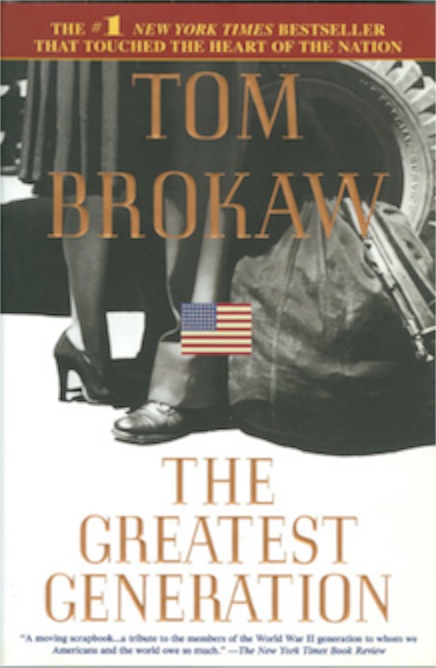
It is also true that Brokaw’s book overstates things and promotes a kind of hero worship that is not particularly helpful as our nation moves into the future. First of all, his claim that one generation is somehow greater than another might have some basis, but to say that the G.I. generation contributed more to American history than the generation that produced the Declaration of Independence, the American Revolution and the U.S. Constitution is subjective at best. The truth is that each generation is shaped by the circumstances of their particular place in history and that some circumstances invite people to rise above the common and accomplish extraordinary things. Fortunately, there have been many generations of greatness in our history.
Perhaps Brokaw’s title will stick and the name “greatest generation” will be the name by which this age cohort will be known. Prior to his book, the most common name was “G.I. Generation.” That name has its origins in a war term. G.I. stands for “General Infantry” and refers to the foot soldiers that contributed greatly to the war effort. Of course there were plenty of members of that generation who never served in the infantry and the war was won in part by innovations in technology and skilled contributors like pilots, engineers and strategists. The letters “G.I.” originally referred to galvanized iron, such as metal trash cans. The Army inventories and supply records were filled with many items made of galvanized iron. During World War I, U.S. soldiers referred to incoming German artillery shells as “G.I. cans.” During World War II the letters began to refer to anything that had to do with the army. Some people came to believe that G.I. stood for “government issue.” It became a nickname for American soldiers.
G.I. generation isn’t a bad moniker for the generation. They did participate in military service in numbers that was unprecedented and hasn’t since been seen. They also supported and developed government at the state and national level that provided services at a level not experienced by previous generations and probably not sustainable in future generations. I once heard a comedian make a joke about one of the institutions of the G.I. generation: “Do you know what the letters AARP stand for? It is the American Association of persons who are out to force their children to pay for services that they would have never dreamed of providing for their parents and don’t you ever forget it.” The joke probably doesn’t make many of the people who founded AARP laugh. But it is true that the G.I. generation not only contributed deeply to American Society, they also benefitted greatly from it. The generation that began with the deprivations of the Great Depression ended their lives with a higher percentage of the total wealth of the nation controlled by a single generation than ever before. They are ending their lives with the highest level of government support through social security, Medicare and other government programs. Both the budget proposed by House Republicans and the Democratic Administration are proposing cuts to Medicare. It is becoming evident that sustaining that level of government support for retired persons is not feasible. Subsequent generations will not retire as early nor will they have the same level of tax-supported services as this particular generation.
Another quality of the G.I. generation that is seldom noted, but evident in our society is found in the fact that great leaders often don’t share leadership easily. My father was a member of the G.I. generation. By the time he was in his late forties and early fifties he was the senior member of many public boards on which he served. He had chaired church boards, civic boards, non-profit corporation boards and served on the board of trustees of a college for many years. As I approached a similar age, those boards had far fewer positions for people my age as persons the age of my parents continued to serve and dominate the leadership positions. They were great leaders, but they didn’t pass on leadership to others easily. I can quickly name three community boards on which I serve that are chaired by persons in their mid to late eighties who show no signs of stepping down or sharing power. Other boards are dominated by the next generation, who had to wait until the G.I. generation members died in office before they could assume leadership and so see the leadership pattern as belonging to the oldest members of the group. In some of these boards the age of the leadership is shaping the organization in negative ways.
The few members of the World War II generation who remain and those a decade or so younger will bemoan the decrease in involvement in service clubs as a sign that the generations that follow them aren’t as community minded as theirs. Those of us who are a bit younger think it is obvious that these community groups are dying because of the inability of leaders to pass leadership to a new generation. In a service club if you do agree to serve in a leadership position, you’d better do it the way your elders tell you or you’ll soon find another person in that position. Changing time-honed formulas is forbidden and there is little appeal in maintaining the institutions of a previous generation.
I’m comfortable to allow history to sift and sort and identify the great contributions of a great generation. There are a few things that I have learned from my elders. One of those things is that it is time for me to learn to step aside and allow younger leaders to develop. My role can be mentoring and consulting instead of occupying the leadership positions. By the time I reach my seventies, I hope to be serving my community as a worker, contributor and a volunteer without the need to be in charge of institutions or boards. I can already see some wonderful new leaders emerging.
I truly believe that Tom Brokaw got it wrong. Despite the real and significant contributions of the World War II generation, the greatest generation in the story of this nation is yet to come.
Copyright © 2013 by Ted Huffman. I wrote this. If you want to copy it, please ask for permission. There is a contact me button at the bottom of this page. If you want to share my blog a friend, please direct your friend to my web site.
Times are changing
05/04/13 05:14
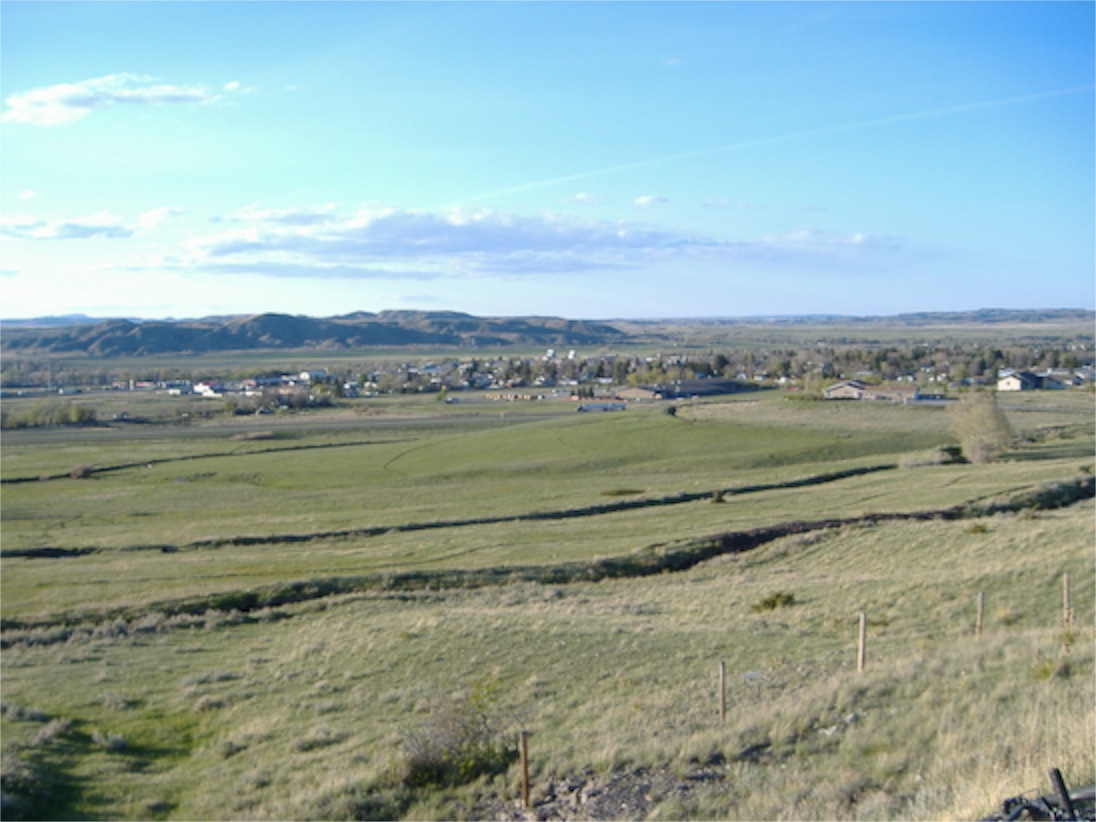 It has probably been true of every generation, but I have come to the realization that the world in which I grew up no longer exists. When I was much younger and left Montana for graduate school in Chicago, I lived with a fantasy of going back home. We returned frequently for breaks and vacations, but we never again lived in Montana. Our lives called us in new directions and we changed. Living in Chicago taught me a set of urban survival skills that I could not have cultivated in Montana. My small town had no public transportation. There were and still are no commuter trains in my home state. Driving on crowded urban freeways is different than driving on open country roads. I learned about locks and security. The adjustment to living in the city was hard for me. I kept locking the keys in the car. I felt restrained by the small amounts of space in our apartment and the number of locks that were required between our living space and the street. I had to cultivate a fear of dark places and learn to avoid cutting through alleys and across open areas.
It has probably been true of every generation, but I have come to the realization that the world in which I grew up no longer exists. When I was much younger and left Montana for graduate school in Chicago, I lived with a fantasy of going back home. We returned frequently for breaks and vacations, but we never again lived in Montana. Our lives called us in new directions and we changed. Living in Chicago taught me a set of urban survival skills that I could not have cultivated in Montana. My small town had no public transportation. There were and still are no commuter trains in my home state. Driving on crowded urban freeways is different than driving on open country roads. I learned about locks and security. The adjustment to living in the city was hard for me. I kept locking the keys in the car. I felt restrained by the small amounts of space in our apartment and the number of locks that were required between our living space and the street. I had to cultivate a fear of dark places and learn to avoid cutting through alleys and across open areas. I was changing in other ways as well. I was reading books – lots of books. I was attending classes and developing friendships with people from around the world. I heard lectures that pushed my thinking in new directions.
From Chicago, we moved to North Dakota and from there to Idaho and finally to South Dakota. All the while we were having new experiences, meeting new people, learning and growing.
I was aware of how much I was changing, but I sometimes didn’t notice how much the places I left had changed. This world isn’t static.
These days, when I go back to visit one of the places where I used to live, I notice that there are a lot of new buildings. This is true even in small and rural locations. The population in my hometown is about the same as it was when I was growing up, but the people occupy more and larger houses. There are a few homes in that town that belong to people who have multiple homes and use their home in that area only part of the year. But there are more changes than just the number and location of buildings.
Within five years of the time I moved away from home all of the sheep ranchers in the area had ceased trailing their sheep to the high pastures in the summer. It was a combination of factors. The cost of grazing leases on federal land was going up. There were pressures on that land for other uses. The technologies for hauling sheep and other items changed. Ranchers had bigger trucks. Semis started to appear in ranch yards. The margins of profit in ranching grew slimmer, forcing some out of the business. Those who remained were forced to get bigger in order to keep their operations viable. Bigger farms and ranches meant less people living on the land. Initially this meant more people moved to town. Gradually it meant that the average age of the folks in town went up. There were fewer children for the schools and more retired folks.
Everybody travels more these days. A trip to a nearby small city is routine. The nearest Wal-Mart is 60 miles away, but you can see the effects of the big box stores on Main Street in my hometown. The impacts of Internet shopping also have forced a change in businesses. The truth is that you probably can purchase a lot more things locally today in that town than was the case when I was growing up. But we have learned to want even more items. We see more objects as disposable and routinely consume items that we once thought were luxuries.
It is tempting to become nostalgic about the past. The danger with that kind of nostalgia is that our memories can become inaccurate. The past we long for is something that never existed. I can wax poetic about old time sheep men and cowboys but it wasn’t an easy life. Alcoholism and domestic violence were regular occurrences in those days even if we didn’t talk about them. The life of a ranch wife in the days before everyone had a car was a hard lot. There was isolation and loneliness. People suffered from improperly treated illnesses and injuries. Broken bones became crippling disabilities. Wax poetic about the outhouse, but it is a darn cold inconvenience at -20 degrees. And the life of the preacher was quite different than it is these days. I only lived in my hometown for 17 years, but I can name five preachers that served our little church in those years. A minister that lasted 4 years was an anomaly. There were always more ministers and the church just moved on. I wasn’t aware of conflict or tension, but I know today that it was there. I know that I no longer know how to live on the wages offered by small membership congregations.
Still, I feel lucky to have grown up in the time and place that I did. There was enough wild country left to get away from the sounds and lights of the city without much effort. We were free to wear cutoffs all summer and play in a wild river. We caught grasshoppers and used them for bait for fish that our mom cooked the same day they were caught. We ate meat from animals raised by ranchers we knew and supplemented that by hunting deer and antelope, with an occasional elk. We poured over the Sears and Montgomery Ward catalogues, but bought most of our Christmas presents from the dime store in town. If you couldn’t get it at the hardware store or one of the implement dealers, there was probably someone who could make what it was you needed. If not, you could learn to live without it.
The world is changing. We can’t go back. But there are treasures in our past that have lasting value. We do well to remember as accurately as possible.
Copyright © 2013 by Ted Huffman. I wrote this. If you want to copy it, please ask for permission. There is a contact me button at the bottom of this page. If you want to share my blog a friend, please direct your friend to my web site.
Loneliness and isolation
04/04/13 02:33

For decades, social scientists have had evidence that loneliness and isolation can shorten a person’s life. It is common in contemporary research to separate the two categories. Social isolation is a more objective category. You can compare the number of times a person has contact with others in the course of their daily and weekly routines. Loneliness is more subjective. It really boils down to how someone feels. There are those who have significant social contact in their lives who report that they feel lonely and others who live relatively isolated lifestyles who report that they do not feel lonely.
In a new study, recently published in the Proceedings of the National Academy of Sciences of the United States of America (PNAS), researchers from University College in London followed thousands of people over the age of 52 for seven to eight years to assess the effect of loneliness and isolation. There were some significant surprises in their findings. The researchers used a standardized questionnaire that assessed both the sense of loneliness and how much contact individuals had with friends and family. These questionnaires were administered over a period of several months in 2004 and 2005. Then those who had completed the questionnaires were followed for the next seven or eight years. Their health statistics and mortality rates were compiled and compared. The reason for selecting people over the age of 52 was that the study was intended to focus on elders, but the long-term span of the study meant that researchers chose to follow people who were not yet age 60 as they approached that age as well as those of different ages. Because the study covered nearly a decade and is ongoing, researchers knew that age itself has a definite effect on mortality after individuals reach their 80’s and 90’s.
The surprise, for me, in their findings was that people who report greater levels of loneliness are not necessarily more likely to die. I expected the opposite. I thought that one’s attitude and feelings toward time alone would have a great impact on their longevity. However, the study discovered that those who report loneliness were also more likely to have other risk factors, like being poor and having existing health problems. Once those factors were taken into account, the extra risk associated with loneliness pretty much disappeared. The study does not indicate that loneliness causes an increased rate of mortality. It does, however, point to the fact that poverty and illness may contribute to an increased sense of loneliness.
Social isolation, however, is linked to an increased rate of mortality. I didn’t expect this result simply because I know a number of individuals who choose their isolation and who are completely alone with it. One woman we knew was widowed relatively early and continued to live alone on the family farm for the remainder of her long and happy life. She seemed quite content to stay home alone and filled her days with gardening, bird watching, canning and other activities. Researchers found many people who did not see their isolation as a problem, but rather a conscious choice over which they had control. In general people who were isolated felt that they had more control over their situation than those who reported loneliness. Those who were lonely often did not see ways to change their situation.
It is possible that isolate persons have higher mortality because having other people around has practical benefits as one ages. For example, another person might encourage or enable one to receive more aggressive health care for chronic conditions. In the event of an emergency medical situation, another person can summon help when a person who lost consciousness, for example, would not be able to get help for him or her self.
Even though the study was large and well done, it has not convinced all of the scientists who study this area. Bert Uchino, a University of Utah psychology professor says that the study’s conclusions are influenced by the simple fact that people’s definition of loneliness is changing in the Internet age. “People . . . may think that they’re connected to other people because they’re on Facebook,” he says. They may not report feeling lonely. But that kind of connection may not have the health benefits of direct contact with other people. University of Chicago psychologist John Cacioppo believes that the study may also indicate differences in attitude between British and people from other parts of the world. The study focused on British citizens, who may be less likely to admit feeling lonely than are people in the United States.
All of this is of some interest to me because I live a life that is neither lonely nor isolated. My daily routine brings me into close and often intimate contact with a lot of different people. I am a partner in a long and meaningful marriage. I use the Internet to remain in contact with people who I have met face to face, deeply love and get together with as often as possible. In fact, because of the nature of my work, I often seek times and places to be alone. I am an early riser in part because this part of my day is spent alone, while others are sleeping. I like to go into my office when others do not expect me to be there because the telephone is silent and I can focus on other work. I imagine that retirement might involve more travel to places with fewer people, longer walks and paddles in isolated locations, and increased opportunities to be alone with my thoughts and prayers.
I have no fear of being lonely. There are plenty of people in my life to whom I can turn if I have need. And my prayer life and my relationship with God is such that I never feel truly alone. That is a factor that I did not see addressed in the study. I am convinced that loneliness is not just the product of physical isolation, nor is it due to sociological factors such as poverty and illness alone. Loneliness is a spiritual problem. Successful treatment of loneliness has, in my opinion, a distinctly religious character. Those who are able to have a positive relationship with God are less likely to experience loneliness.
It is a topic that could use more study.
Copyright © 2013 by Ted Huffman. I wrote this. If you want to copy it, please ask for permission. There is a contact me button at the bottom of this page. If you want to share my blog a friend, please direct your friend to my web site.
Spring Fever
03/04/13 04:04
I know that it is easy to get spring fever early in the hills. We can be surprised by spring blizzards well into May, but it is hard to deny that there is a change in the hills. Following the intensity of last week, I attempted to take two days in a row off this week. I didn’t really pull it off. I spent the afternoon in a meeting yesterday, but I did take more time away from the office than usual and I used part of that time to look around the neighborhood and contemplate the coming of spring.
The yearling deer have something inside of them that responds to the nearly 70-degree days. I suppose they don’t remember the way we do, but it is hard not to do a little anthropomorphizing as I sit on my deck and watch them scamper around the yard. They run in circles, chase each other, raise their tails when there is not threat near and expend energy in a manner that seems to be playful. They’ll need those muscles to be toned and ready as they face the summer. They have to gather their own food and by mid summer they will be ranging farther from their mothers and will have to take more responsibility for their own safety and survival. Strong legs and the ability to run are the primary method of avoiding predators. Living next to a very busy road, we wish they could develop some traffic skills, but that doesn’t seem likely. It appears easier to train motorists to avoid the deer than the other way around.
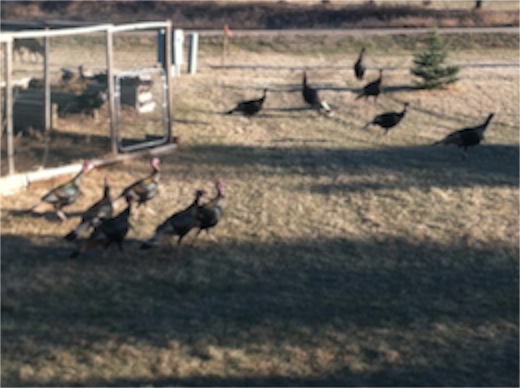 The turkeys are all bunched up. A few days ago I saw what I think is the largest amount of turkeys in the yard at the same time. I counted over 50, but it was difficult to be sure which I had already counted. They don’t exactly hold still for the count. It is interesting to watch the interplay between the turkeys and the deer. Sometimes the turkeys startle the deer and cause them to run a short distance, at other times, the deer wade into a circle of turkeys and sent them squawking and running. If the deer show little road sense, the turkeys have less.
The turkeys are all bunched up. A few days ago I saw what I think is the largest amount of turkeys in the yard at the same time. I counted over 50, but it was difficult to be sure which I had already counted. They don’t exactly hold still for the count. It is interesting to watch the interplay between the turkeys and the deer. Sometimes the turkeys startle the deer and cause them to run a short distance, at other times, the deer wade into a circle of turkeys and sent them squawking and running. If the deer show little road sense, the turkeys have less.
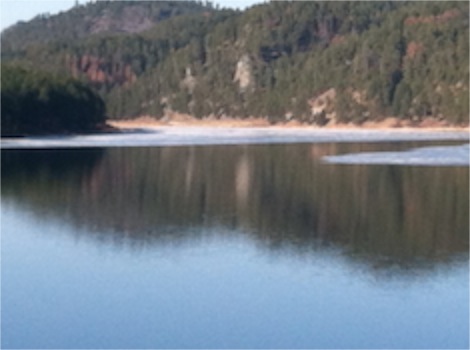 The ice is coming out of the lake. Only the shallows in the coves are ice-filled and that ice is thin. It would have been a good day yesterday to play at the edges of the ice with a kayak, but I decided to take a walk around the edge of the lake instead. The kayak would have been plenty warm and I need to get paddling for the exercise, but I didn’t know how much ice to expect. I simply haven’t been going to the lake on a regular basis. The geese were making a lot of noise and it won’t be long before there are a lot more ducks at the lake. They’re hardy and as long as they have open water they can find food and places to nest. Even if we get a few days of spring blizzard, it is unlikely that we’ll get enough cold weather to freeze up the lake again this year. Warmth begets warmth and the plants start growing and the critters become more active and the sun bears down and heats up the water. The lake is a giant heat sink. It takes several days to change the water temperature just a few degrees.
The ice is coming out of the lake. Only the shallows in the coves are ice-filled and that ice is thin. It would have been a good day yesterday to play at the edges of the ice with a kayak, but I decided to take a walk around the edge of the lake instead. The kayak would have been plenty warm and I need to get paddling for the exercise, but I didn’t know how much ice to expect. I simply haven’t been going to the lake on a regular basis. The geese were making a lot of noise and it won’t be long before there are a lot more ducks at the lake. They’re hardy and as long as they have open water they can find food and places to nest. Even if we get a few days of spring blizzard, it is unlikely that we’ll get enough cold weather to freeze up the lake again this year. Warmth begets warmth and the plants start growing and the critters become more active and the sun bears down and heats up the water. The lake is a giant heat sink. It takes several days to change the water temperature just a few degrees.
The forecasters say we have a chance of rain later this week, but the percentages are low on the forecast charts. The land is dry.
I hiked through the fire scar from last year’s Dakota Point Fire. It is amazing how quickly things are coming back. Most of the area where the fire burned had been thinned and the fire cleared out the undergrowth and while it did kill a number of trees, a lot of trees survived. The survivor trees will be getting plenty of sunlight and if they can get adequate moisture the forest will begin to look pretty healthy. The problem is the moisture. What rain and snow we do get this spring is soaking into the ground quickly. With very few needles or other duff on the ground, the ash and dirt are mixing off and the soil seemed rich and a bit loamy as I walked, but I know how quickly that can dry out with a few hot and windy days. Still, I suspect that there is plenty of seed in the ground and I expect to see a lot of green in a few weeks.
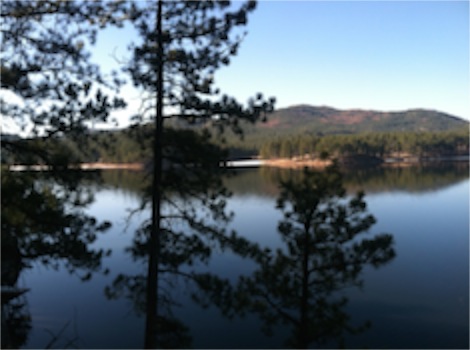 It is good for me to get out into the hills. There are too many weeks when I spend too much time indoors. It is easy to get disconnected from the life that surrounds us. A walk in the woods, even a short stroll, reminds me of the life that surrounds us and the continuing processes of growth and rebirth that are built into this universe. When I invest so much time in intense relationships with other people, I need to balance my life with times alone. Unlike the turkeys, I sometimes just have an urge to be somewhere by myself, breathing the fresh air, listening to the sounds of nature, seeing outdoor sights and smelling outdoor smells.
It is good for me to get out into the hills. There are too many weeks when I spend too much time indoors. It is easy to get disconnected from the life that surrounds us. A walk in the woods, even a short stroll, reminds me of the life that surrounds us and the continuing processes of growth and rebirth that are built into this universe. When I invest so much time in intense relationships with other people, I need to balance my life with times alone. Unlike the turkeys, I sometimes just have an urge to be somewhere by myself, breathing the fresh air, listening to the sounds of nature, seeing outdoor sights and smelling outdoor smells.
Years ago I discovered that certain writers can take me on outdoor adventures when, for whatever reason, I am not able to go outside. It isn’t really practical to go for a night hike every time I wake in the middle of the night, but I can reach for “Canoeing in the Wilderness” by Henry Thoreau or “Two in the Far North” by Margaret Murie or a novel by Ivan Doig or Seth Kantner and get back in touch with some of the wild and lest peopled places in the world. Reading about the outdoors life is no substitute for hiking on canoeing, but a good read can sometimes inspire me to get up and get out.
Each spring I vow to spend more time outside and to come closer to a balance between time alone and time with others, and each summer I am a little better at getting out than I was the previous winter, but a perfect balance eludes me each year.
The truth is that I think spring fever is good for me.
The yearling deer have something inside of them that responds to the nearly 70-degree days. I suppose they don’t remember the way we do, but it is hard not to do a little anthropomorphizing as I sit on my deck and watch them scamper around the yard. They run in circles, chase each other, raise their tails when there is not threat near and expend energy in a manner that seems to be playful. They’ll need those muscles to be toned and ready as they face the summer. They have to gather their own food and by mid summer they will be ranging farther from their mothers and will have to take more responsibility for their own safety and survival. Strong legs and the ability to run are the primary method of avoiding predators. Living next to a very busy road, we wish they could develop some traffic skills, but that doesn’t seem likely. It appears easier to train motorists to avoid the deer than the other way around.


The forecasters say we have a chance of rain later this week, but the percentages are low on the forecast charts. The land is dry.
I hiked through the fire scar from last year’s Dakota Point Fire. It is amazing how quickly things are coming back. Most of the area where the fire burned had been thinned and the fire cleared out the undergrowth and while it did kill a number of trees, a lot of trees survived. The survivor trees will be getting plenty of sunlight and if they can get adequate moisture the forest will begin to look pretty healthy. The problem is the moisture. What rain and snow we do get this spring is soaking into the ground quickly. With very few needles or other duff on the ground, the ash and dirt are mixing off and the soil seemed rich and a bit loamy as I walked, but I know how quickly that can dry out with a few hot and windy days. Still, I suspect that there is plenty of seed in the ground and I expect to see a lot of green in a few weeks.

Years ago I discovered that certain writers can take me on outdoor adventures when, for whatever reason, I am not able to go outside. It isn’t really practical to go for a night hike every time I wake in the middle of the night, but I can reach for “Canoeing in the Wilderness” by Henry Thoreau or “Two in the Far North” by Margaret Murie or a novel by Ivan Doig or Seth Kantner and get back in touch with some of the wild and lest peopled places in the world. Reading about the outdoors life is no substitute for hiking on canoeing, but a good read can sometimes inspire me to get up and get out.
Each spring I vow to spend more time outside and to come closer to a balance between time alone and time with others, and each summer I am a little better at getting out than I was the previous winter, but a perfect balance eludes me each year.
The truth is that I think spring fever is good for me.
Copyright © 2013 by Ted Huffman. I wrote this. If you want to copy it, please ask for permission. There is a contact me button at the bottom of this page. If you want to share my blog a friend, please direct your friend to my web site.
Christ of the everyday
02/04/13 03:05
One of the expressions of individualism in contemporary American culture is the stress on each person being unique. We tell our children that they are special and different from other children. We look for signs that demonstrate exceptional intelligence or physical ability. We want to recognize the things that make our children different from their peers.
Developmental psychologists point out that the process of individuation is a natural stage of maturation. During adolescence, young people look for ways to understand themselves as unique and different from their parents and from other members of their families of origin.
One of my favorite educational theorists, Howard Gardner, developed the theory of multiple intelligences, part of which is an embracing of the differences between children and a search for exceptional qualities. One child might demonstrate excellent verbal-linguistic skills, while another might show musical genius. Another child might be mathematically brilliant while yet another child shows great skill at interpersonal relationships. The theory has inspired a great deal of my curricula writing and other educational work.
We all want to think that we are exceptional. We are special. We are different. Our highly competitive, individualistic culture encourages that kind of thinking. In some tribal societies such individuality is not encouraged. Being the same as others and thinking about the common good is emphasized. Individual success is downplayed in favor of things that produce success for the entire clan or group.
I like to think that I live my life in a meaningful and purposeful manner and that I have honed my natural skills and abilities so that I have made the best of the unique gifts I have received. But what if there really isn’t anything that unique about me? What if, at my core, I am not all that special, but just like everyone else? It is a thought worth pursuing.
For several years now I have listened to the show “On Being” with Krista Tippett. The show, formerly called, “Speaking of Faith,” features in-depth interviews with people whose lives and work make a difference in the world. Recent interviews have included Congressman John Lewis, acoustic biologist Kay Payne, Poet and actor Kevin Kling and Father Greg Boyle. Tippett is a skilled interviewer who brings out the best in those with whom she speaks as she asks questions that explore the ecology of meaning that leads people to make deep contributions to the world.
One of my fantasies is that someday Krista Tippett would decide to interview me. I can imagine having a deep and meaningful conversation about how worship is crafted, about the survival of a mainline congregation in the midst of institutional decline, about the development of grassroots mission and engaging people in hands on service, and a hundred other topics. But that fantasy is accompanied by a negative image. What if Krista Tippett were to take time to interview me and I had nothing deep or especially meaningful to say? What if she was to ask probing questions and I would not have any truly meaningful insights? I can imagine that I might be proven to be shallow and trite and my words devoid of lasting meaning.
There is a piece of this kind of thinking that lies at the core of incarnational theology. We want to think of the incarnation as the creation of a perfect human being. Jesus is God in human form, but when God becomes human it isn’t like we are human. God becomes human without sin and without mistakes and without the normal trappings of human existence. The stories surrounding Jesus tend to emphasize the ways in which he was exceptional. He resisted temptation for 40 days in the wilderness. He asked stunning questions of the elders in the temple at the age of 12. He listened to people that others ignored. He lived an exemplary life in every way. As soon as we think of Jesus, we think not of his humanity, but rather of his divinity.
On Sunday we will celebrate communion once again. We celebrated a lot during Holy Week and experienced the sacrament through a variety of different liturgies. I am aware of how much we want to emphasize the holy in that meal. We like to get out the special chalices and plates, to bring out the special dishes and make special preparations. We say special prayers and eat in a careful and thoughtful manner. We understand the holiness of the meal.
 But we struggle with Jesus’ humanity. We don’t want to think of Jesus as common or ordinary. And the problem with that kind of thinking is that we fail to see Jesus in the everyday. Jesus didn’t say, “Do this, on special Sundays with special dishes and special prayers and special ceremony, in remembrance of me.” He said, “Do this as often as you eat and drink, in remembrance of me. We remember Jesus in the high and holy ceremonies. We tend to forget Jesus in the quick meal of peanut butter sandwiches and reheated coffee. But every meal, shared in love is sacred. Every conversation that involves a genuine encounter with other human beings is holy. Whenever a meal is prepared with love, Christ is present in our midst.
But we struggle with Jesus’ humanity. We don’t want to think of Jesus as common or ordinary. And the problem with that kind of thinking is that we fail to see Jesus in the everyday. Jesus didn’t say, “Do this, on special Sundays with special dishes and special prayers and special ceremony, in remembrance of me.” He said, “Do this as often as you eat and drink, in remembrance of me. We remember Jesus in the high and holy ceremonies. We tend to forget Jesus in the quick meal of peanut butter sandwiches and reheated coffee. But every meal, shared in love is sacred. Every conversation that involves a genuine encounter with other human beings is holy. Whenever a meal is prepared with love, Christ is present in our midst.
The truth is that when we open our eyes, we discover that God is constantly at work in this world. We don’t need to somehow push for exceptional talents or behaviors. We don’t need to take spectacular risks or go places no one else has gone before. We are already exactly what God had in mind when God made us. God loves us the way that we are. We don’t have to do or be anything different than who we are. The incarnation is precisely the coming of God to humans in human terms, not the rising of humans to some ethereal, divine level. We don’t need a tower of Babel. God is right here, right down to earth, walking alongside us in the nitty-gritty of human living.
Perhaps communion with peanut butter sandwiches and reheated coffee served on the everyday dishes isn’t such a bad idea after all.
Developmental psychologists point out that the process of individuation is a natural stage of maturation. During adolescence, young people look for ways to understand themselves as unique and different from their parents and from other members of their families of origin.
One of my favorite educational theorists, Howard Gardner, developed the theory of multiple intelligences, part of which is an embracing of the differences between children and a search for exceptional qualities. One child might demonstrate excellent verbal-linguistic skills, while another might show musical genius. Another child might be mathematically brilliant while yet another child shows great skill at interpersonal relationships. The theory has inspired a great deal of my curricula writing and other educational work.
We all want to think that we are exceptional. We are special. We are different. Our highly competitive, individualistic culture encourages that kind of thinking. In some tribal societies such individuality is not encouraged. Being the same as others and thinking about the common good is emphasized. Individual success is downplayed in favor of things that produce success for the entire clan or group.
I like to think that I live my life in a meaningful and purposeful manner and that I have honed my natural skills and abilities so that I have made the best of the unique gifts I have received. But what if there really isn’t anything that unique about me? What if, at my core, I am not all that special, but just like everyone else? It is a thought worth pursuing.
For several years now I have listened to the show “On Being” with Krista Tippett. The show, formerly called, “Speaking of Faith,” features in-depth interviews with people whose lives and work make a difference in the world. Recent interviews have included Congressman John Lewis, acoustic biologist Kay Payne, Poet and actor Kevin Kling and Father Greg Boyle. Tippett is a skilled interviewer who brings out the best in those with whom she speaks as she asks questions that explore the ecology of meaning that leads people to make deep contributions to the world.
One of my fantasies is that someday Krista Tippett would decide to interview me. I can imagine having a deep and meaningful conversation about how worship is crafted, about the survival of a mainline congregation in the midst of institutional decline, about the development of grassroots mission and engaging people in hands on service, and a hundred other topics. But that fantasy is accompanied by a negative image. What if Krista Tippett were to take time to interview me and I had nothing deep or especially meaningful to say? What if she was to ask probing questions and I would not have any truly meaningful insights? I can imagine that I might be proven to be shallow and trite and my words devoid of lasting meaning.
There is a piece of this kind of thinking that lies at the core of incarnational theology. We want to think of the incarnation as the creation of a perfect human being. Jesus is God in human form, but when God becomes human it isn’t like we are human. God becomes human without sin and without mistakes and without the normal trappings of human existence. The stories surrounding Jesus tend to emphasize the ways in which he was exceptional. He resisted temptation for 40 days in the wilderness. He asked stunning questions of the elders in the temple at the age of 12. He listened to people that others ignored. He lived an exemplary life in every way. As soon as we think of Jesus, we think not of his humanity, but rather of his divinity.
On Sunday we will celebrate communion once again. We celebrated a lot during Holy Week and experienced the sacrament through a variety of different liturgies. I am aware of how much we want to emphasize the holy in that meal. We like to get out the special chalices and plates, to bring out the special dishes and make special preparations. We say special prayers and eat in a careful and thoughtful manner. We understand the holiness of the meal.

The truth is that when we open our eyes, we discover that God is constantly at work in this world. We don’t need to somehow push for exceptional talents or behaviors. We don’t need to take spectacular risks or go places no one else has gone before. We are already exactly what God had in mind when God made us. God loves us the way that we are. We don’t have to do or be anything different than who we are. The incarnation is precisely the coming of God to humans in human terms, not the rising of humans to some ethereal, divine level. We don’t need a tower of Babel. God is right here, right down to earth, walking alongside us in the nitty-gritty of human living.
Perhaps communion with peanut butter sandwiches and reheated coffee served on the everyday dishes isn’t such a bad idea after all.
Copyright © 2013 by Ted Huffman. I wrote this. If you want to copy it, please ask for permission. There is a contact me button at the bottom of this page. If you want to share my blog a friend, please direct your friend to my web site.
The other right
01/04/13 02:05

But I sometimes encounter people who don’t seem to know their left from their right.
It can be confusion if you forget that left and right are terms that require a certain amount of perspective. If I am facing you and I point to my left, I will be pointing to your right. Preachers and actors and others who address audiences learn to compensate for this simple reality. When we print litanies with parts for the left and right hand sides of the congregation, for example, we make sure that it is clear that right refers to the right of congregation members as they sit in the pews and face the chancel. Liturgists are instructed to indicate the right and left sides of the congregation by pointing to the appropriate side from the perspective of the congregation, not from their own perspective as they face the crowd.
In theatre, the terms “stage right,” “stage left,” “audience right,” and “audience left” are used to avoid the confusion. It is a bit different with a boat. Port is the left side of the boat when facing the direction of travel. Starboard is the right, again from the position of facing the direction of travel. It doesn’t matter which direction a person is facing while riding on the boat, the port and the starboard of the ship remain constant. If you are facing the rear of the ship, the starboard is your left and the port is your right. I might sound confusing in theory, but it is very clear when giving and receiving commands to operate a sailboat or other craft.


Another place where people seem to forget directions is in parking lots. I don’t know how many times I have encountered other drivers who insist on passing my car on the wrong side when driving through a parking lot. What seems to be obvious to me seems to elude the drivers of the other vehicles.
Then, again, perhaps those vehicles are being driven by unmarried men who, without wedding rings, have no way of knowing their right from their left.
Perhaps they ought to spend some time driving in England or Australia.